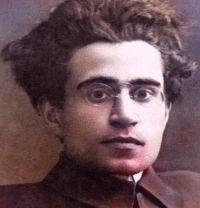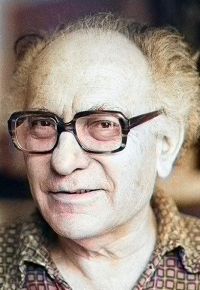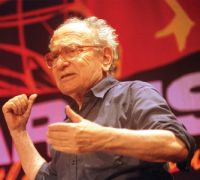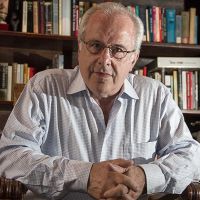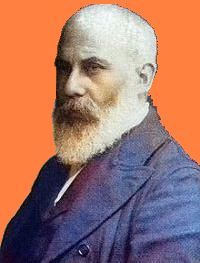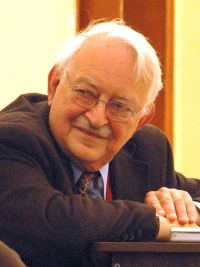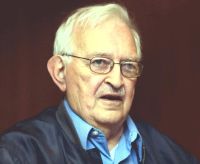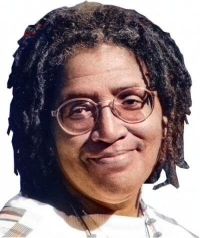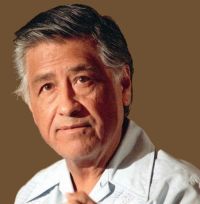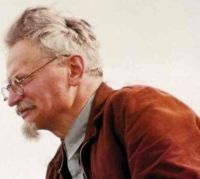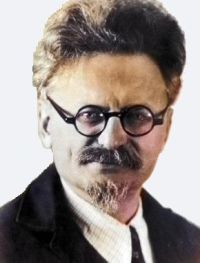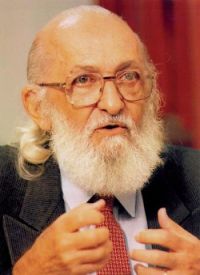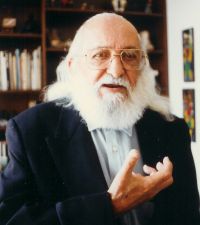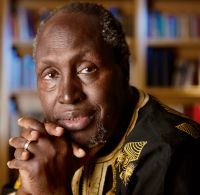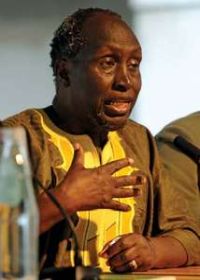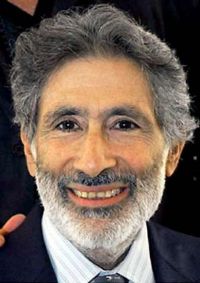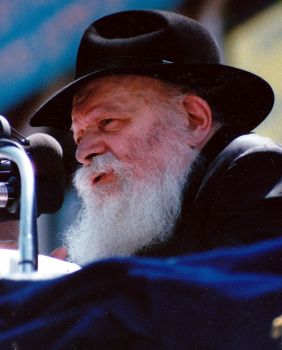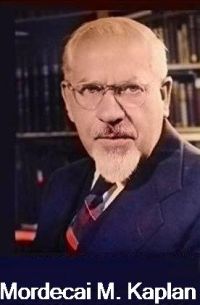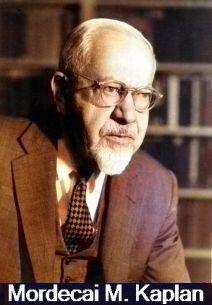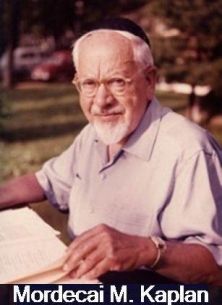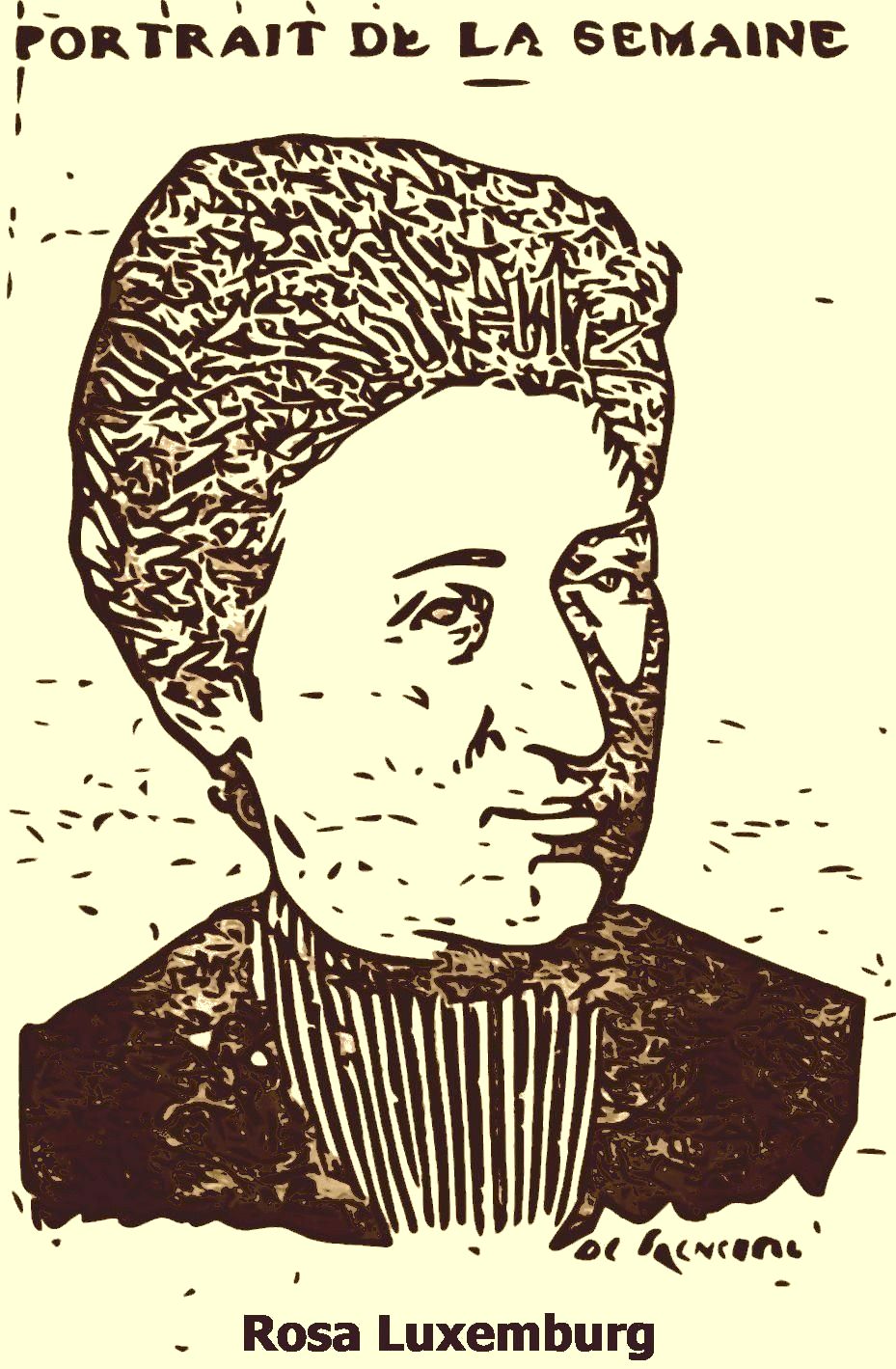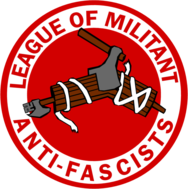











- Māḇōʾ hạ•Tạməṣiyṭiy
(Concise Introduction) - Nəṭiyyāh hạ•Qōmūniysəṭ,
wə•Tēʾōrəyūṯ hạ•Qəriyṭūṯ
hạ•Ḥẹḇərāṯiyūṯ
(Communist Tendency and
Critical Social Theories) - Yạhăḏūṯ, wə•Yəhūḏiy
hạ•Ḥillōniy
(Judaism and the
Secular Jew) - Dāṯ hạ•Bāhāʾiyṯ Bərẹsəlōḇiyṯ
(Breslover Bahá’í Faith) - Šôšẹlẹṯ Bərẹsəlôḇ–ʿẠkkô
(Dynasty of Breslov–Acre) - Rẹṣūʾūṯ hạ•Qōmiyqəs,
wə•hạ•Qạrəṭūniym,
wə•hạ•Qāriyqāṭūrūṯ šẹl
Rōzāh Lūqəsẹməbūrəg
(Comic Strips, Cartoons,
and Caricatures of
Rosa Luxemburg) - Hẹʿrōṭ lə•Siyyūm
(Concluding Remarks)
 א. Māḇōʾ hạ•Tạməṣiyṭiy
א. Māḇōʾ hạ•TạməṣiyṭiyA large number of the colorized photographs featured in this monograph were transformed from the original black and white or monochrome as a courtesy of the creative developers, Oli Callaghan and Finnian Anderson, behind this Twitter bot or, if not, by Algorithmia. I am also a member of the NationStates Commonwealth (see Discord chat). In this concise introduction (Hebrew/ʿIḇəriyṯ, מָבוֹא הַתַּמְצִיתִי [MP3], māḇôʾ hạ•tạməṣiyṭiy; or Arabic/ʿArabiyyaẗ, مُقَدَّمَة المُوجَزَة [MP3], muqaddamaẗ ʾal•mūǧazaẗ), the interested reader may get a sense of the following material.
Social fiction tackles significant issues using assorted entertainment media. From a social scientific perspective, the value of social fiction should not be underestimated. The subjects addressed, sometimes hidden in metaphor, can frequently be serious and consequential. Among these genres is online gaming. As with visual and performance art, such gaming can bring to the fore topics rarely set down in other lifeworlds (German/Deutsch, Lebenswelten [MP3]). Therefore, Šôšẹlẹṯ Bərẹsəlôḇ–ʿẠkkô of Democratic Communist Federation (Spartakusland)™ (MP3) is an allegory for The Dialectical metaRealist Communist Collective™ ([MP3]; ALCC). Methodologically, the agency of governing fictional nations will be examined using ethnography (participant observation) and twin modes of phenomenological analysis (MP3]): Heartfulness Inquiry™ and The Echoing Practice™.
This monograph is an odd historical novel. The society decribed in the novel and the status or position of the writer are fictitous, but the thoughts expressed in the text, and the personal experiences, are mostly genuine. Whether the perspectives have any value is for you to decide. I would never claim to be an authority on any subject. To be perfectly honest, I distrust anyone—aside from the Prophets of God and Their legitimate successors—who makes personal claims. The novel itself is an attempt at concrete utopianism. This interesting method or approach was originally conceived by German Marxist philosopher Ernst Bloch (MP3), 1885–1977. It was later developed by British Marxist philosopher and true libertarian communist Roy Bhaskar (MP3; Hindi, राम रॉय भास्कर [MP3], Rāma Rôya Bhāskara), 1944–2014. He transformed Marxism into a liberation from all absences.
Directly below, social fiction has been listed in a variety of languages using the traditional Hebrew numbering system:
- biḏəyəwôn hạ•ḥẹḇərāṯiy (Hebrew, בִּדְיְוֹן הַחֶבְרָתִי [MP3])
- ⫯adab ʾal•qaṣaṣiyy ʾal•ʾiǧ°timāʿiyy (Arabic, أَدَب القَصَصِيّ اِجْتِمَاعِيّ [MP3])
- dās°tāní•i ʾiǧ°timāʿí (Persian/Fār°sí, دَاسْتَانِیِ اِجْتِمَاعِی [MP3])
- doston•i iǧtimoī (Tajik/Toǧikī, достони иҷтимоӣ [MP3])
- samāǧí ʾaf°sānih (Urdu/ʾUr°dū, سَمَاجِی افْسَانِہ [MP3])
- samājika galapa (Guramukhi Punjabi/Guramukhī Pajābī, ਸਮਾਜਿਕ ਗਲਪ [MP3])
- samāǧika galapa (Shahmukhi Punjabi/Šāha Muḱ°hí Pan°ǧābí, سَمَاجِکَ گَلَپَ [MP3])
- samāǧī ʾaf°sān°wī (Sindhi/Sin°dʱī, سَمَاجِي افْسَانْوِي [MP3])
- ʾiǧ°timāʿí ʾaf°sānih (Pashto/Paṣ̌°tū/Pax̌°tū, اِجْتِمَاعِی افسَانِه [MP3])
Return to the Page Menu.
 ב. Nəṭiyyāh hạ•Qōmūniysəṭ,
ב. Nəṭiyyāh hạ•Qōmūniysəṭ,
wə•Tēʾōrəyūṯ hạ•Qəriyṭūṯ
hạ•Ḥẹḇərāṯiyūṯ
In this chapter, I shall discuss, only in their basic elements, my personal communist tendency and critical social theories (Hebrew, נְטִיָּה הַקוֹמוּנִיסְט, וְתֵּאוֹרְיוּת הַקְרִיטוּת הַחֶבְרָתִיוּת [MP3], nəṭiyyāh hạ•qômūniysəṭ, wə•tēʾōrəyūṯ hạ•qəriyṭūṯ hạ•ḥẹḇərāṯiyūṯ; or Arabic, اِتِّجاه الشُيُوعِيّ، وَنَظَرِيَّت الاِجْتِمَاعِيَّة النَقْدِيَّة [MP3], ʾittiǧah ʾal•šuyūʿiyy, wa•nazariyyaẗ ʾal•iǧ°timāʿiyyaẗ ʾal•naq°diyyaẗ) and, when taken as a whole, my more generalized heterodoxy (Hebrew, הֶטֶרוֹדּוֹקְסִי [MP3], hẹṭẹrôdōqəsiy; Arabic, اِبْتِدَاع [MP3], ʾib°tidāʿ; Persian, زَنْدَقِه [MP3], zan°daqih; Urdu, ہِجْرَت [MP3], hiǧ°rat; Guramukhi Punjabi, ਹੈਟਰੋਡੌਸੀ [MP3], haiṭarōḍausī; Shahmukhi Punjabi, ہَیٹَرُوڈَوسِی [MP3], haý°ṭarūḍaw°sí; Hindi/Hiṃdī, विधर्म [MP3], vidharma; or Bengali/Bāṅāli/Bānlā, বৈধর্ম্য [MP3], baidharmya), or holding to a contrary perspective from the norm. Freedom of thought is required by libertarian communism.
Šạbāṯ hạ•niṣəḥiyṯ ššālôm! (Hebrew, שַׁבָּת הַנִצְחִית שָּלוֹם!, “peace of the eternal Sabbath!”) Indeed, heterodoxy can be a valued trait so long as it is attended to by the equally valued trait, presented here multilingually, of engaging in correct action or, technically, orthopraxy:
- ʾôrəṯ′ôpərāqəsiy (Hebrew, אוֹרְת׳וֹפּרָקְסִי [MP3])
- sulūk ʾal•ṣaḥīḥ (Arabic, سُلُوك الصَحِيح [MP3])
- durus°t•i ḱar°dārí (Persian, دُرُسْتِ کَرْدَارِی [MP3])
- ʾur°tūp°raḱ°sí (Persian, اُرْتُوپْرَاکْسِی [MP3])
- amalho•i durust (Tajik, амалҳои дуруст [MP3])
- sim ʿamal (Pashto, سِم عَمَل [MP3])
- durus°ta ʿamala (Urdu, دُرُسْتَ عَمَلَ [MP3])
- ṣaḥīḥ ʿamal (Sindhi, صَحِيح عَمَل [MP3])
- sahī kāravāꞌī (Guramukhi Punjabi, ਸਹੀ ਕਾਰਵਾਈ [MP3])
- ṣaḥí ḱāravā⫯yí (Shahmukhi Punjabi, صَحِی کَارَوَائِی [MP3])
- sahī kārravāī (Hindi, सही कार्रवाई [MP3])
- saṭhika padakṣēpa (Bengali, সঠিক পদক্ষেপ [MP3])
The Left, as a diverse spectrum, should, I believe, be defined as communism or revolutionary socialism. Other left–of–center standpoints may be termed left–wing. Libertarian socialism, and the entire Left, can be situated into three broad, even if not mutually exclusive, rubrics. Overlaps could be pinpointed between perspectives within one category and those within the additional two. The three schools of the Left are Marxism, anarchism, and poststructuralism (a contested term). Marxism, including revolutionary syndicalism, centers upon Karl Marx (MP3), 1818–1883, and Friedrich Engels (MP3), 1820–1895. Anarchism, a fragmented tradition, lacks generally agreed–upon founders. The poststructural influences on communism, as seen in postautonomism and postanarchism, originated with Michel Foucault (MP3), 1926–1884; Jacques Derrida (MP3), 1930–2004; and others.
Click on the Libertarian Marxist Tendency Map to Enlarge
For left regroupment or unity, the vehicle driven, while traveling through many hazardous thoroughfares toward a new and unified Left, is the tendency, which was developed by the writer, of Antifa Luxemburgism™ (MP3). Since that tendency has already been considered in greater depth on a dedicated website, most of the discussions within this monograph will be fairly general and brief. Here are translations of the term, Antifa Luxemburgism, into fifteen languages:
- Hebrew, לוּקְסֶמְבּוּרְגִּיוּת הַאַנְטִיפָשִׁיסְטית (MP3), Lūqəsẹməbūrəgiyūṯ hạ•ʾạnəṭiyp̄āšiysəṭiyṯ.
- Arabic, لُوكْسِمْبُورْغِيَّة مُضَادّ الفَاشِيَّة (MP3), Lūk°sim°būr°ġiyyaẗ muḍādd ʾal•fāšiyyaẗ.
- Persian, لُوکْسِمْبُورْگِیَه ضِد فَاشِیَه (MP3), Lūḱ°sim°būr°giýah ḍid fāšiýah.
- Tajik, Люксембургизм зидди фашизм (MP3), Lyuksemburgizm ziddi fašizm.
- Pashto, دَ نَظَرَه دَ انْټِیفَا او لُوکْزَامْبُورْګ (MP3), Da Naẓarah da ʾAn°ṭífā ʾaw Lūḱ°zām°būr°ǵ.
- Urdu, لُوْكسِمْبُرْگِیَّتَ مُخَالِفَ ـ فَاشِیَّتَ (MP3), Lūk°sim°bur°giýýata muẖālifa–fāšiýýata.
- Bengali, বিরোধী–ফ্যাসিবাদী লুক্সেমবুর্গবাদ (MP3), birōdhī–phyāsibādī Luksēmaburgabāda.
- Hindi, फ़ासिस्ट–विरोधी लक्समबर्गवाद (MP3), fāsisṭa–virodhī Laksamabargavāda.
- Guramukhi Punjabi, ਵਿਰੋਧੀ–ਫਾਸ਼ੀਵਾਦੀ ਲਕੇਸਮਬਰਗਵਾਦ (MP3), virōdhī–phāsīvādī Luksēmaburagavāda.
- Shahmukhi Punjabi, وِرُودْهِی ـ فَاسِیوَادِی لُکْسَیمَبُرَگَوَادَ (MP3), virūd°hí–fāsívādí Luḱ°sēmaburagavāda.
- Malayalam/Malayaḷaṃ, ഫാസിസ്റ്റ്–വിരുദ്ധ ലുകസമബുരഗിസം (MP3), phāsisṟṟ–virudꞌdha Lukasamaburagisaṁ.
- Sinhalese/Siṁhala, ෆැසිස්ට්–විරෝධී ලක්ෂම්බර්ග්වාදය (MP3), fæsisṭ–virōdhī Lakṣambargvādaya.
- Turkish/Türk Dılı, zit–faşist Luxemburgizm (MP3).
- Modern Greek/Néa Ellēniká, αντιφασιστικό Λουξεμβούργμός (MP3), antiphasistikó Louxemboúrgmós.
- Sindhi, مُخَالِف ـ فَاشِسْٽ لُوڪْسِيمْبُورْگِزْم (MP3), muẖālif–fāšis°ʈ Lūk̀°sīm°būr°giz°m.
A “turn” (Hebrew, תַּפְנִית [MP3], tạp̄əniyṯ; Arabic, تَحَوُّل [MP3], taḥawwul; or Persian, نُوبَت [MP3], nūbat; Urdu, مَوْڑَ [MP3], maw°ṛa; Guramukhi Punjabi, ਮੋੜ [MP3], mōṛa; Shahmukhi Punjabi, مُوڑَ [MP3], mūṛa; or Tajik, хамгашт [MP3], ẖamgašt) is a commonly utilized academic term for a profoundly significant shift, or even an absolute transformation in some cases, to one’s mindset or worldview (German, Weltanschauung [MP3] or Weltansicht [MP3]). Many theoretical or philosophical turns fill my memory. I have, as a lifelong committed Leftist, made turns to a mélange (MP3) of communist tendencies or currents. Some of them, I must admit, were more personally beneficial, in the process of awakening my consciousness of capitalist intersectionality, than others. Still, throughout all these turns, I remained, for the most part, a left–libertarian or libertarian communist:
- the U.S. New Left’s left–libertarianism through the Students’ Democratic Coalition (1968–1969), open to secondary as well as to college and university students.
- Titoism (MP3; Serbian/Srpski, Титоизам [MP3], Titoizam; Hebrew, טִיטוֹאִית [MP3], Ṭiyṭôʾiyṯ; Hebrew, טִיטוֹאִיזְם [MP3], Ṭiyṭôʾiyzəm; Arabic, تِيتُوِيَّة [MP3], Tītuwiyyaẗ; Ṭiyṭōʾiyzəm; Persian, تِیتُوِیسْم [MP3], Títuwís°m; Urdu, ٹِیٹُوَنَے [MP3], Ṭíṭuwanē; Guramukhi Punjabi, ਟਿਟੋਵਾਦ [MP3], Ṭiṭōvāda; Shahmukhi Punjabi, ٹِٹُووَادَ [MP3], Ṭiṭōvāda; Sindhi, ٽَائْٽُوِزْم [MP3], Ʈā⫯y°ʈuwiz°m; Hindi, टीटोवाद [MP3], Ṭīṭovāda; or Bengali, টিটোবাদ [MP3], Ṭīṭōbāda).
- the post–Maoist (MP3) left–refoundational Maoism of Freedom Road Socialist Organization (Left Refoundation).
- the post–Trotskyist (MP3) Solidarity (U.S.) of left–refoundation and left–regroupment.
- the post–Maoist Third–World Maoism (Hebrew, מָאוֹאִיזְם בְּעוֹלָם הַשְׁלִישִׁי [MP3], Māʾôʾiyzəm bə•Ôlām hạ•Šəliyšiy; (Arabic, مَاوِيَّة مِن العَالَم الثَالِث [MP3], Mawiyyaẗ min ʾal•ʿĀlam ʾal•Ṯāliṯ; Persian, مَائُوئِیسْمِ جَهَان سِوُّم [MP3], Mā⫯ū⫯yís°m•i Ǧahān Sivvum; Urdu, تِیسْرَا دِنِیَا مَاؤُوِزْمَ [MP3], Tís°rā Diniyā Mā⫯wuwiz°ma; Guramukhi Punjabi, ਤੀਸਰਾ ਸੰਸਾਰ ਮੌਸਮ [MP3], Tīsarā Sasāra Mausama; Shahmukhi Punjabi, تِیسَرَا سَسَارَ مَوْسَمَ [MP3], Tísarā Sasāra Maw°sama; Mandarin Chinese, 第三世界的毛主义 [MP3], Dì•Sān•Shìjiè•de•Máo•Chǔyì; or Cantonese Chinese/Gwong2•Dung1•Waa6, 第三世界毛澤東思想 [MP3], Dai6•Saam1•Sai3•Gaai3•Mou4•Zaak6•Dung1•Si1•Soeng2). Given that my current views of this tendency are mostly on the negative side, my brief attraction to the current is, even for me, difficult to fully understand. I was, to be honest, drawn to Third–World Maoism out of empathy for the impact of Western capitalism and imperialism on developing or Third World countries. Still, I only “dabbled” in the tendency for about two or three weeks. As quickly as I accepted the current, I was turned off from it. In other words, I rejected the view that the global revolution must begin in the Third World. Contrary to the common thinking of Third–World Maoists, the dialectic is international. No one can predict where revolution will start. The U.S. itself is ripe for revolution. However, instead of a revolution, much of the socially alienated Proletariat chose a capitalist, Donald Trump. A common Third–World Maoist question is, Why has revolution not occurred in the West? Well, my response to the question is, Why has it not occurred anywhere? I obviously do not know whether Trump will be re–elected. However, in my view, he will remain president for as long as it takes to destroy the capitalist world–system, including the Empire or U.S.
- the post–Trotskyist international socialism (Hebrew, סוֹצְיָאלִיזְם הַבֵּינְלְאֻמִּי [MP3], sôṣəyāʾliyzəm hạ•bēynələʾumiy; Arabic, اِشْتِرَاكِيَّة الدَوْلِيَّة [MP3], ʾiš°tirākiyyaẗ ʾal•daw°liyyaẗ; Persian سُوسِیَالِیسْمِ بِینَالْمِلَلِی [MP3], sūsiýālís°m•i baýnāl°milalí; Urdu, بَیْنٍ اُلاقْوَامِی سُوسِهِلِزمَ [MP3], baý°na ʾul•ʾaq°wāmí sūsihiliz°ma; Guramukhi Punjabi, ਅੰਤਰਰਾਸ਼ਟਰੀ ਸਮਾਜਵਾਦ [MP3], atararāśaṭarī samājavāda; or Shahmukhi Punjabi, انْتَرَرَاشَٹَرِی سَمَاجَوَادَ [MP3], ʾan°tararāšaṭarí samaǧavāda) of International Socialist Tendency, Counterfire, International Socialist Network (IS Network), Socialist Solidarity (Canada), The International Socialist Organization (ISO), New Socialist Group, Socialist Alternative (Australia), rs21: revolutionary socialism in the 21ˢᵗ century, and Left Unity.
- the neo–Trotskyist (MP3) third–camp socialism (Hebrew, סוֹצְיָאלִיזְם שֶׁל הַמַחֲנֶה הַשְׁלִישִׁי [MP3], sôṣəyāʾliyzẹm šẹl hạ•mạḥănẹh hạ•šẹliyšiy; Arabic, اِشْتِرَاكِيَّة الثَالِثَة لِلمُخَيَّم [MP3], ʾiš°tirākiyyaẗ ʾal•ṯāliṯaẗ lil•muẖayyam; Persian, سُوسِیَالِیسْمِ سِوُّمِ ارْدُوگَاه [MP3], sūsiýālís°m•i sivvum•i ʾar°dūgāh; Urdu, تِیسْرِی چْھَاؤْنِی اجِتَمَاعیَاتَ [MP3], tír°sí č°hā⫯w°ní ʾaǧitamāʿýāta; Guramukhi Punjabi, ਤੀਜੇ ਡੇਰੇ ਸਮਾਜਵਾਦ [MP3], tījē ḍērē samājavāda; or Shahmukhi Punjabi, تِیجْے ڈَیرَے سَمَاجَوَادَ [MP3], tīǧē ḍērē samāǧavāda) of the Alliance for Workers’ Liberty. I remain a Trotskyist (really, post–Trotskyist and neo–Trotskyist), and my interest in Trotskyism (Hebrew, טְרוֹצְקִיִיזְם [MP3], Ṭərôṣəsəqiyiyzəm; Arabic, تْرُوتْسْكِيِيَّة [MP3], T°rūt°s°kiyiyyaẗ; Persian, تْرُوتْسْکِیِیسْم [MP3], T°rūt°s°ḱiýís°m; Urdu, ٹْرَاٹْسْکِیِزمَ [MP3], Ṭ°rāṭ°s°ḱiýíz°ma; Guramukhi Punjabi, ਟ੍ਰਾਟਸਕੀਵਾਦ [MP3], Ṭrāṭasakīvāda; Shahmukhi Punjabi, ٹ°رَاٹَسَکِیوَادَ [MP3], Ṭ°rāṭasaḱívāda; Hindi, ट्रॉट्रस्कीवाद [MP3], Ṭrôṭraskīvāda, ट्राटस्किवाद [MP3], Ṭrāṭaskivāda, or ट्रॉट्स्काइयिज़म [MP3], Ṭrôṭskāiyizama; Bengali, ট্রটস্কীবাদ [MP3], Ṭraṭaskībāda; or Malayalam, ട്രോട്സ്കിസം [MP3], Ṭrēāṭskisaṁ) has only intensified.
- nearly rebounding full circle to the third–camp Marxism, left–libertarian Luxemburgism (MP3), and left–libertarian Antifa (MP3) I so deeply cherish.
To conclude the basics, the prerequisite for left regroupment is left refoundation or renewal. Throughout my long life, each of the rubrics which will be considered in this chapter have, as refoundation, been combined into The Institute for Dialectical metaRealism™ (MP3), The Collective to Fight Neurelitism™ (MP3), and ALCC. My model of left refoundation is the Libertarian Communist Pentad™ (Hebrew, חֲמִישִׁיָּה שֶׁל הַקוֹמוּנִיזְם הַחֵרוּת [MP3], ḥămiyšiyāh šẹl hạ•qômūniyzəm hạ•ḥērūṯ) of Dialectical metaRealism™. Five perspectives, all revolving around Bhaskar’s critical realism, have been woven into a tapestry through this pentad of left–libertarian, or anti–authoritarian, communism:
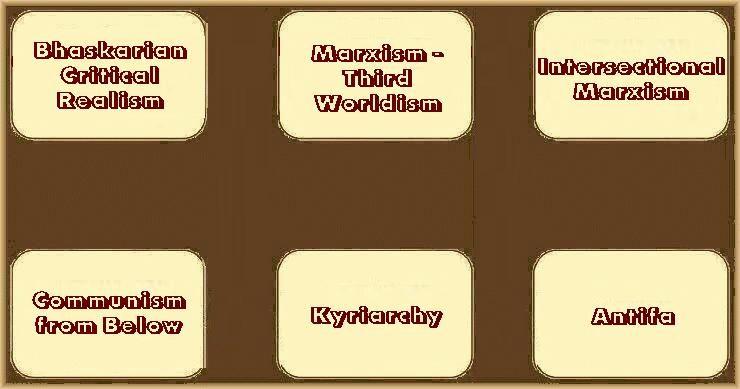
- ʾạḥəḏūṭ hạ•šẹmāʾliyṭ (Hebrew, אַחְדוּת הַשְׂמָאלִית [MP3]), “left regroupment or unity”
- wifāq ʾal•yasār (Arabic, وِفَاق اليَسَار [MP3]), “left regroupment or unity”
- ⫰iʿādaẗ ʾal•taǧ°mīʿ ʾal•yasār (Arabic, إِعَادَة التَجْمِيع اليَسَار [MP3]), “left regroupment or unity”
- vaḥ°dat•i čap (Persian, وَحْدَتِ چَپ [MP3]), “left regroupment or unity”
- yagonagi•i čap (Tajik, ягонагии чап [MP3]), “left regroupment or unity”
- bā⫯yiýṉ ʾittiḥāda (Urdu, بَائِیں اِتِْحَادَ [MP3]), “left regroupment or unity”
- khabē ēkatā (Guramukhi Punjabi, ਖੱਬੇ ਏਕਤਾ [MP3]), “left regroupment or unity”
- ḱ°habē ʾaý°ḱatā (Shahmukhi Punjabi, کْھَبَے ایْکَتَا [MP3]), “left regroupment or unity”
- ḥidūš hạ•šẹmōʾl (Hebrew, חִדּוּשׁ הַשְׂמֹאל [MP3]), “left refoundation or renewal”
- taǧ°dīd ʾal•yasār (Arabic, تَجْدِيد اليَسَار [MP3]), “left refoundation or renewal”
- ⫰iʿādaẗ ʾal•t⫯āsīs ʾal•yasār (Arabic, إِعَادَة التَأْسِيس اليَسَار [MP3]), “left refoundation or renewal”
- taǧ°díd•i čap (Persian, تَجْدِیدِ چَپ [MP3]), “left refoundation or renewal”
- navkunī•i čap (Tajik, навкунӣи чап [MP3]), “left refoundation or renewal”
- bā⫯yiýṉ taǧ°dída (Urdu, بَائِیں تَجْدِیدَ [MP3]), “left refoundation or renewal”
- khabē navīnīkarana (Guramukhi Punjabi, ਖੱਬੇ ਨਵੀਨੀਕਰਨ [MP3]), “left refoundation or renewal”
- ḱ°habē navíníḱarana (Shahmukhi Punjabi, کْھَبَے نَوِینِیکَرَنَ [MP3]), “left refoundation or renewal”
Borrowing a term used in my Master’s thesis from 1980, Increasing Complexity as a Process in Social Evolution: A Case Study of the Bahá’í Faith, capitalism is a complexification. Briefly, the name Dialectical metaRealism comes from Bhaskar’s work. The term is a portmanteau of his dialectical critical realism and his philosophy of metaReality. The result is a play on words or, if you prefer, a pun. Obviously, Dialectical metaRealism sounds a great deal like dialectical materialism. Practically speaking, Dialectical metaRealism, while lovingly and respectfully adopting Bhaskar’s work as its metatheoretical and methodological foundation, uses Antifa Luxemburgism, as developed by this writer, for its communist tendency. In addition, a wide variety of other critical social theories, many of them briefly discussed in this chapter, have been incorporated into Dialectical metaRealism.
In this Marxist–Luxemburgist (MP3) project of left refoundation, the pentad remains at the midpoint, and Bhaskarian critical realism has been positioned squarely at the center of the pentad. The project draws upon a multitude of critical frameworks and the activities of their scholars and practitioners. Of particular importance to the long–term process of formulating my perspective has been a continued personal phenomenological reflection on the work conducted by each of the individuals listed directly below, especially the dearly loved Rosa Luxemburg and the brilliant Roy Bhaskar:
- Rosa Luxemburg ([German; MP3]; Róża Luksemburg [Polish/Polski; MP3]; Róży Luksemburg [Polish; [MP3]; Rôzạh bạṯ ʾĔliyyāhū [Hebrew, רוֹזַה בַּת אֱלִיָּהוּ; MP3]; Rʾọsʾạ bạṯ ʾĔliyyāhū [Yiddish/Yiyḏiyš, ראָסאַ בַת אֱלִיָּהוּ; MP3]; Rūzaẗ ʾib°naẗ ⫰Iy°liyā [Arabic, رُوزَة اِبْنَة إِيْلِيَا; MP3]; Rūzā duẖ°tar•i ʾIl°ýās [Persian, رُوزَا دُخْتَرِ اِلْیَاس; MP3]; Roza duẖtar•i Ilyos [Tajik, Роза духтари Илёс; MP3]; ʾIý°laýāh ḱí Bēṭí ḱā Rūzā
[Urdu, اِیْلَیَا کِی بَیٹِی کَا رُوزَا; MP3]; Ēlīyāha dī dhī Rōzā [Guramukhi Punjabi, ਏਲੀਯਾਹ ਦੀ ਧੀ ਰੋਜ਼ਾ; MP3]; or ʾAý°líýāha, i.e., ʾĒ°līýāha, dí d°hí Rūzā [Shahmukhi Punjabi, اَیْلِییَاہَ دِی دْھِی رُوزَہ; MP3]), 1871–1919, is the central figure and saintly being of Spartakusland (MP3)—a common alias for the Federation and the name of its capital city—and The Antifa–Luxemburgist Communist Collective. Dear Rosa Luxemburg had the nickname of Red Rosa
 ([German, rote Rosa [MP3]; or Polish, rudy Rosa [MP3]). She was born to Eliasz (Polish for Elijah; MP3) and Liny (Polish; MP3) on March 5ᵗʰ, 1871, in Zamość (Polish [MP3]), Zāʾmŏʾšəṭəś (Yiddish, זָאמֳאשְׁטְשׂ [MP3]), or Zāmôšəṣ′ (Hebrew, זָמוֹשְׁץ׳ [MP3]), Poland (Polish, Polska [MP3]). Rosa was a naturalized German citizen, a libertarian Marxist, a proto–left communist, a doctor of law, and a nonobservant Jew. At only 48 years of age, she then became a secular martyr, after being assassinated by rifle, in Berlin, Germany, on January 15ᵗʰ, 1919. In that very same year, my Jewish father was born—eight months nine days later—on September 24ᵗʰ, 1919, in Brooklyn, New York. Since I was born on February 27ᵗʰ, 1956, Rosa was old enough to be my great grandmother and then some. However, setting that aside, as if she were my wedded wife, I am deeply in love with her. I have, by the same token, happily been a life–long bachelor.
Taking Rosa, the beloved heroine residing eternally in my heart, as exemplar, work heartily, with the spirit of genuine revolutionary fervor, for democratic libertarian communism. Rosa spent hours upon hours working through Capital and other works. She did not treat Marxist primary sources as verbally inerrant (Hebrew, מוּשְׁלָמוּת מִלּוּלִית [MP3], mūšəlāmūṯ millūliyṯ; or Arabic, مَعْصُوم لَفْظِيّاً [MP3], maʿ°ṣūm laf°ẓiyāṇ) or as manna (Hebrew, מָן [MP3], mān; Arabic, مَنّ [MP3], mann; or Common Greek/Hellēniká Koinḗ, μάννα [MP3], mánna, “what is it?”) from heaven. Instead, she approached these sources with the trained mind of a legal scholar. In point of fact, Rosa was one of the few women of her generation with an earned terminal German doctorate in law. That degree is generally considered as higher in prestige than the American Doctor of Jurisprudence (J.D.) degree. In 1963, the J.D. officially supplanted the Bachelor of Laws (LL.B.), which was, quite oddly using U.S. criteria, a second baccalaureate awarded after attaining the Bachelor of Arts (B.A.) or Bachelor of Science (B.S.). The German doctorate is seemingly on par, not with the J.D. or even with the intermediate American Master of Laws (LL.M.) degree, but with the advanced U.S. Doctor of Juridical Science (S.J.D.) degree. In order to truly appreciate, indeed grapple with, Marxist theory, it must be approached using the educated intellect of one such as Rosa, the glorious light of my life. Marxism, it should go without saying, is neither a prearranged set of Aristotelian first principles (Hebrew, עִקָּרוֹנוּת הַרִאשׁוֹנִים שֶׁל אֲרִיסְטוֹ [MP3], ʿiqqārônūṯ hạ•riʾšôniym šẹl Ăriysəṭô, or Arabic, مَبادِئ أَرِسْطُوطَالِيسِيّ الأُوْلَى [MP3], mabad⫯ī ⫯Aris°ṭūṭālīsiyy ʾal•uw°aỳ) nor merely a formal conglomeration of Kantian postulates (Hebrew, הֲנָחוֹת קַנְטְיָאנִיוּת [MP3], hănāḥôṯ Qạnəṭəyāʾniyūṯ; or Arabic, مُسَلَّمَات كَانْطِيَّة [MP3], musallamāt Kān°ṭiyyaẗ). No, contrary to popular understandings, Marxism is a brilliantly conceived methodology for a full self–realization and collective emancipation from the capitalist world–system (Hebrew, מַעֲרֶכֶת שֶׁל הַעוֹלָמִית הַקָפִּיטָלִיסְטִית [MP3], mạʿărẹḵẹṯ šẹl hạ•ʿôlāmiyṯ hạ•qāpiṭāliysəṯ; or Arabic, نِظَام العَالَمِيّ الرَأْسْمَالِيّ [MP3], nn⫯īẓām ʾal•ʿālamiyy ʾal•r⫯ās°maliyy). Rosa was originally pro–Bolshevik (Russian, на–большевик [MP3], na–Bolʹševik), but she jumped ship after she recognized that the former Soviet Union was becoming an autocracy. As you can see, in the topmost row, the middle and right–hand photos were both apparently taken at the same sitting. You may also click on any of the photographs below to enlarge them:
([German, rote Rosa [MP3]; or Polish, rudy Rosa [MP3]). She was born to Eliasz (Polish for Elijah; MP3) and Liny (Polish; MP3) on March 5ᵗʰ, 1871, in Zamość (Polish [MP3]), Zāʾmŏʾšəṭəś (Yiddish, זָאמֳאשְׁטְשׂ [MP3]), or Zāmôšəṣ′ (Hebrew, זָמוֹשְׁץ׳ [MP3]), Poland (Polish, Polska [MP3]). Rosa was a naturalized German citizen, a libertarian Marxist, a proto–left communist, a doctor of law, and a nonobservant Jew. At only 48 years of age, she then became a secular martyr, after being assassinated by rifle, in Berlin, Germany, on January 15ᵗʰ, 1919. In that very same year, my Jewish father was born—eight months nine days later—on September 24ᵗʰ, 1919, in Brooklyn, New York. Since I was born on February 27ᵗʰ, 1956, Rosa was old enough to be my great grandmother and then some. However, setting that aside, as if she were my wedded wife, I am deeply in love with her. I have, by the same token, happily been a life–long bachelor.
Taking Rosa, the beloved heroine residing eternally in my heart, as exemplar, work heartily, with the spirit of genuine revolutionary fervor, for democratic libertarian communism. Rosa spent hours upon hours working through Capital and other works. She did not treat Marxist primary sources as verbally inerrant (Hebrew, מוּשְׁלָמוּת מִלּוּלִית [MP3], mūšəlāmūṯ millūliyṯ; or Arabic, مَعْصُوم لَفْظِيّاً [MP3], maʿ°ṣūm laf°ẓiyāṇ) or as manna (Hebrew, מָן [MP3], mān; Arabic, مَنّ [MP3], mann; or Common Greek/Hellēniká Koinḗ, μάννα [MP3], mánna, “what is it?”) from heaven. Instead, she approached these sources with the trained mind of a legal scholar. In point of fact, Rosa was one of the few women of her generation with an earned terminal German doctorate in law. That degree is generally considered as higher in prestige than the American Doctor of Jurisprudence (J.D.) degree. In 1963, the J.D. officially supplanted the Bachelor of Laws (LL.B.), which was, quite oddly using U.S. criteria, a second baccalaureate awarded after attaining the Bachelor of Arts (B.A.) or Bachelor of Science (B.S.). The German doctorate is seemingly on par, not with the J.D. or even with the intermediate American Master of Laws (LL.M.) degree, but with the advanced U.S. Doctor of Juridical Science (S.J.D.) degree. In order to truly appreciate, indeed grapple with, Marxist theory, it must be approached using the educated intellect of one such as Rosa, the glorious light of my life. Marxism, it should go without saying, is neither a prearranged set of Aristotelian first principles (Hebrew, עִקָּרוֹנוּת הַרִאשׁוֹנִים שֶׁל אֲרִיסְטוֹ [MP3], ʿiqqārônūṯ hạ•riʾšôniym šẹl Ăriysəṭô, or Arabic, مَبادِئ أَرِسْطُوطَالِيسِيّ الأُوْلَى [MP3], mabad⫯ī ⫯Aris°ṭūṭālīsiyy ʾal•uw°aỳ) nor merely a formal conglomeration of Kantian postulates (Hebrew, הֲנָחוֹת קַנְטְיָאנִיוּת [MP3], hănāḥôṯ Qạnəṭəyāʾniyūṯ; or Arabic, مُسَلَّمَات كَانْطِيَّة [MP3], musallamāt Kān°ṭiyyaẗ). No, contrary to popular understandings, Marxism is a brilliantly conceived methodology for a full self–realization and collective emancipation from the capitalist world–system (Hebrew, מַעֲרֶכֶת שֶׁל הַעוֹלָמִית הַקָפִּיטָלִיסְטִית [MP3], mạʿărẹḵẹṯ šẹl hạ•ʿôlāmiyṯ hạ•qāpiṭāliysəṯ; or Arabic, نِظَام العَالَمِيّ الرَأْسْمَالِيّ [MP3], nn⫯īẓām ʾal•ʿālamiyy ʾal•r⫯ās°maliyy). Rosa was originally pro–Bolshevik (Russian, на–большевик [MP3], na–Bolʹševik), but she jumped ship after she recognized that the former Soviet Union was becoming an autocracy. As you can see, in the topmost row, the middle and right–hand photos were both apparently taken at the same sitting. You may also click on any of the photographs below to enlarge them: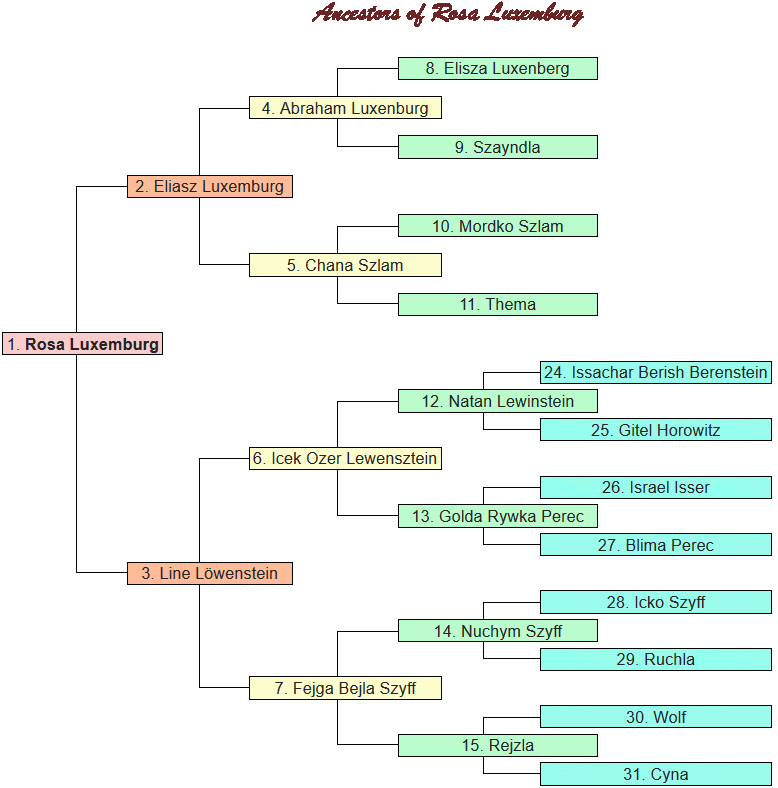
- Roy Bhaskar (Hindi, राम रॉय भास्कर [MP3], Rāma Rôya Bhāskara), the founder of Bhaskarian critical realism (MP3), developed the underlying metatheory which has been incorporated into this work. In addition, critical realism is a social scientific and philosophical methodology, like all critical theories, for liberating, or emancipating, the individual and, in the specific case of critical realism, for unshackling the planet through libertarian Marxist communism. The objective of critical realism is to absent, or eliminate, all the dialectical absences, such as capitalism and racism, and all of the demireality, or disunity in difference (“dualism”). Replacing these many absences and the realm of demireality, nonduality or advaita (Sanskrit/Saṃskrtam, अद्वैत [MP3]), copresence, the cosmic envelope, or the ground state would flourish. Those are among the major elements of Roy’s Marxist left–libertarianism (Hebrew, לִיבֶּרְטַרְיָנִיזְם הַשְׂמֹאלָנִי [MP3], liybẹrəṭarəyāniyzəm hạ•śəmōʾlāniy; Arabic, اليَسَار مِن لِيبِرْتَارِيَّة [MP3], ʾal•yasār min lībir°tāriyyaẗ; Persian, لِیبِرتَارِیِ گِرَایِیِ چَپ [MP3], líbir°tārí•i girāyí•i čap; Urdu, بَائِیَں آزَادِی [MP3], bā⫯yí ʾâzādí; Guramukhi Punjabi, ਖੱਬੇ ਆਜ਼ਾਦੀਵਾਦ [MP3], khabē āzādīvāda; Shahmukhi Punjabi, کْھبَےَ آزَادِیوَادَ [MP3], ḱ°habē ʾâzādīvāda; Hindi, वाम स्वतंत्रतावाद [MP3], vāma svataṃtratāvāda; or Bengali, বাম উদারনীতিবাদ [MP3], bāma udāranītibāda), and they also provide a vivid illustration of critical realism’s nearly complete incompatibility with Amerocentric so–called right–libertarianism. Bhaskar’s critical realism, through all of his turns (or stages of thinking), are, in effect, brilliant expressions of his developing understandings of rejecting the dialectical absences or demireality of the capitalist system and, through the transformational model of social activity, enabling the dialectical metamorphosis or the copresence of a libertarian communism. He found, in these turns, enhanced ways of expressing many of the same fundamental principles. Transcendental dialectical critical realism—a minor and short–lived turn (2000–2002) which began Bhaskar’s generalized “spiritual turn” and prefaced his final turn—apparently obtained its name from his personal involvement with Transcendental Meditation™. That movement, popularized by the Beatles, was initiated by India’s Maharishi Mahesh Yogi (Hindi, महर्षि महेश योगी [MP3], Maharṣi Maheśa Yogī), 1918–2008. His birth name is unclear. It may have Maheśa Prasāda Varmā (Hindi, महेश प्रसाद वर्मा [MP3]), Maheśa Caṃdra Śrīvāstava (Hindi, महेश चंद्र श्रीवास्तव [MP3]), or some other variation. Moreover, based upon my own original research into Bhaskar’s final turn and the culmination of his overall spiritual turn, the philosophy of metaReality, it was seemingly quite strongly influenced by universal realism. Formulated by India’s Sri Aurobindo (Bengali, শ্রী অরবিন্দ [MP3], Śrī Arabinda; or Hindi, श्री अरविन्द [MP3], Śrī Aravinda), né Aurobindo Ghose (Bengali, অরবিন্দ ঘোষ [MP3], Arabinda Ghōṣa; or rendered into Hindi, अरविंद घोष [MP3], Araviṃda Ghoṣa), 1872–1950, universal realism is discussed in in Book II of Aurobindo’s The Life Divine (see also Book I) and his The Synthesis of Yoga:
In India the philosophy of world–negation has been given formulations of supreme power and value by two of the greatest of her thinkers, Buddha [Sanskrit and Pāli, बुद्ध; MP3, Buddha; Mandarin Chinese/Zhōngguó•Guānhuà, 佛; MP3, Fú; Japanese/Nihongo, 仏; MP3, Futsu; or Korean/Chosŏnmal/Han’gugŏ, 불; MP3, Pul] and Shankara [Sanskrit, शंकर; MP3, Śaṃkara; or शङ्कर; MP3, Śaṅkara] .… The spirit of these two remarkable spiritual philosophies—for Shankara in the historical process of India’s philosophical mind takes up, completes and replaces Buddha,—has weighed with a tremendous power on her thought, religion and general mentality: everywhere broods its mighty shadow, everywhere is the impress of the three great formulas, the chain of Karma [Sanskrit, कर्म; MP3], escape from the wheel of rebirth, Maya [Sanskrit, माया MP3, māyā]. It is necessary therefore to look afresh at the Idea or Truth behind the negation of cosmic existence and to consider, however briefly, what is the value of its main formulations or suggestions, on what reality they stand, how far they are imperative to the reason or to experience. For the present it will be enough to throw a regard on the principal ideas which are grouped around the conception of the great cosmic Illusion, Maya, and to set against them those that are proper to our own line of thought and vision; for both proceed from the conception of the One Reality, but one line leads to a universal Illusionism, the other to a universal Realism,—an unreal or real-unreal universe reposing on a transcendent Reality or a real universe reposing on a Reality at once universal and transcendent or absolute.Sri Aurobindo. The Life Divine. Book II. Pondicherry, India: Sri Aurobindo Ashram Publication Department. 2005. Pages 431–432.Already even in the realised higher–mind being and in the intuitive and overmind being the body will have become sufficiently conscious to respond to the influence of the Idea and the Will–Force so that the action of mind on the physical parts, which is rudimentary, chaotic and mostly involuntary in us, will have developed a considerable potency: but in the supramental being it is the consciousness with the Real–Idea in it which will govern everything. This real–idea is a truth-perception which is self-effective; for it is the idea and will of the spirit in direct action and originates a movement of the substance of being which must inevitably effectuate itself in state and act of being. It is this dynamic irresistible spiritual realism of the Truth–consciousness in the highest degree of itself that will have here grown conscient and consciously competent in the evolved gnostic being: it will not act as now, veiled in an apparent inconscience and self–limited by law of mechanism, but as the sovereign Reality in self-effectuating action. It is this that will rule the existence with an entire knowledge and power and include in its rule the functioning and action of the body.Sri Aurobindo. The Life Divine. Book II. Pondicherry, India: Sri Aurobindo Ashram Publication Department. 2005. Page 1021.In practice three conceptions are necessary before there can be any possibility of Yoga [Sanskrit, योग; MP3]; there must be, as it were, three consenting parties to the effort,—God, Nature and the human soul or, in more abstract language, the Transcendental, the Universal and the Individual. If the individual and Nature are left to themselves, the one is bound to the other and unable to exceed appreciably her lingering march. Something transcendent is needed, free from her and greater, which will act upon us and her, attracting us upward to Itself and securing from her by good grace or by force her consent to the individual ascension.Sri Aurobindo. The Synthesis of Yoga. Pondicherry, India: Sri Aurobindo Ashram Publication Department. 1999. Pages 31–32.By referring to the logic of the Infinite, Sri Aurobindo did not introduce any new element. He reconnected to a central thread that he had been gradually building right from the start. Along with Supermind (the executive agent of the logic of the Infinite), this was the backbone of his “universal Realism.” Its framework allowed him to tackle the problems of human existence from a new perspective. Instead of grappling with the theory of cosmic Illusion, he could now ask what made us “misconceive” or “misapprehend” the Real without denying reality to universal or individual existence.Marcel Kvassay, “Sri Aurobindo’s ‘Universal Realism’ and the Doctrine of Cosmic Illusion.” AntiMatters. Volume 3, number 4, 2009. Pages 83-96.Aurobindo, in his The Life Divine, declares that he has moved from Śaṅkara’s “universal illusionism” to his own “universal realism” …, defined as metaphysical realism in the European philosophical sense of the term.… Aurobindo contends that the great yogī [Sanskrit, योगी; MP3] had a “philosophy of world-negation.”Nicholas F. Gier, Overreaching to be Different: A Critique of Rajiv Malhotra’s Being Different. International Journal of Hindu Studies. Volume 16, number 3, December 2013. Pages 259–285.Whereas the Advaitists [Hindi, अद्वैत के शिष्य; MP3, Advaita ke Śiṣya] and some Buddhists [Mandarin Chinese, 佛陀的门徒; MP3, fútuó•de•méntú; Japanese, 仏陀の弟子たち; MP3, butsuda•no•deshi•tachi; or Hindi, बौद्धों; MP3, Bauddhoṃ] arrived at “a universal Illusionism,” Aurobindo reached “a universal Realism … a real universe reposing on a Reality at once universal and transcendent or absolute.” Totality is real from top to bottom, from pure being to matter. The various planes of being are, as it were, a ladder plunging down from the heights of an absolute supracosmic spirit into lowest matter―perhaps even into planes below matter, although Aurobindo usually assumes that matter is the lowest manifestation of Brahman [Sanskrit, ब्रह्मन्; MP3]. Aurobindo leaves open the possibility of planes of being higher than pure existence, pure consciousness, and pure delight of being, although, again, he usually assumes that these three exhaust the planes of higher being.Troy Wilson Organ, “The Status of the Self in Aurobindo’s Metaphysics: And Some Questions.” Philosophy East and West. Volume 12, number 2, July 1962. 135–151.Click on the photos below for enlargements:
- Antonio Gramsci (Italian/Italiano [MP3]) lived 1891–1937. Although Antifa Autonomism (MP3) or the Autonomist Antifa Movement (MP3) has no clear founder, Gramsci, a courageous political prisoner in Fascist Italy, was certainly a seminal figure. He was an Italian Marxist, a dedicated antifascist, the developer of the theory of cultural hegemony (Hebrew, תֵּאוֹרִית הַהֶגְמוֹנִית הַתַּרְבּוּתִית [MP3], tēʾôriyṯ hạ•hẹḡəmôniyṯ hạ•tạrəbūṯiyṯ; Arabic, نَّظَرِيَّة الهَيْمَنَة الثَقَافِيَّة [MP3], nnazariyyaẗ ʾal•hay°manaẗ ʾal•ṯaqāfiyyaẗ; Persian, تِئُورِیِ هِژِمُونِیِ فَرْهَنْگِی [MP3], t⫯iýuwrí•i hiz°ẖimūní•i far°han°gí; Urdu, ثَقَافَتِی مَحَاصِرْہ کَا نَظَرِیَہ [MP3], ṯaqāfatí maḥāsir°h nazariýah; Guramukhi Punjabi, ਸੱਭਿਆਚਾਰਕ ਸ਼ਾਸਨ ਦੇ ਸਿਧਾਂਤ [MP3], sabhiꞌācāraka śāsana dē sidhānta; or Shahmukhi Punjabi, سَبْھِیَاچَارَکَ شَاسَنَ دَے سِدْھَانْتَ [MP3], sab°hiyāčāraka šāsana dē sid°hān°ta) and the individual who had popularized the term subaltern (MP3; Hebrew, כְּפִיפוּת [MP3], kəp̄iyp̄ūṯ; Arabic, مَرْءُوس [MP3], mar°ˁūs; Persian, اطَاعَت [MP3], ʾaṭāʿat; Urdu, مَاتَحَتَ [MP3], mātaḥata; Guramukhi Punjabi, ਸਬਾਲਟਰਨ [MP3], sabālaṭarana; or Shahmukhi Punhabi, سَبَالَٹَرَن [MP3], sabālaṭarana)―a word redefined by Gramsci for the other, the powerless, or the socially marginalized peoples of the world. Literally speaking, the term, subaltern, refers to secondary. Autonomism (Hebrew, אוֹטוֹנוֹמְיָה [MP3], ʾôṭônōməyāh; Arabic, اِسْتِقْلَالِيَّة الذَاتِيَّة [MP3], ʾis°tiq°lāliyyaẗ ʾal•ḏātiyyaẗ; Persian, خُودْمُخْتَارِی [MP3], ẖūd°muẖ°tārí; Tajik, мухторият [MP3], muẖtoriyat; Urdu, خُودْمُخْتَارِی [MP3], ẖūd°muẖ°tārí; Guramukhi Punjabi, ਆਟੋਨੋਮਿਜ਼ਮ [MP3], āṭōnōmizama; Shahmukhi Punjabi, آٹُونُومِزَمَ [MP3], ʾâṭūnūmizama; or Hindi, स्वायत्तता [MP3], svāyattatā) is an anti–authoritarian and, therefore, an anti–fascist communsm. You may click on each of the images below to enlarge it:
- Hal Draper (1914–1990), born Harold Dubinsky, was among the founders and intellectuals of the early neo–Trotskyist current, third–camp socialism. As a noteworthy aside, Polish American Max Shachtman (Polish, Maks Shakhtman [MP3]), 1904–1972, was also one of the first masterminds behind third–camp socialism. He eventually abandoned his current, leaving the work to his former comrades, and became a social democratic union organizer. Draper himself, a libertarian and heterodox neo–Trotskyist, is credited with coining the term socialism from below (Hebrew, סוֹצְיָאלִיזְם מִלְמַטָה [MP3], sôṣəyāʾliyzẹm mi•ləmạṭāh; Arabic, اِشْتِرَاكِيَّة مِن الأَسْفَل [MP3], ʾiš°tirākiyyaẗ min ʾal•⫯as°fal; Persian, سُوسِیَالِیسْم از پَایِین [MP3], sūsiýālís°m ʾaz paýín; Urdu, ذَیْلَ مَیْں اجِتَمَاعیَاتَ [MP3], ḏaý°la maý°ṉ ʾaǧitamāʿýāta; Guramukhi Punjabi, ਤਲ ਤੋਂ ਸਮਾਜਵਾਦ) [MP3], tala tōṁ samājavāda; or Shahmukhi Punjabi, تَلَ تُوں سَمَاجَڤَادَ [MP3], tala tūṉ samāǧavāda). Other like–minded individuals, coming from a cross–section of Leftist tendencies, have utilized the concept in a similar fashion. Included among them are: Amrit Wilson, Orlando Chirino (MP3), Wayne Price, Dan Swain, Lucien van der Walt (MP3), and Michael Schmidt (MP3). Socialism from below must, by the sheer definition of the phrase, be juxtaposed with the socialism from above (Hebrew, סוֹצְיָאלִיזְם מִלְמַעְלָה [MP3], sôṣəyāʾliyzẹm mi•ləmạʿəlāh; Arabic, اِشْتِرَاكِيَّة مِن الأَعْلَى [MP3], ʾiš°tirākiyyaẗ min ʾal•⫯aʿ°laỳ; Persian, سُوسِیَالِیسْم از بَالَا [MP3], sūsiýālís°m ʾaz bālā; Urdu, اُوْپَرَ سَے اجِتَمَاعیَاتَ [MP3], ʾuw°para sē ʾaǧitamāʿýāta; Guramukhi Punjabi, ਚੋਟੀ ਤੋਂ ਸਮਾਜਵਾਦ, cōṭī tōṁ samājavāda [MP3]; or Shahmukhi Punjabi, چُوْٹِی تُوں سَمَاجَڤَادَ [MP3], čūṭí tūṉ samāǧavāda) which, simultaneously, monopolized and wreaked havoc upon the 20ᵗʰ century. Alliance for Workers’ Liberty, ZCommunications, Center for Economic Research and Social Change (which publishes the International Socialist Review), International Organization for a Participatory Society, International Socialist Organization, and New Politics comprise a cursory selection of organizations and publications that have expressed their advocacy for a libertarian socialism from below. The following is a compilation of quotations on that subject:
… the tendency [Max] Shachtman founded continued, and a group of his co–thinkers (including [Hal] Draper, Phyllis and Julius Jacobson, Herman Benson, and others) continued to develop “third camp” politics as a heteredox, broadly–libertarian Trotskyism which emphasised working–class independence and democracy. The third campists had an attitude on the “party question” which no doubt also offends Workers Power’s sensitivities, emphasising debate and dissent, and the rediscovery of the classical–Bolshevik view that internal disagreements should be argued through as publicly as possible, rather than compelling members to lie about their opinions in public. That is indeed the tradition with which Workers’ Liberty identifies. Identifying with the political tradition Max Shachtman helped develop in no way compels us to apologise for choices he made later on. Against the Shachtman of the mid–1950s, we side with Draper, the Jacobsons, and others, who continued in revolutionary politics until the end of their lives.Ira Berkovic, “A note on ‘(neo–)Shachtmanism.’” Workers’ Liberty: Reason in Revolt. The Alliance for Workers’ Liberty. 2017. No pagination.… the following pages propose to investigate the meaning of socialism historically, in a new way. There have always been different ‘kinds of socialism,’ and they have customarily been divided into reformist or revolutionary, peaceful or violent, democratic or authoritarian. etc. These divisions exist, but the underlying division is something else. Throughout the history of socialist movements and ideas, the fundamental divide is between Socialism–From–Above and Socialism–From–Below.What unites the many different forms of Socialism–from–Above is the conception that socialism (or a reasonable facsimile thereof) must be handed down to the grateful masses in one form or another, by a ruling elite which is not subject to their control in fact. The heart of Socialism–from–Below is its view that socialism can be realized only through the self–emancipation of activized masses in motion, reaching out for freedom with their own hands, mobilized from below” in a struggle to take charge of their own destiny, as actors (not merely subjects) on the stage of history. “The emancipation of the working classes must be conquered by the working classes themselves”: this is the first sentence in the Rules written for the First International by [Karl] Marx, and this is the First Principle of his life–work.Hal Draper. The Two Souls Of Socialism. Revised edition. Berkeley, California: Independent Socialist Committee—A Center for Socialist Education. 1966. Pages 3–4.… in the second half of the nineteenth century, “socialist” came to signify not merely concern with “the social question,” but opposition to capitalism and support for some variety of social ownership of the means of production. So, while never abandoning the term “communist,” [Karl] Marx and [Friedrich] Engels also became quite happy to call themselves socialists. What is most distinctive about the kind of socialism that they supported, however, is that it can only be created through the active participation of workers themselves. The American Marxist Hal Draper called this conception “socialism from below” and contrasted it with various varieties of “socialism from above” .… Historically, most versions of self-described socialism—including both Stalinism and social democracy—have been varieties of “socialism from above,” which from [Karl] Marx and [Friedrich] Engels’ perspective was not genuine socialism at all.Utopianism was elitist and anti democratic to the core because it was utopian—that is, it looked to the prescription of a prefabricated model, the dreaming–up of a plan to be willed into What unites the many different forms of Socialism–from–Above is the conception that socialism (or a reasonable facsimile thereof) must be handed down to the grateful masses in one form or another, by a ruling elite which is not subject to their control in fact. The heart of Socialism–from–Below is its view that socialism can be realized only through the self-emancipation of activized masses in motion, reaching out for freedom with their own hands, mobilized from below” in a struggle to take charge of their own destiny, as actors (not merely subjects) on the stage of history. “The emancipation of the working classes must be conquered by the working classes themselves”: this is the first sentence in the Rules written for the First International by [Karl] Marx, and this is the First Principle of his life–work.Hal Draper. The Two Souls Of Socialism. Revised edition. Berkeley, California: Independent Socialist Committee—A Center for Socialist Education. 1966. Pages 8–9.[Karl] Marx and [Friedrich] Engels also became quite happy to call themselves socialists. What is most distinctive about the kind of socialism that they supported, however, is that it can only be created through the active participation of workers themselves. The American Marxist Hal Draper called this conception “socialism from below” and contrasted it with various varieties of “socialism from above,” in which an elite imposes change on a passive working class. Historically, most versions of self-described socialism—including both Stalinism and social democracy—have been varieties of “socialism from above,” which from Marx and Engels’ perspective was not genuine socialism at all.Phil Gasper, “Reviving socialism from below: Capitalism’s biggest crisis since the 1930s raises the question of what can replace it.” International Socialist Review. Issue 65, May 2009. No pagination.Socialist and democratic developed from below through a gradual and often slow process of education and discussion. In this way, land was redistributed to women and people of previously oppressed groups who never before had a right to this means of survival. Oppressive feudal marriage laws were changed to give women more power.Amrit Wilson, “Socialism from below.” New Statesman & Society. Volume 4, number 154, June 1991. Page 10.… [An] important issue is the role of social classes in this revolution. You don’t have to refer to [Karl] Marx, [Friedrich] Engels, [Vladimir] Lenin, or [Leon] Trotsky to know that the only way to overturn capitalism, a system in which a minority imposes its will on the majority, is that the working class and the people, we who are the majority and the producers, take the lead in expropriating the enterprises and place them under our control. In that sense, what we mean by socialism is very simply stated.Orlando Chirino, “Venezuela’s PSUV and Socialism from Below: Interview with Orlando Chirino.” New Politics. Volume 11, number 4, winter 2008. Pages 17–22.The dominant trend in socialist thought during this period, then, was a new variant of socialism from above. The struggle of working class people to create new institutions of popular democratic control was seen as having little or nothing to do with the creation of a socialist society. Instead, elected socialist officials would simply take over the existing bureaucratic structures of society and run them more humanely. Rather than a qualitatively different society, socialism was depicted as a gently improved form of the existing social order. Yet, despite the wide influence of this doctrine, some Marxists remained committed to the idea of socialism from below. The most important of these was the Polish revolutionary Rosa Luxemburg.…… [The] upsurge in militant working class activity powerfully influenced the thinking of some radical writers and organisers. A few of them began to think of the working class as the group that could change society. Indeed, some theorists began to talk in terms of the working class liberating itself through its collective action. Notable in this regard was the French revolutionary Flora Tristan, who linked together ideas of working class self-emancipation and women’s liberation with the proposal for a world-wide organisation of workers. But it was in the writings and the organising of a German socialist, Karl Marx, that the working class took centre stage in socialist thought. Inspired by the emergence of this class, [Karl] Marx developed a wholly new socialist outlook based upon the principle of socialism from below.David McNally. Socialism from Below. Chicago, Illinois: International Socialist Organization. 1986. Ebook edition.Today … state–Communism has been relatively discredited with the fall of the Soviet Union and the turn of the Chinese state to open capitalism. As a consequence, the concept of socialism-from-below has become widely attractive to many radicals. However, the concept of socialism–from–below, at least as raised by [Hal] Draper and by [David] McNally (at least until his most recent book), has been used ambiguously. Contrary to the views of the anarchists, these writers claim that Marxism is most consistent with revolutionary socialism–from–below, and that anarchism is an example of authoritarian socialism. I will argue instead that the divide between authoritarian and libertarian–democratic tendencies runs through (inside) Marxism as well as through anarchism. However, I believe that, while there is value in Marxism, overall, anarchism is most consistent with the development of a liberating socialism–from–below.Wayne Price, “Socialism from Above or Below.” The Utopian. Volume 3, 2002. Pages 75–85.]I have been an anarchist–pacifist (influenced by Paul Goodman and Douglas Macdonald), a Trotskyist (a variety of Marxist), and am now an socialist–anarchist of the class struggle, pro–organization (“Platformist”), trend. I identify with the revolutionary tradition of anarchist–communism. Through all these incarnations, I have remained a libertarian socialist and a believer in socialism–from–below.Wayne Price. The Abolition of the State: Anarchist & Marxist Perspectives. Bloomington, Indiana: AuthorHouse. 2007. Page 8.I remain an anarchist, a decentralist socialist, and a believer is socialism–from–below. As a class struggle, Platformist, revolutionary anarchist, I can have all the benefits I sought as a Trotskyist, while maintaining the libertarian vision of anarchism. I no longer advocate a “workers’ state” (whatever that means), but I do advocate a federation of workers’ and popular councils (in the tradition of the Friends of Durruti Group of the Spanish revolution). I no longer advocate a vanguard (Leninist) party, which aims to rule over the workers, but I do advocate a revolutionary organization of anachist workers: Platformism or especificismo. (These topics are discussed in essays in this book as well as in my book, The Abolition of the State: Anarchist and Marxist Perspectives.) While I no longer call myself a Marxist, I accept many ideas from the Marxist tradition (as can be seen from my essays) This is especially true from the libertarian Marxists (such as C.L.R. James, the council communists, etc.). I now regard myself as a Marxist–informed anarchist. I have joined the Northeastern Federation of Anarchist–Communists (or NEFAC) and write for the www.Anarkismo.net site, which is the web site for our international tendency.Wayne Price. What I Believe and How I Came to Believe It. Berkeley, California: The Anarchist Library imprint of Open Guild Organization. 2008. Page 6.If socialism is just about taking control of the existing state, it is understandable that many are suspicious of it. But socialism from below implies a different approach. It argues that the institutions of the state are structured in a way that denies popular control. Alongside the formally ‘democratic’ pieces of the state – where those exist – are a series of hierarchically organised bodies, the police, army, judiciary, civil service etc., that limit the space for democracy. These are a block on the possibility of extending democratic control in society. These institutions must be removed and replaced.…If socialism from below is to mean anything today, it is as a guiding thread that runs through our political practice, one that constantly reminds us to ask whether and how what we do empowers people to become agents of their own emancipation. To achieve this truly would be ‘doing politics differently’ – differently from the capitalist parties, broken social democracy, and, sadly, so many revolutionary groups that have gone before. The devil, as ever, is in the detail; but no one said it was going to be easy.Dan Swain, “Socialism from Below.” New Politics. July 17ᵗʰ, 2015. Online publication. No pagination.… [One] arena where socialism from below matters is the question of democracy. There has historically been, and to a certain extent there still is, a way of talking about socialism as being concerned first and foremost with material comfort and a more equal distribution of wealth and resources. To the extent that democracy fits into this it is often as an optional extra, a “good thing,” but not strictly part of the picture. Socialism from below rejects this, and re-asserts democracy as an integral part of socialism. Socialism from below follows from a commitment to democracy in socialism in the following way: If your goal is just material comfort, or a better distribution of resources, you don’t need mass participation. You don’t need to involve, engage and mobilize a movement. Or rather, you do, but only temporarily, only in order to back up demands and policies, put pressure on those in power. If, on the other hand, your goal is a society in which the overwhelming majority are capable of participating in the running of society, you have to be concerned with empowering them to do so, and this empowerment requires a level of democracy.Dan Swain, “Socialism still comes from below.” Socialist Worker. July 16ᵗʰ, 2015. Online publication. No pagination.The common idea – ‘socialism from below’ – is … widely shared.The Socialist Workers Party, in spite of its own obviously Stalinist internal regime, also subscribes to that idea, and its Greek co-thinkers use the tag as the title of their bimonthly journal.…I have said that the SWP [Socialist Workers Party] subscribes to ‘socialism from below’ in spite of its own obviously Stalinist internal regime, but in fact it is arguable that such a regime follows from the conception of ‘socialism from below’ as interpreted by the SWP, by its co-thinkers and its ex-members.Mike Macnair, “Socialism from below: a delusion.” Weekly Worker. Issue 1071, August 2015. Online publication. No pagination.We [the New Left] also challenged the prevailing view that the so-called affluent society would of itself erode the appeal of socialist propaganda—that socialism could arise only out of immiseration and degradation. Our emphasis on people taking action for themselves, “building socialism from below” and “in the here and now,” not waiting for some abstract Revolution to transform everything in the twinkling of an eye, proved, in the light of the re-emergence of these themes after 1968, strikingly prefigurative.Stuart Hall, “Life and Times of the First New Left.” New Left Review. Series II, number 61, January–February 2010. Pages 177–196.… I will analyze the ways in which the themes in my conception of socialism–from–below appear (or are ignored) in analyses of the Occupy movement. By examining its key discussions, I intend to situate Occupy within the Infrastructure of Dissent and [Rosa] Luxemburg’s theories on social transformation through mass mobilization. By situating Occupy within these theories, I will offer a refreshed look at the opportunities and obstacles facing leftist struggle in our time, in order to gain a better grasp upon how mass movements might bring us closer to realizing a society of socialism–from–below.Holly Campbell. Building Socialism From Below: Luxemburg, Sears, And The Case Of Occupy Wall Street. Major research paper for Master’s in Social Justice and Community Engagement. Wilfrid Laurier University. Brantford, Ontario. 2014. Page 34.The Challenge: Defining a Socialism from Below …The crippling contradiction at the heart of Bolshevism lies between its central defining images of modernity and its socialist politics and culture. The former entail a theory of productive forces and of the economic superiority of capitalist methods; the latter calls for increasingly conscious, collective, and egalitarian self–assertion from below. The contradiction is an antagonistic one: to choose either horn of the dilemma is to undercut the basis of the other. Bolshevism certainly broke the automatic link between level of productive forces and socialist revolution.Philip Corrigan, Harvie Ramsay, and Derek Sayer, “Bolshevism and the USSR.” New Left Review. Series I, number 125, January–February 1981. Pages 45–60.For anarchists, individual freedom is the highest good, and individuality is valuable in itself, but such freedom can only be achieved within and through a new type of society. Contending that a class system prevents the full development of individuality, anarchists advocate class struggle from below to create a better world. In this ideal new order, individual freedom will be harmonised with communal obligations through cooperation, democratic decision-making, and social and economic equality. Anarchism rejects the state as a centralised structure of domination and an instrument of class rule, not simply because it constrains the individual or because anarchists dislike regulations. On the contrary, anarchists believe rights arise from the fulfilment of obligations to society and that there is a place for a certain amount of legitimate coercive power, if derived from collective and democratic decision-making.Lucien van der Walt and Michael Schmidt, “Socialism from Below: Defining Anarchism,” in Lucien van der Walt and Michael Schmidt. Black Flame: The Revolutionary Class Politics of Anarchism and Syndicalism. Oakland, California: AK Press. 2009. Pages 33–82.Perhaps surprisingly, he [Hal Draper] excludes anarchism from the camp of socialism from below. Its affirmation of absolute individual liberty logically leads to the right of individuals to impose their own tyranny on others, even on the majority. ‘It is the other side of the coin of bureaucratic despotism, with all its values turned inside–out, not the cure or the alternative.’ His argument is based on the founders of theoretical anarchism, and he undoubtedly has a case as he dissects their writings. [Pierre–Joseph] Proudhon, in particular, was a convinced sexist and racist, an opponent of trade unions, and a cheerleader for dictators when he wasn’t eying up their position for himself.Aindrias Ó Cathasaigh, “Hal Draper, The Two Souls of Socialism.” Red Banner. Volume 48, June 2012. Pages 1–4.Before the October Revolution, [Vladmir] Lenin saw “workers’ control” purely in terms of “universal, all-embracing workers’ control over the capitalists.” He did not see it in terms of workers’ management of production itself (i.e. the abolition of wage labour) via federations of factory committees. Anarchists and the workers’ factory committees did. On three occasions in the first months of Soviet power, the factory committees sought to bring their model into being. At each point the party leadership overruled them. The Bolshevik alternative was to vest both managerial and control powers in organs of the state which were subordinate to the central authorities, and formed by them. Workers’ management from below was not an option. Lenin himself quickly supported “one–man management” invested with “dictatorial powers” after “control over the capitalists” failed in early 1918. By 1920, [Leon] Trotsky was advocating the “militarisation of labour” and implemented his ideas on the railway workers.Anonymous. The Anarchist Alternative to Leninism: Socialism from Below? Berkeley, California: Anarchist Zine Library imprint of Open Guild Organization. 2001. (From a leaflet distributed at “Marxism 2001” in London, one of the annual conferences coordinated by the British Marxist–Leninist–Trotskyist organization, the Socialist Workers Party.) No pagination.In the case of co–management [in Venezuela], this also can be due to diverging understandings and expectations. While workers usually see it as an intermediate step toward workers’ control and the construction of a new socialism from below, many officials see it more as a mechanism for reducing conflict at work and improving the processes, thus taking advantage of the labour force’s subjectivity without allowing it true participation. This experience has also been repeated in the creation of the Socialist Workers’ Councils (CST) in state enterprises and institutions since 2008. The deeper the process of change and/or popular mobilisation, the greater the contradictions. Conflicts over comanagement and problems in its practice emerged especially in the firms taken over and expropriated, and in state enterprises where there was a worker initiative for more workers’ participation or control. The first two businesses to be expropriated – the paper factory Invepal and the valve factory Inveval, both of which had been taken by the workers – exemplify this situation, as does the case of the state aluminium smelter Alcasa.Dario Azzellini. Communes and Workers’ Control in Venezuela: Building 21ˢᵗ Century Socialism from Below. Ned Sublette, translator. Leiden, the Netherlands, and Boston, Massachusetts: Leiden. 2017. Page 174.The traditional Left continues to hamstring itself with fantasies of salvific sweeps, a position that derides everything beyond mass action as insufficient or reformist. The claim that “socialism in one city is impossible” may or may not be worth talking about at one level, but at another it is exactly the all–or–nothing acid that dissolves radical thinking and action, and at still another level is just plain untrue. Just as the construction of a new solidarity economy has to be built piecemeal from the ruins of late capitalism, so too might emerge a commonwealth, with some old, some new, some repurposed elements, from workplace to workplace, neighborhood to neighborhood.Socialism, or any other rendition of radically egalitarian and/or utopian social relations, will wax and wane, swell and subside, be fought over and defended, built and rebuilt. If we perceive the commonwealth as an artifactualized thing that we either have or we don’t, then we’re doomed to an endless loop of disappointment and recrimination. The commons, or a socialism from below, or a radically democratic pluralistic altermodernity, or whatever, has to be understood not as a secular-socialist heaven, but as a horizon that keeps bending at the edges, a build-the-road-as-we-travel ongoing act of emergence.Matt Hern. A What a City Is For: Remaking the Politics of Displacement. Cambridge, Massachusetts: The MIT Press. 2016. Ebook edition.In his youth, [Karl] Polanyi had been fleetingly attracted to anarchism and varieties of socialism “from below,” but in the bearpit of Russia’s socialist factions he backed those who maintained that socialism could only be achieved following a lengthy stage of capitalism against those who supposed that a global socialist transformation could begin on Russian soil, and his post-1917 trajectory was via guild socialism toward social democracy, a comparatively patrician current that in several respects – notably its advocacy of nationalism and state-led social engineering – resembled the new edition of communism that was emerging in late 1920s Russia. For Polanyi, socialism was defined by two principal claims. One was for workers’ control of production. This would have precluded him from defining [Joseph] Stalin’s Russia as socialist were it not for his propensity to conflate the labour movement with what he held to be its political organisations. Thus, he justified his acceptance of the CPSU [Communist Party of the Soviet Union] as a representative of Russian labour by the assumption that it was devoted to the “democratic control of industry.” The other claim was that a socialist economy is by definition geared to “the maximum development of the means of production” combined with a socially just distribution of the product. In Russia, the Five-Year Plans were visibly producing “the enrichment” of Soviet territory, and, with some creative accounting and a willingness to disbelieve journalistic reports of gaping class divisions, the “just distribution” criterion appeared to be met too. Consequently, Polanyi could marvel at the achievements of Soviet Russia, including industrialisation and collectivisation. Although these led to “severe suffering for the masses,” he justified this in terms of the putative intention – to ameliorate poverty – and the “spectacular” and “admirable growth rate” that they enabled. They had, he maintained, proved ‒the possibility of socialist economics on a large scale,– and, paradoxical though this sounds, had also demonstrated the unassailable truth of marginalist economics. The evidence was there for the world to see: “Russia, which ten years ago was of no account as an industrialised country, ranks now amongst the very first. Socialism has been established in one country.” Though temporarily restricted to one country, Stalin’s regime cast a bright light on the future of humanity as a whole.Gareth Dale. Reconstructing Karl Polanyi: Excavation and Critique. London: Pluto Press. 2016. Pages 82–83.Photographs of Draper are immediately below. Those on the left and the right were, apparently, both taken at the same venue. The second row of pictures—including the one on the left which was colorized by me—are of Shachtman. Click on any of them for enlargements:
- Kimberlé Williams Crenshaw (born 1959), a brilliant American law professor at both Columbia University and University of California at Los Angeles (UCLA), developed intersectionality or intersectional theory (MP3; Hebrew, תֵּאוֹרְיוּת הַהִצְטַלְּבוּת [MP3], tēʾôrəyūṯ hạ•hiṣəṭạlləḇūṯ; Arabic, نَظَرِيَّة التَقَاطُعَات [MP3], naẓariyyaẗ ʾal•taqāṭuʿāt; Persian, نَظَرِیَهِ مُتْقَاطع [MP3], naẓariýah•i mut°qaṭʿ; Urdu, اِنْتِبَاہَ نَظَرِیَہَ [MP3], ʾin°tibaha naẓariýýaha; Guramukhi Punjabi, ਇੰਟਰਸੈਕਸ਼ਨਾਂ ਦੇ ਥਿਊਰੀ [MP3], iṭarasaikaśanāṁ dē thiꞌūrī; or Shahmukhi Punjabi, اِنٹَرَسِیکَسَنَاں دَے تھِیُورِی [MP3], ʾin°ṭarasíḱasanaṉ dē t°hiýūrí). Using the metaphor of intersections on a roadmap, she presents a multidimensional approach to domination. Rather than treating oppression as a tangible, oppression is considered relationally and contextually. A person might occupy the status of an oppressor in one structure and the status of an oppressed person in another. In effect, intersectionality demonstrates the complex contradictions in the capitalist system. Crenshaw’s theory expands capitalist studies beyond a narrow and simplistic economism, or economic determinism, to include diverse substructures of modernity. In both cases, the amplification is clear from the perspectival designations themselves. If capitalism is correctly regarded as intersecting traffic flowing from multiple directions—a dynamic elucidation of communist internationalism—perhaps merely delineating an economy, or even a political economy, would offer an insufficient portrayal of reality. If, on the other hand, capitalism is an intersection—like a prison cell, a roadmap, a spider’s web, or a birdcage—then capitalism must be approached multidimensionally, not as a two–dimensional flatland. Due to the contradictions of capitalism, one may experience power, privilege, wealth, and prestige in certain areas of life, yet not in others. For example, I lived in Southern Appalachia for four years―Wise, Virginia. It is a poor, dying coal mining area. Yes, it is poor; and yes, it is mostly white. However, it is poor because of a lack of good–paying jobs. It is mostly white because that part of the South did not have plantations. Continuing poverty does not attract new people, including minorities, to move in. That is the value of intersectional theory. Yes, they are white. Yes, they are in a poor region. They are poor because of their region, not because they are white. Race has no direct relation to their poverty. Southern Appalachia and the Mississippi Delta are the two poorest regions of the U.S. but for different historical reasons. Click on any of the pictures below for an enlargement:
- Patricia Hill Collins, born in 1948, is “Distinguished University Professor Emerita” at the University of Maryland. She was, in addition, the first African American woman to be honored with the presidency of the American Sociological Association in 2009. Collins introduced Kimberlé Williams Crenshaw’s intersectionality into the field of sociology. In the process, Collins inevitably added her own original modifications to this critical theory, including the matrix of domination (Hebrew, מַטְרִיצָה שֶׁל הַשְׁלִיטָה [MP3], mạṭəriyṣāh šẹl hạ•šəliyṭāh; Arabic, مَصْفُوفَة الهَيْمَنَة [MP3], maṣ°fūtaẗ ʾal•hay°manaẗ; Persian, مَاتْرِیکْسِ سُلْطَه [MP3], māt°ríḱ°s•i sul°ṭah; Urdu, تَسَلُّط کَا مَیٹْرِکْس [MP3], tasalluṭ ḱā mēṭ°riḱ°s; Guramukhi Punjabi, ਜ਼ੁਲਮ ਦੇ ਸਰੋਤ [MP3], zulama dē sarōta; or Shahmukhi Punjabi, زُلَمَ دَی سَرُوتَ [MP3], zulama dē sarūta)—the sources of oppression—and the two–stage methodology of, first, shifting the center of one’s thinking to the socially marginalized or “the other” and, second, reconstructing knowledge based upon having shifted the center. Her qualitative sociological research method can be regarded as a unique approach to feminist standpoint epistemology (Hebrew, אֶפִּיסְטֶמוֹלוֹגְיָה הַבְּחִינָה הַפֶמִינִיסְט [MP3], ʾẹpiysəṭẹmôlōḡəyāh hạ•bəḥiynāh hạ•p̄ẹmiyniyiysəṭ; Arabic, نِسْوِيَّة المَعْرِفَة الوُجْهَة [MP3], nis°wiyyaẗ ʾal•maʿ°rifaẗ ʾal•wuǧ°haẗ; Persian, مَعْرِفَتِ شَنَاسِیِ دِیدْگَاهِ فِمِینِیسْتِی [MP3], maʿ°rifat•i šanāsí•i díd°gāh•i fimínís°tí; Urdu, نَسَائِی نُقْطَہ نَظَرَ عِلمَ کِی اصَلَ [MP3], nasā⫯yí nuq°ṭah naẓara ʾilma ḱí ʾaṣala; Guramukhi Punjabi, ਨਾਰੀਵਾਦੀ ਦ੍ਰਿਸ਼ਟੀਕੋਣ ਗਿਆਨ [MP3], nārīvādī driśaṭīkōṇa giꞌāna; or Shahmukhi Punjabi, نَارِیوَادِی دْرِشَٹِیکُونَ گِیَانَ [MP3], nārívādí d°rišaṭíḱūna giýāna) or, more broadly, to standpoint epistemology in general. It is a recognition that an awareness of oppression varies according to one’s relational perspective. Indeed, intersectional theory commonly includes standpoint epistemology, but the reverse is not as frequently the case. I once, just as an aside, served on a panel at a sociological conference with Collins. Please click on any of the three images below for enlargements:
- Stateless British resident Tony Cliff (1917–2000) was born in Palestine (Arabic, فِلَسْطِين [MP3], Filas°ṭīn; Hebrew, פָּלֶשְׂתִּינָה [MP3], Pālẹśətiynāh; Persian, فِلَسْطِین [MP3], Filas°ṭín; Urdu, فِلَسْطِینَ [MP3], Filas°ṭína; Shahmukhi Punjabi, فَلَسَتِينَ [MP3], Falasatína; or Guramukhi Punjabi, ਫਲਸਤੀਨ [MP3], Phalasatīna) three decades before the establishment of Israel (Hebrew, יִשְׂרָאֵל [MP3], Yiśərāʾēl; Arabic, إِسْرَائِيل [MP3], ⫰Is°rā⫯yīl; Persian, اِسْرَائِيل [MP3], ʾIs°rā⫯yíl; or Urdu, اِسْرَائِيلَ [MP3], ʾIs°rā⫯yíla; Shahmukhi Punjabi, عِزَرَائِیلَ [MP3], ʿIzarā⫯yíla; or Garumukhi Punjabi, ਇਜ਼ਰਾਈਲ [MP3], Izarāꞌīla) by the United Nations. He developed a post–Trotskyist tendency called international socialism. Cliff’s birth name was Yigael Gluckstein or Ygael Gluckstein (Hebrew, יִגְאָל גְּלוּקְשְׁטָיִין [MP3], Yiḡəʾāl Gəlūqəšəṭāyiyn; my Arabization/taʿrībuṇ (Arabic, تَعْرِيْبٌ [MP3]), يِيجْأَل غْلُوْكْشْطَايّْن [MP3], Yīġ⫯āl Ġ°lūk°š°ṭāyy°n; or my Persianization/Fār°sí•i šudan/(Persian, فَارْسِیِ شُدَن [MP3]), یِیگأَل گْلُوکْشْْطَایّْن [MP3], Ýíg⫯āl G°lūḱ°š°ṭāýý°n). Unfortunately, Cliff, who referred to himself as a Luxemburgist for quite some time, suddenly abandoned that label. Some of his members, annoyed at him over this issue, continued referring to themselves by that designation. Cliff, moreover, popularized the term, “state capitalism,” when referring to the former Soviet Union. Nevertheless, the issue, while perhaps of historical interest, is, in terms of current affairs, irrelevant. Mainland China has become an authoritarian capitalist state, while the Russian Federation is a right–wing crony capitalist state. You may click on each of the below photos for an enlargement:
- American Richard D. Wolff’s (born 1942) proposes workers’ self–directed coöperative enterprises (Hebrew, מִפְעָלִי שִׁתּוּף פְּעֻלָּה שֶׁל הַעוֹבֵדִים [MP3], mip̄əʿāliy šitūp̄ pəʿullāh šẹl hạ•ʿôḇēḏiym; or Arabic, مُؤَسَّسَات المُتَعَاوِنَة الذَاتِيَّة المُوَجَّهَة لِلعُمَّال [MP3], m⫯uwassāt ʾal•mutaʿāwinaẗ ʾal•ḏātiyyaẗ ʾal•muwaǧǧahaẗ lil•ʿummāl). On the other hand, I was disappointed when, in 2016, he supported the presidential candidacy of a social democrat, U.S. Senator Bernie Sanders, and repeatedly referred to him, erroneously by standard academic criteria, as a socialist. Why would a communist do that? Although completely irrelevant to the subject at hand, to quote Yul Brenner’s character in the disturbingly Americocentric movie, The King and I, Wolff’s campaigning, or effective campaigning, for Sanders was, from my perspective, a “puzzlement.” Sanders did more harm to socialism than the most rabid right–winger. Due to his popularity, I only refer to myself as a communist these days, never as a socialist. Meanwhile, a generation of social democrats now defines itself as socialist. Click on any of Wolff’s pictures for enlargements:
- Titoism is the aggressive and, indeed, courageous response to Stalinism ( Hebrew, סְטָלִינִיזְם [MP3], Səṭāliyniyzəm; or Arabic, سْتَالِينِيَّة [MP3], S°tāliniyyaẗ) by Yugloslav Marshal Josip Broz Tito (Serbian/Srpski, Маршал Јосип Броз Тито [MP3], Maršal J̌osip Broz Tito), 1892–1980. Although once a Titoist, I am no longer a proponent of market socialism, including Tito’s version, in general. Nevertheless, I still admire Tito’s dedication to building worker coöperatives. In my opinion, Tito came more proximate to the Marxist first stage of communism than any other head of state in the 20ᵗʰ century. Click on each of the pictures below for an enlargement:
- De Leonism (MP3), created by U.S. pre–Bolshevik (Russian/Rossiâne, пред-Большевик [MP3], pred–Bolʹševik) activist Daniel De Leon (MP3), 1852–1914, is a sensible (and libertarian Marxist) approach to syndicalism (MP3). Click on any of De Leon’s three pictures for enlargements:
- Immanuel Wallerstein (MP3), born in 1930, was the originator of world–systems analysis (Hebrew, נִתּוּחַ הַמַעֲרֶכוּת שֶׁל הַעוֹלָם [MP3], nitūhạ hạ•mạʿărẹḵūṯ šẹl hạ•ʿôlām; Arabic, تَحْلِيل مِن الأَنْظِمَة العَالَمِيَّة [MP3], taḥ°līl min ʾal•⫯an°ẓimaẗ ʾal•ʿālamiyyaẗ; Persian, تَجْزِیِه وَ تَحْلِیلِ سِیسْتِمِ هَایِ جَهَانِی [MP3], taǧ°ziýih va taḥ°líl•i sís°tim•i hāý•i ǧahāní; Urdu, عَالَمِی نِظَامَ تَجزِیِہ [MP3], ʿālamí niẓāma taǧ°ziýih; Guramukhi Punjabi, ਵਿਸ਼ਵ ਪ੍ਰਣਾਲੀ ਵਿਸ਼ਲੇਸ਼ਣ [MP3], viśava praṇālī viśalēśaṇa; or Shahmukhi Punjabi, وِشَوَ پْرَنَالِی وِشَلَیشَنَ [MP3], višava p°ranālí višalēšana). I have found conceiving of capitalism as a world–system to be extremely helpful in my work. Capitalism is a global, not only a national, political economy. You may click on any of the below images for an enlargement:
- The virtuous and courgeous Audre Lorde (1934–1992), pen name of Audrey Geraldine Lorde, famously wrote, “The true focus of revolutionary change is never merely the oppressive situations we week to escape, but that piece of the oppressor which is implanted deep within each of us.” Lorde helped many of us to appreciate her deep understandings of false consciousness and class consciousness. Click on any of the three images to enlarge it:
- Cesar Chavez (Spanish/Español, César Chávez [MP3]), 1927–1993, substantially introduced me to the New Left, in 1968, through his leadership of the United Farm Workers of America. I distributed petitions, along with other members of the Students’s Democratic Coalition, for people to sign pledges to boycott California grapes, in solidarity with the Mexican migrant workers. As we distributed the petitions to willing supermarket shoppers, an unknown man came by and copied down all of our names. Not knowing any better, being just twelve years old, I politely gave him my name. Obviously, I should have simply declined, but the thought never even occurred to me. Somewhere, buried in a file, there is most likely a record in Washington, D.C., of my activism that day. Click on any of the pictures for an enlargement:
- Leon Trotsky (Russian, Лео́н Тро́цкий, León Tróckij [MP3]), born Lev Davidovich Bronstein (Russian, Лев Давидович Бронштейн [MP3], Lev Davidovič Bronštejn), lived 1879–1940. Through the work of Tony Cliff and Max Shachtman, Trotsky gave a heart to my communism, and, after abandoning Titoism, I became a Trotskyist in two distinct flavors: First, Tony Cliff’s International Socialism and, then later, Hal Draper’s libertarian version of Third–Camp Socialism. By the same token, while recognizing that Lev was waging a war, I was, to be blunt, not a big fan of his authoritarianism. They, admittedly, mellowed while traveling within the United States and, later, in exile in Mexico. Trotsky appears to have moved in a more libertarian direction, including with his informality and apparent egalitarianism. Moreover, during his North American travels, he was on the run for his life. Trotsky was subsequently assassinated in Mexico. The weapon of choice was a simple icepick. It, obviously, left no fingerprints, and DNA testing was, sadly, not yet available. Substantively, Trotsky’s astute analysis of American racism corresponds with mainstream sociological usage. He brilliantly utilized the example of the Southern plantation system. Trotsky certainly had his rhetoric on an international revolution to spread communism. Joseph Stalin (Georgian/Kartuli Ena, იოსებ სტალინი [MP3], Ioseb Stʼalini; or Russian, Иосиф Сталин [MP3], Iosif Stalin) had his own rhetoric, too, but he never carried out what he claimed in advance. Rhetoric, no matter how eloquent, is not a good predictor of social action. You can never know what a politician will do until they are in power. Rosa Luxemburg discerningly critiqued Lev’s authoritarian methods as well as his formulaic approach to communism. In the visionary world of dreams, Red Rosa knocked at the door of my heart. I was prepared for her. Click on any of the three pictures of Trotsky below for enlargements:
- Paulo Freire (Portugese/Português [MP3]), 1921–1997, a Portugese–speaking Brazilian educator, formulated critical pedagogy (MP3; Hebrew, פֶּדָגוֹגְית הַבִּקָּרְתִּית [MP3], pẹḏāḡôḡəyṯ hạ•biqqārətiyṯ; or Arabic, عِلْمُ التَرْبِيَة النَقْدِيَّة [MP3], ʿil°mu ʾal•tar°biyaẗ ʾal•naq°diyyaẗ), which I use, as best I am able, in my classes. According to Freire, the educational process, through critical pedagogy, needs to impart the emancipatory power of conscientization (MP3). This English–language rendering of the originally Portuguese term, conscientização (MP3), was employed by Paulo Freire for class consciousness. Conscientization, which requires self–consciousness (Hebrew, תּוֹדָעָה שֶׁל הַעַצְמִית [MP3], tôḏāʾāh šẹl hạ•ʿạṣəmiyṯ; or Arabic, وَعْي الذَاتِيّ [MP3], waʿ°y ʾal•ḏātiyy), was the epistemic basis for the consciousness raising of the women’s liberation movement in the 1970s. I have translated conscientization as discernment (Hebrew, הַבְחָנָה [MP3], hạḇəḥānāh; Arabic, بَصِيرَة [MP3], baṣīraẗ; Persian, دَرْک [MP3], dar°ḱ; Sindhi, سَمَجْھَڻ [MP3], samaǧ°han; Urdu, سَمَجْھَدَارَ [MP3], samaǧ°hadāra; Guramukhi Punjabi, ਸਮਝ [MP3], samajha; or Shahmukhi Punjabi, سَمَجْهَ [MP3], samaǧ°ha). Freire’s coined term, conscientização, was based upon the French/Français word conscience (MP3). Unlike its English–language cognate, the French noun, conscience, can be accurately translated as either “conscience” or “consciousness.” I have selected wisdom (Hebrew, חָכְמָה [MP3], ḥọḵəmāh; Arabic, حِكْمَة [MP3], ḥik°maẗ; Persian, حَکْمَت [MP3], ḥiḱ°mat; Sindhi, حِڪْمَت [MP3], ḥik̀°mat; Urdu, دَانَائِی [MP3], dānā⫯yí; Guramukhi Punjabi, ਸਿਆਣਪ [MP3], siꞌāṇapa; or Shahmukhi Punjabi, سِیَانَپَ [MP3], siýānapa) as a rough translation of the French, conscience. You may click on any of the pictures below for an enlargement:
- Ngũgĩ wa Thiong’o (Kikuyu [MP3]), born in 1938, is a Kenyan writer who popularized the term decolonising the mind in his 1986 prison diary, Decolonising the Mind: The Politics of Language in African Literature. Click on any of the three pictures below to enlarge it:
- Frantz Fanon (French [MP3]), 1921–1997, was a brilliant Algerian psychiatrist and revolutionary. Most importantly, for our purposes, he was one of the principal founders of postcolonial theory, postcolonial stuides, or postcolonialism (Arabic, بَعْدَ اِسْتِعْمَارُ [MP3], baʿ°da ʾal•ʾis°tiʿ°māru). Based upon my own phenomenological analyses, Gramsci’s subaltern became, as imagined by the brilliant mind of Fanon, The Wretched of the Earth. In so doing, he also placed Marx’s Lumpenproletariat (MP3), perhaps conceptually similar to the subaltern, into a considerably better light. Click on the pictures below for enlargements:
- Edward Said (Arabic, إِدْوَارْد وَدِيع سَعِيد [MP3], ⫰Id°wār°d Wadiʿ Saʿīd), 1935–2003, was a Palestinian and, through his father, an American citizen. Moreover, Said was another of the primary founders of postcolonial studies. He scholarship was brilliant. Click on any of the following pictures for an enlargement:
- Pitirim Alexandrovich Sorokin (Russian, Питири́м Алекса́ндрович Соро́кин, [MP3], Pitirím Aleksándrovič Sorókin)—whose life spanned 1889 until 1968 and was, therefore, three generations my senior—was a Russian–born American sociologist and, arguably, a philosopher, as well, in his closing years. The academic juggernaut Talcott Parsons (1902–1979), removed by two generations from myself, was our mutual intellectual adversary. Despite the fact that Sorokin had an unfortunate animus toward communism—which, due to his anarchism, I perhaps wishfully interpreted as socialism from above—his fascinating sociology of integralism (Hebrew, אִינְטֶגְרָלִית [MP3], ʾiynəṭẹḡərāliyṯ, “integralism”; Arabic, تَكَامُلِيَّة [MP3], takāmuliyyaẗ, “integralism”; Persian اِنْتِگْرَالِی [MP3], ʾin°tig°rālí, “integralism”; Urdu, اِخْلَاقِیَات [MP3], ʾiẖ°lāqiýat, “integralism”; Guramukhi Punjabi, ਅਟੁੱਟਵਾਦ [MP3], aṭuṭavāda, “integralism”; or Shahmukhi Punjabi, اٹُٹَوَادَ [MP3], ʾaṭuṭavāda, “integralism”) influenced me for many years. Through his work, he attempted to synthesize the Sensate (empirical–sensory), the Idealistic (rational–mindful), and the Ideational (superrational–supersensory) cultural mentalities. He then examined their many historical fluctuations and impacts through the millennia. Sorokin worked passionately for an integral world at his Harvard Center for Research in Creative Altruism (founded in 1949). At the center, he held conferences and seminars, throughout the remaining years of his life, to which he invited some of this world’s most brilliant minds and eminent theosophers. He was then ultimately honored, for his life’s work, as the 55ᵗʰ president of the American Sociological Association in 1955. His plenary address was delivered at the society’s annual meeting in Chicago. The impact that Sorokin had on my life, and my way of thinking, was, a fair number of years after integralism was mostly bracketed to accommodate new interests, superseded by Roy Bhaskar. Click on the pictures below to enlarge them:
The writer has argued time and again, “Free speech is speech which frees the dominated!” This definition of freedom or liberty, to modify a well–known phrase, turns the conventional definitions of freedom upside down on their heads. Nevertheless, in much of the so–called free world, which is really the wreckage of oppressive bourgeois democracies, the theme of liberty or freedom has become a stockpile of reconstructed values absorbed from the 18ᵗʰ–century Western Enlightenment, which succeeded the 17ᵗʰ–century Age of Reason and, formerly, the post–medieval Renaissance of the 14ᵗʰ to the early 17ᵗʰ centuries. The United States and, after only a few years, France became the twin babies of the Enlightenment or Age of Reason which, despite their differences, actualized that Enlightenment and set the precedent for other post–authoritarian nation–states, monarchist or not.
The delineation of rights and liberties within the United States’ Bill of Rights—subsequently reiterated, amidst exceptions, in the United Nations’ Universal Declaration of Human Rights—includes: the freedom of religion and the prohibition against preventing its free exercise, the limitation of restraints upon freedom of speech, the authorization given to government–organized militias to carry guns (made irrelevant by the army, which the founding fathers opposed), the requirement for an expedited trial by jury, the protection of the freedom of the press or the fourth estate, the latitude given to assemble peaceably, the right to petition the state to redress grievances, and so forth. In modern France, which pursues its own legacy from the Enlightenment, a quite similar meme is conveyed through its national motto, «Liberté, égalité, fraternité» (MP3), “Liberty, equality, fraternity.”
Furthermore, unmoved by these well–intentioned explanations, which presented a direct challenge to the autocratic regimes of that enlightened age, these classically liberal descriptions of freedom are, from a libertarian Marxist perspective, dangerously insufficient. Not until the speaking of truth–to–power shall be securely harnassed to enfranchise the proletariat and subaltern of the Earth from their capitalist chains, true freedom will remain little more than an empty pipe–dream. Therefore, both freedom and liberty, once they have been removed from their common right–wing usage, can become indispensible terminology in the lexicon of the devoted Leftist. Liberty, through communism, must include all the intersections of domination. True libertarian communist emancipation, from the many deep–seated structures of global oppression, remains our primary objective.
Continuing to address the subject of freedom, many people have been inspired by provocative videos to commit violent acts. Research has shown that the media can act as catalysts, or triggering mechanisms, for people predisposed to be violent. I am concerned over what people might do after being exposed to the material. If I can help to prevent even a single act of needless violence, by reporting it to law enforcement, I will definitely do so. My concern is not that people could be offended by controversial material but what harmful actions they make take after being exposed to it. Hell, I intentionally offend my students, with my academic freedom to use what could be referred to as fowl language, all the time. My purpose is to express anger at the capitalist world–system. In my adopted state of Republican Kansas, I am probably the only communist those students will ever meet.
- ʾiḥ°timāl (Persian, Pashto, and originally Arabic, اِحْتِمَال [Arabic MP3] or [Persian and Pashto MP3]), “probability”
- ehtimol (Tajik, эҳтимол [MP3]), “probability”
- ʾiḥatimāla (Urdu, اِحَتِمَالَ [MP3]), “probability”
- ihatimāla (Hindi, इहतिमाल [MP3]), “probability”
- hisətạbərūṯ (Hebrew, הִסְתַּבְּרוּת [MP3]), “probability”
- mʾạšəmʾọʿs (Yiddish, מאַשְׁמאָעס [MP3]), “probability”
- ʾimaḱāna (Urdu, اِمَکَانَ [MP3]), “probability”
- imakāna (Hindi, इमकान [MP3]), “probability”
- qarínaha (Urdu, قَرِينَہَ [MP3]), “probability”
- karīnā (Hindi, करीना [MP3]), “probability”
- sabhāvanā (Guramukhi Punjabi, ਸੰਭਾਵਨਾ [MP3]), “probability”
- sam°b°hāvanā (Shahmukhi Punjabi, سَمْبْھَاوَنَا [MP3]), “probability”
- ʾitafāq (Sindhi, اِتَفَاق [MP3]), “probability (or chance)”
- ʾitafāqī (Sindhi, اِتَفَاقِي [MP3]), “probability (or chance)”
- qis°mat (Sindhi, قِسْمَت [MP3]), “probability (or chance)”
- mūqiʿū (Sindhi, مُوقِعُو [MP3]), “probability (or chance)”
- vaɟ°h°⫯h (Sindhi, وجْھْۂ [MP3]), “probability (or chance)”
In other words, lacing my lectures with profanities is a part of my teaching style. I do not offend people for the sake of offending them. I offend them to express moral outrage, or righteous indignation, at oppression and the deprivations of human liberties for socially marginalized individuals. This tactic is intended, by me, to promote active debate and discussion. Consciousness raising, as praxis (or practice), is, I feel, the primarily benefit of using vulgarity. I demonstrate a genuine, not a manufactured, and I certainly have plenty of it. I am a very animated professor. Merely being a nice guy, for its own sake, is not a part of my job description. I view my classes as sociological laboratories for revolution. Despite that, on a face–to–face basis in my office, as well as in my dialogues with students during lecture, I am, by personal reputation, extremely polite to everyone.
The term, radical, has become far too commonplace in the English-language lexicon. One of the results is a distraction from the genuine issues of liberty which confront the 21ˢᵗ century, including apathy and social alienation. Indeed, much of the time, “radical” is little more than an over–used smear word. In the U.S., these days, many apparently opportunistic Republicans absurdly ascribe that now meaningless designation to most, even all, members of the Democratic Party. These translated terms are hopefully expressing human language, in its splendor, as a true unity in diveristy. Through my pentad of left–libertarian tendencies or currents, I am, proudly, globally, and multilingually, a extremist:
- Semitic: mutaṭarrif (Arabic, مُتَطَرِّف [MP3]), qiyṣôniy (Hebrew, קִיצוֹנִי [MP3]), sꞌənəfäña (Amharic/ʾÄmarəña, ጽንፈኛ [MP3]), sawpanaʾ (Syriac/Sūryayaʾ, ܣܵܘܦܵܢܵܐ [MP3]), and estremisti (Maltese [MP3]).
- Indo–Iranian: ʾin°tihā pasan°da (Urdu, اِنْتِہَا پَسَنْدَ [MP3]), ʾin°tihāpasan°d (Sindhi, اِنْتِهَاپَسَنْد [MP3]), ʾif°rātí (Persian and Pashto, اِفْرَاطَی [MP3]), ifrotgaro (Tajik, ифротгаро [MP3]), kaṭaṛavādī (Guramukhi Punjabi, ਕੱਟੜਵਾਦੀ [MP3]), ḱaṭaṛavādí (Shahmukhi Punjabi, کَٹَڑَوَادِی [MP3]), ativādin (Sanskrit, अतिवादिन् [MP3]), ativādī (Hindi, अतिवादी [MP3]), oru tīvravādi (Malayalam, ഒരു തീവ്രവാദി [MP3]), antavādīn (Sinhalese, අන්තවාදීන් [MP3]), ugravādī (Nepali, उग्रवादी [MP3]), and caramapanthī (Bengali, চরমপন্থী [MP3]).
- Dravidian: oru tīvravādi (Malayalam, ഒരു തീവ്രവാദി [MP3]), ugragāmi (Kannada/Kannaḍa, ಉಗ್ರಗಾಮಿ [MP3]), ativāda (Telugu, అతివాద [MP3]), and tīviravāti (Tamil/Tamiḻ, தீவிரவாதி [MP3]).
- Sino–Tibetan: jíduān•fēnzi (Mandarin Chinese, 极端分子 [MP3]), gik6•dyun1•zyu12•zi2 (Cantonese Chinese, 極端 [MP3]), and a hcyan•ayrark•warde (Burmese/Myanmarbharsar, အစြန္းေရာက္ဝါဒီ [MP3]).
- Kra–Dai: h̄ạw•runræng (Thai, หัวรุนแรง [MP3]) and hua•hunæhng (Lao/Pʰasalav, ຫົວຮຸນແຮງ [MP3]).
- Austroasiatic: chroulniyom (Khmer, ជ្រុលនិយម [MP3]) and một kẻ cực đoan (Vietnamese [MP3]).
- Italic: ultra (Latin/Lingua Latīna, ultrā [MP3]) or ne plus ultra (Latin, nē plūs ultrā [MP3]), extrémiste (French [MP3]), extremista (Spanish [MP3]), extremista (Portugese [MP3]), extremista (Italian [MP3]), and extremist (Romanian/Limba Română [MP3]).
- Germanic: Extremist (German [MP3]), extremistische (Dutch/Nederlands [MP3]), ekstremist (Danish [MP3]), ekstremistisk (Norwegian [MP3]), extremist (Swedish [MP3]), öfgafullur (Icelandic/Íslenska [MP3]), víðgongdur (Faroese/Føroyskt Mál [MP3]), ekstremist (Frisian/Frysk [MP3]), and ekstremistiese (Afrikaans [MP3]).
- East Slavic: ékstremistskij (Russian, экстремистский [MP3]), ekstremíst (Ukrainian, екстреміст [MP3]), and ékstrémíst (Belarusian/Belaruskaâ Mova, экстрэміст [MP3]).
- West Slavic: extrémista (Slovak [MP3]), ekstremista (Polish [MP3]), and extrémisty (Czech/Čeština [MP3]).
- South Slavic: ekstremista (Bosnian–Serbo–Croatian/Bosanski–Srpski–Hrvatski, ekstremista or екстремиста [MP3]), ekstremistki (Bulgarian/Bǎlgarski, екстремистки [MP3]), skrajnežev (Slovenian/Slovenščina [MP3]) or ekstremistično (Slovenian [MP3]), and ekstremistički (Macedonian/Makedonski, екстремистички [MP3]).
- Finnic–Uralic: äärimmäisyysmies (Finnish [MP3]) and äärmuslik (Estonian [MP3]).
- Austronesian: seorang ekstremis (Indonesian [MP3]), lan ekstremis (Javanese/basa Jawa [MP3]), ka poʿe extremist (Hawaiian/ʿŌlelo Hawaiʿi [MP3]), kaiwhakatuma (Māori/Te Reo Māori [MP3]), extremist (Sundanese/Basa Sunda [MP3]), and ekstremista (Filipino/Wikang Filipino [MP3]).
- Turkic: aşırılıkçı (Turkish [MP3]), ékstremisttik (Kyrgyz/Kyrgyzča, экстремисттик [MP3]), ekstremistik (Uzbek/Oʻzbek tili [MP3]), ékstremistík (Kazak̲h̲/Qazaq Tílí, экстремистік [MP3]), and ifratçı (Azerbaijani/Azərbaycan dili [MP3]).
- Bantu: wachikulire (Chichewa/Cinyanja/Cinianja [MP3]) and chinopisa (Shona [MP3]).
- linguistic isolates: cayraheġakan (Armenian/Hayeren, the lone survivor of the Thraco–Phrygian Indo–European sub–family, ծայրահեղական [MP3]), extremistḗs (Modern Greek, εξτρεμιστής [MP3]), muturreko (Basque/Euskara [MP3]), kŭktan chuŭija (Korean, 극단 주의자 [MP3]), and ekstremist (Albanian/Gjuha Shqipe [MP3]).
- constructed languages (conlangs): ekstremisto (Esperanto [MP3]), lölimik (Volapük [MP3]), estremiste (Lingua Franca Nova/Elefen/LFN [MP3]), estremiste (Elefen [MP3]), extremista (Interlingua [MP3]), ekstremist (Interslavic/Medžuslovjansky/Меджусловјанскы [MP3]), extremiste (Sambahsa/Sambahsa–Mundialect [MP3]), extremista (Lingwa de Planeta/Lidepla/LdP [MP3] my own coined term based upon standard LdP rules), ekstremist (Slovio [MP3]), extremist (Unish [MP3]), uvilupuno (Kah [MP3]), and extremarum partium fautor (Neo–Latin [MP3]) or extremarum partium sectator (Neo–Latin [MP3]).
- miscellaneous: ekstʼremistʼuli (Georgian/Kartuli En, ექსტრემისტული [MP3]), msimamo mkali (Swahili/Kiswahili [MP3]), xag–jirnimo (Somali/Af–Soomaali [MP3]), extremistas (Yucatec Maya/Màaya tꞌàan [MP3]), kageki•ha (Japanese, 過激派 [MP3]), kageki ha (Japanese, かげき は [MP3]), or kageki ha (Japanese, カゲキ ハ [MP3]).
Return to the Page Menu.
 ג. Yạhăḏūṯ, wə•Yəhūḏiy
ג. Yạhăḏūṯ, wə•Yəhūḏiyhạ•Ḥillōniy
Turning to Jewish issues from my position—Judaism and the secular Jew (Hebrew, יַהֲדוּת, וְיְהוּדִי הַחִלּוֹנִי [MP3], Yạhăḏūṯ, wə•Yəhūḏiy hạ•ḥillôniy; or Arabic, يَهُودِيََّة، وَيَهُودِيّ العِلْمَانِيّ [MP3], Yahūdiyyaẗ, wa•Yahūdiyy ʾal•ʿil°māniyy)—I come, without apologies, from a secular Jewish background. I have sometimes said in jest that I was raised in a reformed reform family. Of course, no such thing exists. Say, I were asked, “What does your Jewish background mean to you?” My response would need to include libertarian communism. A partial fulfillment of the medieval Judaic prayer, repairing the world (Hebrew, תִּקּוּן הַעוֹלָם [MP3], tiqqūn hạ•ʿôlām), is libertarian communism. Among its salient figures were Karl Marx and Rosa Luxemburg. Both of these sages (Hebrew, חָכָמִים [MP3], ḥāḵāmiym), along with a multitude of communist leaders, were socialized in secular Jewish households.
Contrary to the common wisdom, virtually no Jewish movements promote the unqualified view of Jews as the chosen people. Definitely, I do not recall ever learning that bigoted perspective, supported by many Christian Zionists, from Joel Bernstein’s Hebrew School in Bayside, Queens, New York City. The Torah (from Hebrew, תּוֹרָה [MP3], Tôrāh; Arabic, تَوْرَاة [MP3], Taw°raẗ; Persian, تَوْرَات [MP3], Taw°rat; Guramukhi Punjabi, ਤੌਰਾਤ [MP3], Taurāta; Shahmukhi Punjabi, تَوْرَاتَ [MP3], Taw°rāta; Urdu, تَوْرَہ [MP3], Taw°rah; or Amharic, ቶራ [MP3], Tora, “instruction”) contends, to the contrary, that Jews had been chosen to be G–d’s treasured people (Hebrew, עַם סְגֻלָּה [MP3], ʿạm səḡullāh). Being chosen to be treasured implies the conditional fulfillment of moral responsibilities. Yet, if the selection was absolute, absent any ethical qualifications, no duties would be required.
The LORD your God chose you to be his own treasured people beyond all others on the fertile land.
“Deuteronomy 7:6 .” Common English Bible with Apocrypha. Nashville, Tennesseee: Christian Resources Development Corporation. 2010.
You are the LORD’s children. Don’t cut yourselves and don’t shave your foreheads for the dead, because you are a people holy to the LORD your God. You are the ones whom the LORD selected to be his own, to be a treasured people out of all other people on earth.
“Deuteronomy 14:1–2.” Common English Bible with Apocrypha. Nashville, Tennesseee: Christian Resources Development Corporation. 2010.
Etymologically, Judaism and Jewish were both derived from Judah (originally Hebrew, יְהוּדָה [MP3], Yĕhūḏāh; Arabic, يَهُوذَا [MP3], Yahūḏā; Persian, یَهُودَا [MP3], Ýahūdā; Urdu and Shahmukhi Punjabi, یَہُودَاہَ [MP3], Ýahūdāha; Guramukhi Punjabi, ਯਹੂਦਾਹ [MP3], Yahūdāha; or Hindi, यहूदा [MP3], Yahūdā, “thanksgiving or praise”). Directly below this paragraph, Judaism and Jewish are successively rendered into numerous languages:
- Yạhăḏūṯ (Hebrew, יַהֲדוּת [MP3]) 🙲 Yiyḏiyš (Hebrew, יִידִישׁ [MP3])
- Yahūdiyyaẗ (Arabic, يَهُودِيَّة [MP3]) 🙲 Yahūdiyy (Arabic, يَهُودِيّ [MP3])
- Yəhudinätə (Amharic, ይሁዲነት [MP3]) 🙲 Yäyəhudi (የይሁዲ MP3])
- Ýahūdiýat (Persian, یَهُودِیَت [MP3]) 🙲 Ýahūdí (Persian, یَهُودِی [MP3])
- Din•i Yahudī (Tajik, дини яҳудӣ [MP3]) 🙲 Yahudī (Tajik, яҳудӣ [MP3])
- Ýahūdiýat (Pashto, یَهُودِیَت [MP3] 🙲 Ýahūdí (Pashto, یَهُودِی [MP3])
- Yahūdiyat (Sindhi, يَهُودِيَت [MP3]) 🙲 Yahūdī (Sindhi, يَهُودِي [MP3])
- Ýahūdiýýata (Urdu, یَہُودِیَّتَ [MP3]) 🙲 Ýahūdí (Urdu, یَہُودِی [MP3])
- Ýahūdí D°harama (Shahmukhi Punjabi, یَھُودِی دْھَرَمَ [MP3]) 🙲 Ýahūdí (Shahmukhi Punjabi, یَھُودِی [MP3])
- Yahūdī Dharama (Guramukhi Punjabi, ਯਹੂਦੀ ਧਰਮ [MP3]) 🙲 Yahūdī (Guramukhi Punjabi, ਯਹੂਦੀ [MP3])
- Yahūdī Dharma (Hindi, यहूदी धर्म [MP3]) 🙲 Yahūdī (Hindi, यहूदी [MP3])
- Yūtam (Tamil, யூதம் [MP3]) 🙲 Yūta (Tamil, யூத [MP3])
- Ihudīdharmamata (Bengali, ইহুদীধর্মমত [MP3]) 🙲 Ihudi (Bengali, ইহুদি [MP3])
- Musevîlik (Turkish [MP3]) or Yahudilik (Turkish [MP3]) 🙲 Musevi (Turkish [MP3]) or Yahudi (Turkish [MP3])
- Yóutàijiào (Mandarin Chinese, 犹太教 [MP3]) 🙲 Yóutài (Mandarin Chinese, 犹太 [MP3])
- Yudaya Kyō (Japanese, ユダヤ教 [MP3]) 🙲 Yudaya•Jin (Japanese, ユダヤ人 [MP3])
- Yut’aegyo (Korean, 유태교 [MP3]) 🙲 Yut’aein (Korean, 유태인 [MP3])
- Đạo Do Thái (Vietnamese [MP3]) 🙲 Người Do Thái (Vietnamese [MP3])
- Judaïsme (French [MP3]) 🙲 Juif (French [MP3])
- Judaísmo (Spanish [MP3]) 🙲 Judío (Spanish [MP3])
- Judaísmo (Portugese [MP3]) 🙲 Judaico (Portugese [MP3])
- Judaísmo (Esperanto [MP3]) 🙲 Juda (Esperanto [MP3])
- Judaismo (Ido [MP3]) 🙲 Juda (Ido [MP3])
- Judaismo (Interlingua [MP3]) 🙲 Judee (Interlingua [MP3])
- Yehudisma (Lingwa de Planeta/Lidepla/LdP [MP3]) 🙲 Yehudi (Lingwa de Planeta/Lidepla/LdP [MP3])
- Jud (Volapük [MP3]) 🙲 Yudanik (Volapük [MP3])
- Ġudaiżmu (Maltese [MP3]) 🙲 Lhudija (Maltese [MP3])
- Judaizmus (Hungarian [MP3]) 🙲 Zsidó (Hungarian [MP3])
- Judaizmus (Slovak [MP3]) 🙲 Židovský (Slovak [MP3])
- Judaismus (Czech [MP3]) 🙲 Židovský (Czech [MP3])
- Jødedommen (Danish [MP3]) 🙲 Jødisk (Danish [MP3])
- Jødedommen (Norwegian [MP3]) 🙲 Jødisk (Norwegian [MP3])
- Judendom (Swedish [MP3]) 🙲 Judisk (Swedish [MP3])
- Juutalaisuus (Finnish [MP3]) 🙲 Juutalainen (Finnish [MP3])
- Judentum (German [MP3]) 🙲 Jüdisch (German [MP3])
- Jodendom (Dutch [MP3]) or Judaïsme (Dutch, [MP3]) 🙲 Joods (Dutch [MP3])
- Ioudaïsmós (Modern Greek, Ιουδαϊσμόσ [MP3]) 🙲 Ebraïkós (Modern Greek, Εβραϊκόσ [MP3])
- Yudaisme (Indonesian [MP3]) 🙲 Yahudi (Indonesian [MP3])
- Iudaismul (Romanian [MP3]) 🙲 Evreiesc (Romanian [MP3])
The culture of Spartakusland has been partially inspired by the great sanctified being, Rebbe Nachman son of Simcha of Breslov (Yiddish, רֶבִי נַחְמָן בֶן שִׂמְחָה פֿוּן בְראָסְלַעוו [MP3], Rẹbiy Nạḥəmān bẹn Śiməḥāh p̄ūn Bərāsəlạʿv), 1772–1810. Breslov (Ukrainian, Брацлав [MP3], Braclav), which was initially settled back in the Middle Ages, is a Ukrainian (Ukrainian, Український [MP3], Ukraí̈nsʹkij;) city. Nachman focused on hạ•Qạbbālāh or ha–Kabbalah (Hebrew, הַקַבָּלָה [MP3], “the receiving”) and on the scholarly and devotional study of numerous holy texts. He was a compassionate, brilliant, and sincere soul.
One of the great theological ethics of Rebbe Nachman, and his approach to Chasidic or Hasidic Judaism (Hebrew, יַהֲדוּת הַחֲסִידִית [MP3]), Yạhăḏūṯ hạ•Ḥăsīḏiyṯ, “pious Judaism”), was his absence of rigidity and his acceptance of a multitude of levels of Jewish observance. This lack of stringency, regarding one’s personal practice of Jewish religious law (Hebrew, דִבְרֵי תוֹרָה, Ḏiḇərēy Ṯôrāh [MP3]), is perhaps one of the more appealing, indeed even alluring, components of Breslov Chasidism or Hasidism (Hebrew, חֲסִידוּת בְּרֶסְלֹב [MP3], Ḥăsiyḏūṯ Bərẹsəlōḇ; or Ukrainian, Брацлав Хасиди́зм [MP3], Braclav Hasidízm). This fact alone might be particularly significant for those individuals in search of a Chasidic school or tradition to call their own. Unlike the majority of other traditions, following Breslov Chasidism does not require joining an organization.
Nachman was unwilling to establish a dynasty or ṣạdiyqiym. Despite that fact, his tradition has continued unabated until this day, including within the fictitious branch discussed on this website. There are, in fact, many dedicated adherents to Breslov Chasidism all over the world. The portrait of Rebbe Nachman, shown directly below in black–and–white and colorized versions, was beautifully drawn in virtually photographic quality:
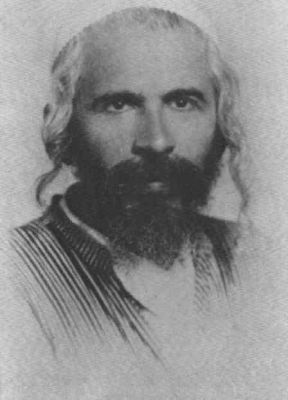
|

|
Click on Each of the Images to Enlarge
Uman (Ukrainian, Умань [MP3], Umanʹ), contained in the alleged spiritual name of Rebbe Nachman, is a city in the Ukraine. The gravesite of Nachman himself, pictured below, is in that city:

As to the ṣạdiyqiym’s name, Nachman spent his final eight years in Breslov, a Ukrainian city, until, in the terminating year of his life, a raging fire regrettably consumed his own home. He then spent his last few months in the Ukrainian city of Uman (Ukrainian, Умань [MP3], Umanʹ; or Polish, Humań [MP3]). Now, as to the significance of Acre (Hebrew, עַכּוֹ [MP3], ʿẠkkô Arabic, عَكَّا [MP3], ʿAkkā; Persian, آکِرُو [MP3], ʾÂḱarū or آکِرَه [MP3], ʾÂḱarah; Urdu, ایْکِڑَ [MP3], ʾAý°ḱiṛa; Guramukhi Punjabi, ਇਕਰ [MP3], Ikara; or Shahmukhi Punjabi, اِکَرَ [MP3], ʾIḱara), it is a tiny city on the Bay of Haifa (Hebrew, הַמִפְרָץ חֵיְפָה [MP3], hạ•Mip̄ərāṣ Ḥēyəp̄āh; or Arabic, الخَلِيج حَيْفَا [MP3], ʾal•H̱alīǧ Ḥay°fā) in Palestine, now Israel. Bahá’u’lláh resided in its vacinity during His life’s last twenty–four years. An inhabitant of Acre is an ʿẠkkôʾiy (Hebrew, עַכּוֹאִי [MP3]) or ʿAkkāyy (Arabic, عَكَّايّ [MP3]).
There is, on the other hand, a certain heterodox Orthodox branch of Nachman’s own Breslover Chasidic movement (Hebrew, תְּנוּעָה הַחֲסִידוּת [MP3], Tənūʿwāh hạ•Ḥăsīḏūṯ) to which I have, occasionally, found myself strangely attracted. Given its controversial origins, and easily debunked history, the majority of other Breslovers or Breslovians (Hebrew, בְּרֶסְלֹבִיאנִים [MP3], Bərẹsəlōḇiyʾniym) quite understandably reject it. Two deeply cherished files echo the purported spiritual name (Hebrew, נַ נַחְ נַחְמָ נַחְמָן מְאוּמַן [MP3], Nạ Nạḥə Nạḥəmā Nạḥəmān Mə•ʾŪmạn) of Rebbe Nachman. The first of the files contains a song in music and video (MP4). The second is only musical (MP3). The movement which inspired both of them, Na Nach Breslov Chasidism (Hebrew, חֲסִידוּת בְּרֶסְלֹב נַ נַחְ [MP3], Ḥăsiyḏūṯ Bərẹsəlōḇ Nạ Nạḥə), modifies, some would contend distorts, Nachman’s Breslov Chasidism.
For clarity, because Nachman, unlike most Chasidic (Hebrew, חָסִידִי [MP3]), Ḥāsīḏiy, “ or pious”) founding rebbes (Yiddish, רֶבִים [MP3], rẹbiym), decided not to appoint a succeeding rebbe, many individuals have arisen, throughout the years, to rectify that rebbe–less state. The actual founder of the neo–Breslovian (Hebrew, בְּרֶסְלֹבִי הַחָדָשׁ [MP3], Bərẹsəlōḇiy hạ•ḥāḏāš) Na Nach movement was, consequently, not Nachman himself but, rather, Rabbi Yisroel Dov Ber Odesser (Hebrew, רַבִּי יִשְׂרְאֵלִי דֹּב בֶּער אֹדֶּסֶּר [MP3], Rạbbiy Yiśərəʾēl Dōḇ Bẹʿr ʾŌdẹssẹr). He claimed that the name arrived in a letter from heaven. A disciple, Yoel Ashkenazi (Hebrew, יוֹאֵל אַשְׁכְּנַזִּי [MP3], Yôʾēl ʾẠšəkənạzziy), later confessed, stirring controversy, that the letter was a well–intentioned hoax. His intent was to cheer up Odesser after breaking his fast. Needless to say, this man led a long life (circa 1888–1994):
Click on Each of the Images of Odesser to Enlarge
In any event, as a sociologist of religion, not as a theologian or a preacher, I always regard my primary academic responsibilities to be descriptive and explanatory, not judgmental. I attempt to keep to a bare minimum my personal evaluations of the worth of different spiritual movements, such as Breslov Chasidism or, more particularly, Na Nach Breslov Chasidism. Engaging in the outright dismissal of a faith system is an exercise I could only consider when I feel, not to do so, would itself violate every morsel of humanity and my integrity in my being. One example of an appropriate religious phenomenon, in my view, for critique—presented as still another, even if an exceptionally unusual, illustration of contemporary observant Chasidic and Orthodox Judaism—will be concisely presented below. Hopefully, the reader will recognize that my intent is to inform, not to offend.
A distinction between Breslov Chasidism and Chabad–Lubavitch (Hebrew and Yiddish, חַבָּ״דּ־לְיוּבָּאווִיטְשׁ [MP3], Ḥạbā″d–Ləyūbāʾviyṭəš), another Chasidism, can be made. I, and many from Jewish families, find Chabad irritating. Multiple members of this odd ṣạdiyqiym waited, in vain, for the imminent resurrection of Rebbe Menachem Mendel Schneerson (Hebrew, מְנַחֵם מֶנְדֵל שְׁנִיאוּרְסוֹן [MP3], Mənạḥẹm Mẹnəḏēl Šəniyʾūrəsôn; 1902–1994), as messiah (Hebrew, מָשִׁיחַ [MP3], māšiyḥạ, “annointed one”). They condescendingly force their Orthodox views on secular Jews and founded one of the many Noachide (Hebrew, בְּנֵי נֹחַ [MP3], Bənēy Nōḥạ, “Noah’s Sons”) groups. Noachidism, from the Talmudic (Hebrew, תַּלְמוּדִי [MP3], Tạləmūḏiy, “instructive”) seven commandments of Noah’s sons (Hebrew, שֶׁבַע מִצְווּת בְּנֵי נֹחַ [MP3], šēḇạʿ miṣəwūṯ bənēy Nōḥạ), proselytizes to so–called gentiles.
The term Chabad (Hebrew, חַבָּ״דּ [MP3], Ḥạbā″d) is an acronym formed out of three Hebrew words: ḥọḵəmāh (Hebrew, חָכְמָה [MP3], “wisdom”), biynāh (Hebrew, בִּינָה [MP3], “understanding”), and dạʿạṯ (Hebrew, דַּעַת [MP3], “knowledge”). Luyūbāʾviyṭəš (לֳיוּבָּאווִיטְשׁ [MP3]) is the Yiddish form of Lubavitch or Lyubavich (Russian, Люба́вичи [MP3], Lûbáviči; Belarusian, Любаві́чы [MP3], Lûbaví́čy; Polish, Lubawicze [MP3]; Ukrainian, Любавич [MP3], Lûbavič; Czech, Lubavitchi [MP3]; Hebrew, לוּבּוֹבִיץ׳ [MP3], Lūbôḇiyṣ′; Arabic, لُوبَافِيتْش [MP3], Lūbāfīt°š; Persian, لُوبَاوِیچ [MP3], Lūbāvíč; Hindi, लुबाविच [MP3], Lubāvica; Guramukhi Punjabi, ਲੁਬਾਵਿਚ [MP3], Lubāvica; Shahmukhi Punjabi, لُبَاوِچَ [MP3], Lubāviča; or Urdu, لُبَاوِچَ [MP3], Lubāwiča), formerly in the Polish–Lithuanian Commonwealth, is an old Russian village. It served as a 19ᵗʰ–century home for the dynasty.
Click on the Image to Enlarge
I have yet another point on Chasidism. A billionaire friend of mine from high school, with whom I continue to keep in touch on Linkedin, briefly became a Chasid in his 20s. At the same time, he was also involved in a Jewish deprogramming movement. Its purported objective was to essentially reverse brainwash people back into Judaism―as if I ever actually practiced the religion in the first place. He once phoned my mother and requested her assistance in abducting me! She refused and immediately informed me of the call. After my prodding, he attempted a limited deprogramming in my bedroom. It did not go well for him. That strange incident notwithstanding, this man and I remained friends. He never joined a dynasty, but he wore classical Chasidic garb. He ostentatiously attired himself, making his Jewish paraphernalia apparent, while he affected a faux Yiddish accent.
Even if Hasidism had passed into the limbo of history, this pietist–mystical–revivalist movement would be of intense interest to the student of Judaism. Apart from the tremendous impact it has had on Jewish life, Hasidism has also influenced modern Christian theology. But Hasidism is not only still alive today, it is even expenenc1ng a resurgence that few would have predicted even 50 years ago.
Aryeh Rubinstein. Hasidism: Popular History of Jewish Civilization. New York: Leon Amiel Publishers. 1975. Page 1.
As a movement that borrowed eclectically from many sources, Hasidism cannot be reduced to one, homogeneous doctrine. It incorporated both ascetic negation of the material world and antiascetic affirmation of the material, as well as messianic and antimessianic tendencies. For some Hasidic teachers, devekut meant the union of the worshipper with God, while for others, it meant less self–effacing communion. Some Hasidic teachings are almost explicitly pantheistic, while others emphasize God’s transcendence. Some rank prayer higher than study, while others see them as equally holy. Some doctrines are imbued with halakhah, while a few flirt with antinomianism. Each tsaddik offered his own interpretation of the “philosophy” of Hasidism. Not one, but the full range of these ideas must count as constituting Hasidism.
David Biale et al. Hasidism: A New History. Princeton, New Jersey: Princeton University Press. 2018. Google Play edition.
Chasidism covers only a corner of the picture of Orthodox Judaism (Hebrew, יַהֲדוּת הַאוֹרְתּוֹדוֹקְסִית [MP3], Yạhăḏūṯ hạ•ʾÔrətôḏōqəsiyṯ; Arabic, يَهُودِيَّة الأُرْثُوذُكْسِيَّة [MP3], Yahūdiyyaẗ ʾal•⫯Ur°ṯūḏuk°siyyaẗ; Persian, یَهُودِیَتِ اُرْتُدُوکْس [MP3], Ýahūdiýat•i ʾUr°tudūḱ°s or یَهُودِیَتِ حَنِیف [MP3], Ýahūdiýat•i Ḥaníf; Urdu, آرْتْھُوڈُوکْسَ یَہُودِیَّتَ [MP3], ʾÂr°t°hūḍūḱ°sa Ýahūdiýýata or کَٹَّرَ یَہُودِیَّتَ [MP3], Kaṭṭara Ýahūdiýýata; Guramukhi Punjabi, ਆਰਥੋਡਾਕਸ ਯਹੂਦੀਆ [MP3], Ārathōḍākasa Yahūdīꞌā; Shahmukhi Punjabi, آرَتْھُوڈَاکَسَ یَہُودِیَا [MP3], ʾÂrat°hūḍāḱasa Ýahūdiyā; or Tajik, Ҷудосудии православӣ [MP3], Ǧudosudi•i Pravoslavī) also called Torah Judaism (Hebrew, יַהֲדוּת הַתּוֹרָה [MP3], Yạhăḏūṯ hạ•Tôrāh; Arabic, يَهُودِيَّة التَوْرَاة [MP3], Yahūdiyyaẗ ʾal•Taw°raẗ; Persian, یَهُودِیَتِ تَوْرَات [MP3], Ýahūdiýat•i Taw°rāt; Tajik, Ҷудосудии Таврот [MP3], Ǧudosudi•i Tavrot; or Urdu, تَوْرَہ یَہُودِیُّوں [MP3], Taw°rah Ýahūdiýýūṉ).
Although the tradition of Orthodox Judaism is relatively small, in the number of Jews who will self–identify as Orthodox, it has remained highly influential (too influential as some might say) in global Jewry. Besides Chasidism, and sometimes overlapping with it, Orthodoxy can be subdivided into additional branches:
- Among the more cogent factions within Orthodox Judaism is called Haredi Judaism (Hebrew, יַהֲדוּת הַחֲרֵדִית [MP3], Yạhăḏūṯ hạ•Ḥărēḏiyṯ). It is customarily, and in general accurately, referred to as Ultra–Orthodox Judaism, as Haredis do tend to be quite strict in their Jewish practice. A Haredi (Hebrew, חֲרֵדִי [MP3], Ḥărēḏiy) is a trembler.
- Yet another major camp is Modern Orthodox Judaism (Hebrew, יַהֲדוּת הַאוֹרְתּוֹדוֹקְסִית הַמוֹדֶרְנִית [MP3], Yạhăḏūṯ hạ•ʾÔrẹtôḏôqəsiyṯ hạ•Mōḏẹrəniyṯ). Yeshiva University Judaism (Hebrew, יַהֲדוּת הַאוּנִיבֶרְסִיטָה הַיְשִׁיבָה [MP3], Yạhăḏūṯ hạ•ʾŪniyḇẹrəsiyṭāh hạ•Yəšiyḇāh), a clearly misleading epithet for Modern Orthodox Judaism, was named after Manhattan’s Yeshiva University (YU). Indeed, a broad spectrum of Jews are students, faculty, and staff at YU.
Neo–Chasidism (Hebrew, חֲסִידוּת הַחָדָשׁ [MP3], Ḥăsiyḏūṯ hạ•ḥāḏāš), also known as Jewish Renewal (Hebrew, הִתְחַדְּשׁוּת הַיְהוּדִית [MP3], Hiṯəḥạḏəšūṯ hạ•Yəhūḏiyṯ), takes Chasidism, subtracts Orthodox Judaism, and adds liberal Judaism (Hebrew, יַהֲדוּת הַלִיבֶּרָלִית [MP3], Yạhăḏūṯ hạ•liybẹrāliyṯ). The primary venues for this multifaceted movement are: ALEPH: Alliance for Jewish Renewal from the late rabbi Zalman Schachter–Shalomi (Hebrew, זַלְמָן שֶׁחְטֶר־שַׁלוֹמִי [MP3], Zạləmān Šəḥəṭẹr–Ôạlōmiy), 1924–2014; Tikkun Magazine in combination with the intentionally interdenominational The Network of Spiritual Progressives from U.S. rabbi Michael Lerner, born in 1941; and the movement, which originated in the 20ᵗʰ century, nowadays designated as Reconstructing Judaism. Depending on the religious community under consideration, the focus can range from spirituality to politics.
My personal critique of certain, but plainly not all, Neo–Chasidic or Jewish Renewal temples and groups is that some of them, particularly those associated with Schachter–Shalomi, have appropriated New Age practices and may even be appropriately regarded as a belonging to the New Age Movement. As a side note, I discovered, as I became older, that, contrary to my youthful impressions, much of that movement, in reality, belongs to the fascist right. Since that movement—which is primarily a synthesis of elements of Theosophy and New Thought—was, to one degree or another, a result of the tragic disintegration of the New Left, my New Left, in the early 1970s, I am not a fan. As a critical realist, I also strongly disagree with the metaphysical idealism common among New Agers. In the two photographs below, Schachter–Shalomi is on the left, and Lerner is on the right:
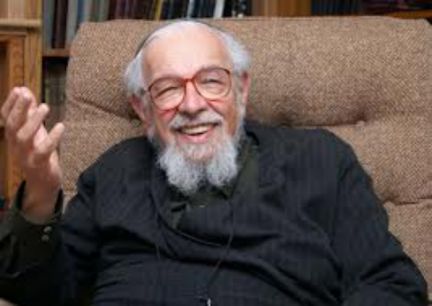
|
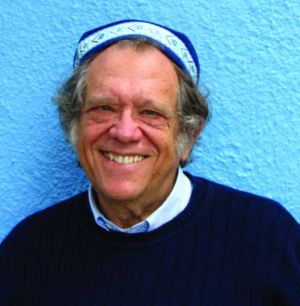
|
Click on Each of the Images to Enlarge
- Tənūʿāh hạ•Hạgiyl hạ•Ḥāḏāš (Hebrew, תְּנוּעָה הַגִּיל הַחָדָשׁ [MP3]), “New Age Movement”
- Ḥarakaẗ min ʾal•ʿAṣ°r ʾal•Ǧadīd (Arabic, حَرَكَة مِن العَصْر الجَدِيد [MP3]), “New Age Movement”
- Ḥaraḱat•i San•i Ǧadíd (Persian, حَرَکَتِ سَنِ جَدِید [MP3]), “New Age Movement”
- Harakat•i Sinnu•i Nav (Tajik, Ҳаракати Синнуи Нав [MP3]), “New Age Movement”
- N°ýā ʿUmr ḱí Taḥ°rík (Urdu, نْیَا عُمر کِی تَحْرِیک [MP3]), “New Age Movement”
- Niꞌū Ēja Mūvamaiṇṭa (Guramukhi Punjabi, &ਨਿਊ ਏਜ ਮੂਵਮੈਂਟ [MP3]), “New Age Movement”
- Niýū ʾAý°ǧa Muvamaýn°ṭa (Shahmukhi Punjabi, نِیُو ایْجَ مُوَمَینْٹَ [MP3]), “New Age Movement”
- Tēʾôsôp̄əyāh (Hebrew, תֵּאוֹסוֹפְיָה [MP3]), “Theosophy”
- Ṯiyūsūfiyyaẗ (Arabic, ثِيُوصُوفِيَّة [MP3]), “Theosophy”
- Tiýāsāfí (Persian, تِیَاسَافِی [MP3]), “Theosophy”
- Teosofiya (Tajik, Теософия [MP3]), “Theosophy”
- ʿAlima Ḥaḍ°rāta (Urdu, عَلِمَ حَضْرَاتَ [MP3]), “Theosophy”
- Thiꞌāsafī (Guramukhi Punjabi, ਥਿਆਸਫ਼ੀ [MP3]), “Theosophy”
- T°hiýāsafí (Shahmukhi Punjabi, تھِیَاسَفِی [MP3]), “Theosophy”
- Bir°ham Vid°yā (Sindhi, بِرْھَم وِدْيَا, [MP3]), “Theosophy”
- Mạḥəšāḇāh hạ•Ḥāḏāš (Hebrew, מַחְשָׁבָה הַחָדָשׁ [MP3]), “New Thought”
- Fik°r ʾal•Ǧadīd (Arabic, فِكْر الجَدِيد [MP3]), “New Thought”
- Fiḱ°r•i Ǧadíd (Persian, فِکرِ جَدِید [MP3]), “New Thought”
- Fikrho•i Nav (Tajik, Фикрҳои нав [MP3]), “New Thought”
- N°ýā H̱iýāla (Urdu, نْیَا خِیَالَ [MP3]), “New Thought”
- Navāṁ Thāṭa (Guramukhi Punjabi, ਨਵਾਂ ਥਾਟ [MP3]), “New Thought”
- Navāṉ T°hāṭa (Shahmukhi Punjabi, نَوَاں تْھَاٹَ [MP3]), “New Thought”
- Niwaý Fiḱ°r (Pashto, نِوَی فِکْر [MP3]), “New Thought”
- Na⫯yyan Suč (Sindhi, نَئيَن سُوچ [MP3]), “New Thought”
- ʾiyḏēʾāliyzəm hạ•mẹṭāp̄iyziy (Hebrew, אִידֵאָלִיזְם הַמֶטָפִיזִי [MP3]), “metaphysical idealism”
- miṯāliyyaẗ ʾal•mītāfīzīqiyyaẗ (Arabic, مِثَالِيَّة المِيتَافِيزِيقِيَّة [MP3]), “metaphysical idealism”
- maʿ°naviýat•i mitāfízíqí (Persian, مَعْنَوِيَتِ مِتَافِیزِیکِی [MP3]), “metaphysical idealism”
- idealizm•i metofizikī (Tajik, идеализми метофизикӣ [MP3]), “metaphysical idealism”
- ʾis°taʿafí miṯālí (Urdu, اِسْتَعَفِی مِثَالِی [MP3]), “metaphysical idealism”
- parābhautika ādaraśavāda (Guramukhi Punjabi, ਪਰਾਭੌਤਿਕ ਆਦਰਸ਼ਵਾਦ [MP3]), “metaphysical idealism”
- parāb°hav°tiḱa ʾâdarašavāda (Shahmukhi Punjabi, پَرَاْبھَوتِکَ آدَرَشَوَادَ [MP3]), “metaphysical idealism”
Although I do not, in my real life, practice the religion of Judaism, I find the most appealing Jewish movement—a term compared to a Christian denomination—to be Reconstructing Judaism. The movement was called, up until October, 2017, Reconstructionist Judaism. Reconstructionism was originally the left–wing of Conservative Judaism. (By the way, everywhere except for the United States, Conservative Judaism is known as Masorti [Hebrew, מָסָרְתִּי; MP3, Māsọrətiy, “Traditional”]. Conservative Judaism has, nomenclature aside, no organizational affiliation with The Union for Traditional Judaism. The latter, a relatively small Jewish movement, has frequently been nicknamed as Conservadox. That word is a portmanteau of Conservative and Orthodox. Thus, Traditional Judaism is, for all practical purposes, a hybrid of Conservative Judaism and Orthodox Judaism.)
Reconstructionism was established, in New York City, by Mordecai Kaplan (Russian, Мордехай Менахем Каплан [MP3], Mordehaj Menahem Kaplan; or Hebrew, מָרְדְּכַי מְנַחֵם קַפְּלַן [MP3], Mọrədəḵạy Mənạḥēm Qạpəlạn), 1881–1983, and his son–in–law Ira Eisenstein, 1906–2001. Kaplan was not an atheist, but his idiosyncratic construction of Judaism as an evolving civilization challenged the settled scriptural canon of most other existing Jewish movements. Consequently, his belief in G–d has sadly been questioned. Continuing up until the present time, many people have accepted the urban legend that Kaplan did not believe in the existence of G–d. Indeed, that erroneous narrative, while not universal, is fair neither to Kaplan, as an individual, nor to the historical record. I actually, to be completely honest, personally accepted that fallacious account of Kaplan for a long time.
My major difficulty with Kaplan and Eisenstein’s movement is that its acceptance of human progress without a basis in continuing, progressive revelation. The divinely inspired Jewish Bible records the activities of Prophets. However, any further developments in human civilization, perhaps inspired by G–d’s Will, are determined by human agency. A similar existential mood is, of course, shared by other leading Jewish movements, too. Reconstructionist theology can perhaps be most cogently described as either weak theism or strong deism. Admittedly, holding this view, existing in a lifeworld (German, Lebenswelt [MP3]) not quite theistic and not quite deistic, may appeal to some individuals. As a strong theist, I am not among them. In spite of that, I applaud Reconstructing Judaism as an organization committed to making Judaism current and relevant to the 21ˢᵗ century.
Here are some quotations on Reconstructionism:
It is, perhaps, not too much to expect that the reappearance of JUDAISM AS A CIVILIZATION [in a new edition] will help to vindicate the Reconstructionist movement against those who charge it with being more secular than religious, in that it treats the problem of Judaism as a socio–psychological rather than as a theological problem. It is a fact, however, that the diagnosis of what is wrong with Jewish life, and the prescription of what is necessary to set it right, are as related to what we can learn from the human sciences as the diagnosis and cure of physical disease are related to chemistry and physics. The medicos who opposed Louis Pasteur’s interpretation and treatment of physical disease were, no doubt, resentful that a chemist, who was no physician, should instruct them in their own specialty.
The republication of this book might also serve as a reminder that the idea of “Judaism as a civilization” was not intended as a slogan to abet laxity in ritual observances or indifference to religion. It was definitely intended to motivate in Jews a maximum and not a minimum identification with Jewish life. “Judaism as a civilization” is a call to American Jews to attend to the following needs: i) To reaffirm Jewish peoplehood; 2) to revitalize Jewish religion; 3) to form a network of organic communities; 4) to strengthen the State of Israel; 5) to further Jewish cultural creativity; and 6) to cooperate with the general community in all endeavors in behalf of freedom, justice and peace. May God grant that our People heed the call.
Mordecai M. Kaplan. Judaism as a Civilization: Toward a Reconstruction of American–Jewish Life. Enlarged edition. New York and London: Thomas Yoseloff. 1957. Page x.
Whence is that survival–value to come if not from the basic principles which constitute the particular version of Judaism implied in the program? It is evident, therefore, that it is impossible to plan Jewish life intelligently without committing oneself to some specific version or interpretation of that which differentiates Jews from non–Jews. There are at present three distinct conceptions of the Jewish differentia. According to the Reformists, the Jews are a religious community united by their adherence to ethical monotheism, which their ancestors evolved in the course of centuries. There are others besides Jews who profess ethical monotheism, but the Jews profess ethical monotheism in its truest form. According to the Neo–Orthodox, the Jews are the people to whose ancestors God revealed himself and made known the teachings contained in the Torah. The Jews are thus in possession of the only true religion, since a religion to be genuine must be supernaturally revealed. Those who belong to neither group and yet take an affirmative attitude toward Jewish life and wish to see it thrive may be said to regard the Jews as bound together by the ties of nationhood, differing from the rest of the world by virtue of their inherited culture or civilization.
Each of these conceptions of the Jewish differentia has its variants. There is a conservative Judaism which is the left wing of Orthodoxy, and there is a conservative Judaism which is the right wing of Reformism. The version of those who regard the Jews as possessing a common culture or civilization has been given three different interpretations. According to the one extreme view, Palestine is the only country in which Jewish civilization can survive. According to another extreme view, the survival of the Jewish civilization is contingent upon its thorough secularization and its adoption of Yiddish as its vernacular and literary medium.
The program advocated in this book is based on the cultural version of Judaism, as accepted by those who take the central position that Jewish civilization can function in varying degrees in the diaspora, provided it have its home in Palestine and retain both its Hebraic and religious character. Before proceeding with a description of the version of Judaism which has here been selected as the basis of a program for Jewish life in America, I shall give a survey of the two principal interpretations of Judaism that stand out most conspicuously in American–Jewish life, the Reformist and the Neo–Orthodox, together with their variants, and point out wherein they are inadequate and unacceptable to those to whom Jewish life is not worth saving, unless it be a creative Jewish life.
Mordecai M. Kaplan. Judaism as a Civilization: Toward a Reconstruction of American–Jewish Life. Enlarged edition. New York and London: Thomas Yoseloff. 1957. Pages 86–87.
I used to be a Conservative Jew. I am one no longer. Perhaps that is an overstatement, for I continue to maintain my membership in the Rabbinical Assembly. But, to all intents and purposes, I have withdrawn from the “movement,” after more than thirty years of active participation. Iwas graduated from the Jewish Theological Seminary; both synagogues which I served between 1931 and 1959 belonged to the United Synagogue; and, until Reconstructionism became a movement, I allowed myself to be identified as a member of the “left wing” of the Rabbinical Assembly. It was a misnomer at the time―but let that stand. Today I am an “outsider” and it is as such that I was invited to share in this symposium on Conservative Judaism by the distinguished editor of this journal.
Ira Eisenstein, “Inherent Contradictions of Conservatism.” Judaism. Volume 26, issue, 3, July 1977. Pages 339-343.
A new name [Reconstructing Judaism] was a requirement of the merger between our seminary and congregational union. We saw developing a new name as an opportunity to engage with Reconstructionists across North America to revisit our essence and capture the energy inherent in the movement. It clearly communicates who we are, what we do and have always done, and invites people to join us in this holy work. It reflects our mission and communicates to the world that we are about actively engaging and creating Jewish life.…
Reconstructing Judaism is the central organization of the Reconstructionist movement. We believe that Judaism evolves with the world and that we can play a powerful role in defining the Jewish future. To do so, we train rabbis, support and partner with congregations and summer camps and foster the emerging ideas that shape what it means to be Jewish today.
Editor, “Our New Name.” Reconstructing Judaism: Deeply Rooted. Boldly Relevant. January 29ᵗʰ, 2018. Retrieved on August 13ᵗʰ, 2018. No pagination.
Why the Reconstructionist movement? I believe that because of our commitment to the concept of peoplehood and to the imperative of cultural evolution; because of our commitment to the lay/rabbinic partnership, and to community-based and values-based decision-making; because of our commitment to participation and engagement; because of our openness to new ideas; and because of the empowered intelligence of our rabbis and lay members, we are uniquely suited to be, as we have always been, a powerful engine to drive the Jewish future forward.
Seth Rosen, “Reconstructing Judaism: Evolution in Action.” Reconstructing Judaism: Deeply Rooted. Boldly Relevant. May 1ˢᵗ, 2018. Retrieved on August 13ᵗʰ, 2018. No pagination.
Reconstructionists are not atheists. The founder of Reconstructionism, Rabbi Mordecai M. Kaplan, was falsely accused of atheism during his lifetime and has been so labeled since his death. Those accusations are made by people who think that either you believe in a God who governs the details of our lives, rewarding and punishing us, orchestrating the things that happen or you don’t believe in God at all.…
I don’t believe that God decided to cause the sun to rise this morning. I don’t believe God watches over my children and makes them mature. I don’t believe God solves my work problems. But I do believe I live in a world that God underlies and suffuses. I do believe that I do not generate my virtuous deeds and insights independently, but rather am connected to a greater Source of strength and blessing with whom I am always trying to align. I believe some things are right and some things are wrong, and I believe that when you do the wrong thing you are opposing the divine will and that the world is so constructed that you will suffer for it internally.
Rabbi Jacob Staub, Ph.D., “How Can Reconstructionists Pray?” Reconstructing Judaism: Deeply Rooted. Boldly Relevant. March 29ᵗʰ, 2017. Retrieved on August 13ᵗʰ, 2018. No pagination.
The Reconstructionist movement is the youngest of the four branches of American Judaism, having achieved full denominational status only in the late 1960s, with the founding of the Reconstructionist Rabbinical College in Philadelphia. The College curriculum, designed in accord with the “civilizational” approach of the movement’s founder, Rabbi Mordecai Kaplan, placed equal value on all periods of Jewish history and on all forms of Jewish creativity, rather than focusing primarily on rabbinic texts. For the first time, the movement was able to train rabbis, imbued with a distinctive Reconstructionist viewpoint, for the growing number of congregations affiliating with the Federation of Reconstructionist Congregations and Havurot (established as the Reconstructionist Federation of Congregations in 1955, and now known as the Jewish Reconstructionist Federation).
However, the origins of the Reconstructionist movement date back to the early 1920s, when Kaplan first articulated his critique of both Orthodoxy and Reform, and presented a bold new agenda for the revitalization of Judaism.
Reena Sigman Friedman, “The Emergence of Reconstructionism: An Evolving American Judaism, 1922-1945.” American Jewish Archives. Volume 48, number 1, 1996. Pages 1-22.
This new name [Reconstructing Judaism] developed in a year–long, quintessentially Reconstructionist process that placed a high value on discussion, participation and the sharing of ideas.…
One of the results of this process was the decision to stick with a version of the word “Reconstructionist” in the organization’s name. The idea was considered to drop the word Reconstructionist, but Reconstructionists like us across the continent made clear they were strongly attached to the word and considered it part of their identity. By adding the ing, the organization is enhancing the clarity of who they are and what they do.
Editor, “Reconstructing Judaism.” Ha Kesher: The Communication Newsletter of Congregation Dor H̲adash. Volume 35, issue 6, March–April 2018. Pages 1 and 3. Retrieved on August 13ᵗʰ, 2018.
… the rabbinical seminary outside Philadelphia known as the Reconstructionist Rabbinical College will be referred to as the College for Reconstructing Judaism, and it will fall under the organizational umbrella now called Reconstructing Judaism.…
The new name was officially approved by the board in October 2017.…
Seth Rosen, chair of the board of governors, added the vision is to bring the Reconstructing Judaism model to a national level and draw on the rhythm of affiliated Reconstructionists across North America.…
Although the name change is for the organization, not the movement, Rosen said many have taken to the name to identify themselves. But time will tell. “It will emerge over time how this will be reflected more broadly.”
Rachel Kurland, “Reconstructionist Judaism gets a rebrand.” Pittsburgh Jewish Chronicle. February 1ˢᵗ, 2018. Pagination unknown. Retrieved on August 14ᵗʰ, 2018.
Click on Each of the Images to Enlarge
Both Reconstructing Judaism and Reform Judaism are affiliates of The World Union for Progressive Judaism. The categorically secular Reform Judaism, known as Liberal Judaism in some parts of the world, places no demand whatsoever of believing in G–d or His Prophets on its members. Instead, Reform Jews underscore the progressive nature of knowledge. Ethics are valued more than any kind of divine Revelation. Quite similar to Reform Judaism are the Society for Humanistic Judaism and Congress of Secular Jewish Organizations, members of The International Federation for Secular and Humanistic Judaism. As taught by secular and humanistic Jews, Judaism is a human–, not a G–d–, centered faith―founded upon Jewish culture and creating a better world. Each one of the movements referenced in this paragraph is, with Jewish Renewal, progressive Judaism.
From the Society for Applied Judaism: Center for Jewish Science, in New York City, the idealist, monist, or nondualist Jewish Science movement was conceived by Rabbi Alfred G. Moses (1878–1956). He offered a particularly Jewish rejoinder to the historical prevalence of Christian Science—which began though the encounter between Mary Baker Eddy (author of Science and Health with Key to the Scriptures), 1821–1910, and Phineas Parkhurst Quimby (whose writings Eddy plagiarized), 1802–1866—and its New Thought offshoots, primarily but not exclusively: Unity, Centers for Spiritual Living (originally, Religious Science), Divine Science, and the largest New Thought organization, Seicho no Ie (Japanese, 生長の家 [MP3], Seichō•no•Ie, “House of Growth”). New Thought, overall, has endured for over a century. Christian Science, as the parent movement, is even older.
Within the Jewish Science movement, a special emphasis is placed upon the mind and prayer to encourage growth as well as healing from various maladies―both spiritual and physical. However, availing oneself of orthodox medical treatment was not forbidden by Rabbi Moses. For additional information, read Rabbi Moses’ book, Jewish Science: Divine Healing in Judaism. Moses’ fundamental concern, contextualized in his own time, was that substantial numbers of Jews were abandoning Judaism either for Christian Science or for New Thought. Of course, this specific rationale for Jews renouncing Judaism has, for the most part, long since passed. Today, many Jews join other faiths or, on the other hand, choose no faith at all. That notwithstanding, Jewish Science continues its operations albeit as one of the numerically smaller, if not the smallest, Jewish movement.
Although not generally considered to be a Jewish movement per se, the Ethical Culture Societies, as represented by the American Ethical Union, were founded by the son of a Reform Jewish rabbi, Felix Adler (1851–1953). He wished to establish an organization in which the principal emphasis was placed on ethics, not monotheism. Even though Adler was not personally an atheist, today, many Ethical Culturists are atheists or adherents of like–minded philosophies in which a belief in G–d is either dismissed or, at least, de–emphasized. Ethical Culture has, notably, unfolded, over time, from a non–Judaic ethical monotheism into a more generalized school of ethics. Perhaps the preeminent factor which distinguishes Ethical Culture from some of the varieties of progressive Judaism previously considered is that its membership is not restricted to those who self–identify as Jewish.
To emphasize my Jewish bona fides and Jewishness (Yiddish, יִידִישְׁקַיְיט [MP3], Yiyḏiyšəqạyəyṭ or Yiddishkeit), I am a Levite (Hebrew, לֵוִי [MP3], Lēwiy, “joined” priestly tribe), a bəʾriyṯ miyʾlāh (Hebrew, בְּרִית מִילָה [MP3], “covenant of circumcision”), a bar mitzvah (modified Hebrew, בַּר מִצְוָה [MP3], bạr miṣəwāh, “son of commandment”) through the aforementioned Joel Bernstein’s Hebrew School, as well as the eldest child of two Jewish Ashkenazi (originally Hebrew, אַשְׁכְּנַזִּי [MP3], ʾẠšəkənạzziy; Arabic, أَشْكِنَازِّيّ [MP3], ⫯Aš°kināzziyy; Amharic, አሽካዚ [MP3], ʾÄšəkazi; both Persian and Urdu, اشْکِنَازِّی [MP3], ʾAš°ḱināzzí; Shahmukhi Punjabi, آشْکٍینَازِی [MP3], ʾš°ḱēnāzí; Guramukhi Punjabi, ਆਸ਼੍ਕੇਨਾਜ਼ੀ [MP3], Āśkēnāzī; or Modern Greek, Ασκάνζι [MP3], Askánzi, “German Rhinelander,” i.e., referring to anyone born with a Yiddish–speaking European Jewish lineage) parents.
My departed parents were older than average. Their first baby had perished in a miscarriage seven years prior to my birth. I am unaware of the gender of the embryo or the fetus. For some reason, the common medical practice, at the time, was to discourage mothers from attempting another pregnancy soon after a miscarriage. I shall assume, perhaps surmise is more accurate, that there was some empirical basis for this recommendation. Yet, the explanation for the previous policy, if indeed there is one, is unknown to me. It has, in any event, long since been abandoned, even reversed, by the medical community. My mother told me that she was ill for entire seven–year period between the miscarriage and my birth. Somehow, right after I was born, her illness vanished. I am most grateful for the improvement to her health, but I am unable, once again, to offer any clarification.
Latinized spellings in this monograph employ, with sparse changes, ISO (International Organization for Standardization) Hebrew transliteration, my own extensive ISO Arabic modification, or other Romanization systems. Accordingly, this comrade’s communist alias, מֹשֶׁה אַהֲרֹן הַלֵוִי בֶּן הֶערְשֶׁעל (MP3), is a hybrid of Hebrew (the first four words) and Yiddish (the last word). The alias is, truthfully, a somewhat expanded version of my actual Jewish name. It incorporates both my father’s and my own bəʾriyṯ miyʾlāh names along with an appropriate mention of my Levitical tribal ancestry. Jewish historical naming practices are, consistent with the norms of most cultures, patrilineal, not matrilineal. Aside from the computer–generated Romanized spellings, any regrettable errors in the transliterations given below are my own:
- Mōšẹh ʾẠhărōn hạ•Lēwiy bẹn Hẹʿrəšẹʿl (modified ISO)
- Mosheh ’Aharon ha-Leṿi ben He‘rshe‘l (American Library Association/Library of Congress)
- Mōšeh ʾAhărōn ha-Lēwî ben Heʿrəšeʿl (Society of Biblical Literature)
- Mosheh Aharon ha-Leviy ben Heʿrsheʿl (Pan–Sephardic)
- Môsheh ’Ahǎrôn ha-Lêvîy ben He‘rshe‘l (Strong’s Dictionary)
- Mosheh ʾAharon ha-Leyviy ben Heʿrsheʿl (modern Ashkenazi and modern Israeli; Hebrew, יִשְׂרְאֵלִי; [MP3], Yiśərəʾēliy)
- Moshe ’Aharon ha-Léwi ben He‘rshe‘l (United States Board on Geographic Names/BGN and the Permanent Committee on Geographical Names for British Official Use/PCGN)
- Mòşeh ʼAhàròn ha-Léwiy ben Herĕşel (Common Locale Data Repository/CLDR)
- Mosheh Aharon ha-Levi ben He'rshe'l (Simplified Sefardi)
- Mosheh Aharon ha-Lévi ben He‘rshe‘l (Advanced Sefardi)
- Mosheh 'Aharon ha-Leivi ben He'rshe'l (Ashkenazi)
- Mōšɛh ʾAhărōn ha-Lēwī bɛn Hɛʿršɛʿl (technical)
- Mōšęh ʾAharōn ha-Lêwî bęn Hęʿršęʿl (Brill)
- Mošeh ʔahron ha-Lewiy ben Heˁršeˁl (phonemic conversion)
- Mosheh 'Aharon ha-Lévi ben He'rshe'l (United Nations recommended system)
- Mosheh 'Aharon ha-Levi ben He'rshe'l (ANSI 1)
- Mosheh 'Aharon ha-Lewi ben He`rshe `l (ANSI 2).
I have endeavored to make several translations of my Hebrew and Yiddish name. Although I have strived for these multilingual renderings to be as precise as possible, flaws in my work will almost certainly be apparent to native speakers and scholars of those languages. I humbly apologize in advance for these mistakes. The translated versions immediately follow this paragraph:
- Mọšẹh ʾẠhərən dēʿr Lēʿviyəṭ dēʿr Zūn p̅ūn Hẹʿrəšẹʿl (Yiddish, מָשֶׁה אַהְרְן דֵּער לֵעווִיְט דֵּער זוּן פֿוּן הֶערְשֶׁעל [MP3])
- Mose Aaron der Levit der Sohn von Herschel (German [MP3])
- Mūsaỳ Hārūn ʾal•Lāwaỳ bin Hir°šil (Arabic, مُوسَى هَارُون اللَاوَى بِن هِرْشِل [MP3])
- Mūsaý Hārūn•i Lāví ʾib°n•i Hir°šil (Persian, مُوسَی هَارُونِ لَاوِی اِبْنِ هِرْشِل [MP3])
- Mūsaý Hārūn•i Lāví pisar•i Hir°šil (Persian, مُوسَی هَارُونِ لَاوِی پِسَرِ هِرْشِل [MP3])
- Muso Horun•i Lavi pisar•i Heršel (Tajik, Мусо Ҳоруни Лави писар Ҳершел [MP3])
- Mūsaý Hārūn Líwí zuwí da Hir°šil (Pashto, مُوسَی هَارُون زُوِی دَ هِرْشِل [MP3])
- Mūsaý̍ Hārūna ʾal•Lāwí ʾaw°r Hir°šēla ḱā ʾal•Bēṭā (Urdu, مُوسَیٰ ہَارُونَ اللَاوِی اوْر ہِرْشَیلَ کَا البَیٹَا [MP3])
- Mūsaý̍ Hārūna ʾíhaha Lēví atē Harašēla dē ʾíhaha Putara (Shahkmukhi Punjabi, مُوسَيٰ̰ ہَارُونَ اِیہَہَ لَیوِی اتَے ہَرَشَیلَ دَے اِیہَہَ پُتَرَ [MP3])
- Mūsā Hārūna iha Lēvī atē Haraśēla dē iha Putara (Guramukhi Punjabi, ਮੂਸਾ ਹਾਰੂਨ ਇਹ ਲੇਵੀ ਅਤੇ ਹਰਸ਼ੇਲ ਦੇ ਇਹ ਪੁਤਰ [MP3])
- Muse ʾÄronawi Lewawi yä•ʾÄgazänə Ləǧə (Amharic, ሙሴ አሮናዊ ሌዋዊ የአጋዘን ልጅ [MP3]).
- Mosè Aaron il–Levitu l–Iben tal-Ċriev (Maltese [MP3])
- Mozes Aäron de Leviet zoon van Herschel (Dutch [MP3])
- Mūsā Hārūna Levī kā Kuraṃga kā Beṭā (Hindi, मूसा हारून लेवी का कुरंग का बेटा [MP3])
- Mūsā Hārūna Levī Hiraṇa ke Putra (Hindi, मूसा हारून लेवी हिरण के पुत्र [MP3])
- Hariṇēra putra Mōśira Hārōṇa Lēbīẏa (Bengali, হরিণের পুত্র মোশির হারোণ লেবীয় [MP3])
- Lēvīyuḍaina Mōṣē Aharōnu Jiṅkala kumāruḍu (Telugu, లేవీయుడైన మోషే అహరోను జింకల కుమారుడు [MP3])
- Moïse Aaron le Lévite fils du Faon (French [MP3])
- Moisés Aarón el Levita hijo del Cervatillo (Spanish [MP3])
- Moisés Arão o Levita Filho da Jovem Corça (Portugese [MP3])
- Mosè Aronne il Levita il Figlio del Cerbiatto (Italian [MP3])
- Moise Aaron Levitul Fiul Deerului (Romanian [MP3])
- Movsēsn ġewtacʻi Aharonə vordin Heršeli (Armenian, Մովսէսն ղեւտացի Ահարոնը որդին Հերշելի [MP3])
Turning to more specific issues of etymology, Moses (מֹשֶׁה, Mōšẹh), the name of the great biblical Prophet, is Hebrew for “pulled out” or “drawn out” from the Nile River. After His seemingly providential rescue from an imminent drowning, He was allegedly reared by the Pharaoh’s daughter. The linguistic derivation of Aaron (אַהֲרֹן, ʾẠhărōn), on the other hand, remains uncertain. The word may, according to various accounts, translate from the Hebrew as “high mountain,” as “bearer of martyrs,” or possibly as “exalted or lofty one.” However, putting semantics aside, Aaron was, reportedly, the Brother or, perhaps, Half–Brother of Moses and the Latter’s minor Prophet or Vicegerent (MP3).
Bẹn (בֶּן) is Hebrew and Yiddish for “son” or “son of.” Bẹn (Yiddish, בֶן) is an alternate Yiddish spelling of the word. ʾIb°n (اِبْن) and bin (بِن [MP3]) in Arabic, bar (ܒܪ [MP3]) in Syriac/Sūryayaʾ, and iben (MP3) in Maltese are Semitic relatives to the Hebrew and Yiddish versions. ʾIb°n (Persian, اِبْن [MP3]), ʾib°na (Urdu, اِبْنَ [MP3]), bin (Persian, بِن [MP3]), or bina (Urdu, بِنَ [MP3]) are also Arabic loanwords in those Indo–Iranian (Persian, هِنْدُو اِیْرَانِی [MP3], Hin°dū ʾIý°rāní; Urdu, ہِنْدَ ـ اِیْرَانِی [MP3], Hin°da–ʾIý°rāní; Arabic, هِندُو ـ إِيْرَانِيّ [MP3], Hin°dū–⫰Iy°rāniyy; Guramukhi Punjabi, ਇੰਡੋ–ਇਰਾਨੀ [MP3], Iḍō–Irānī; Shahmukhi Punjabi, اِنْڈُو ـ اِیْرَانِی [MP3], ʾIn°ḍū–ʾIý°rāní; or Hebrew, הִנְדּוּ־אִירָאנִי [MP3], Hinədū–ʾIyrāʾniy) languages.
My Jewish name, Mōšẹh ʾẠhărōn (Hebrew, מֹשֶׁה אַהֲרֹן), is Hebrew, but parents can, traditionally, derive such names from either from the Semitic language of Hebrew or the Germanic Yiddish. Although usually written in a variant of the Hebrew script, the basic structure of Yiddish is closer to the Germanic English than to the Semitic Hebrew. My father’s Jewish name, Hẹʿərəšəʿl (הֶערְשֶׁעל), is little deer in Yiddish and a diminutive (through the Yiddish על, ʿl) of the older Yiddish Hẹʿrəšə (הֶערְשְׁ [MP3]) or, in German, Hirsche (MP3), deer. I rendered Hẹʿərəšəʿl, with its German cognates Herschel (MP3) and Hirschel (MP3), as ʾal•Šādin (Arabic, الشَادِن, the fawn); Gavaz°n (Persian, گَوَزْن, fawn); Gavazah (Pashto, گَوَزَه, deer); Hirana (Urdu and Shahmukhi Punjabi, ہِرَنَ; Guramukhi Punjabi, ਹਿਰਨ, fawn or deer); yä•ʾÄgazänə (Amharic, የአጋዘን, the deer), and Ċriev, (Maltese, deer).
Adopting a Hebraic–Yiddish identity is, to a degree, an act of nonviolent resistance. The Jewish Russian Bolshevik (Russian, Большевик [MP3], Bolʹševik) Leon Trotsky (Russian, Лео́н Тро́цкий [MP3], León Tróckij), 1879–1940, was born Lev Davidovich Bronstein (Russian, Лев Давидович Бронштейн [MP3], Lev Davidovič Bronštejn). Other Jewish communists, especially Trotskyists, have chosen conventionally Gentile “party” names. Cliff, the Palestinian Jew mentioned before, was originally Yigael or Ygael Gluckstein (Hebrew, יִגְּאָל גְּּלוּקְשְׁטָיְּן [MP3], Yigəʾāl Gəlūqəšəṭāyyən; or my Arabization/تَعْرِيب [MP3]/taʿ°rīb, يِغأَل غْلُوْكْشْطَايّْن [MP3], Yiġ⫯āl Ġ°lūk°š°ṭāyy°n). Because Cliff, during the first part of his life, liberally utilized Rosa’s views, he is a man I particularly respect. Be that as it may, I have decided to use my bəʾriyṯ miyʾlāh over my legal name of Mark Alan Foster (MP3).
American Jews often select common U.S. last names. Feigenbaum (German [MP3]), Vyeboom (Afrikaans [MP3]), P̄əʿāyəgəʿẹnəbəʾạwəm (Yiddish, פְעָיְגְּעֶנְבְּאַוְם [MP3]), and Vijgenboom (Dutch [MP3]) are Germanic proper nouns for fig tree. Five more Germanic cognates, on the other hand—figebeam (Frisian [MP3]), fikentre (Norwegian [MP3]), figen træ or figentræ (Danish [MP3]), fikonträd (Swedish [MP3]), and fíkjutré (Icelandic [MP3])—have not, to the best of my knowledge, ever been taken as surnames. For that matter, the two Semitic transliterations, P̄āyyəgẹnəbəʾạwəm (Hebraized/עִבְרֵת/MP3/ʿIḇərēṯ, פָיְּגֶּנְבְּאַּוְם [MP3]) and Fay°ġin°bāw°m (Arabization, فَيْغِنْبَاوْم [MP3]), have, to my understanding, only been used for the purpose of transcribing names from other languages, but never as surnames. The Biblical Hebrew word for fig tree is təʾēnāh (Hebrew, תְּאֵנָה [MP3]).
Following my paternal uncle Dave’s lead, my parents, including Harold Lawrence Feigenbaum (MP3; 1919–2008), changed our family name, shortly before my birth, to Foster (MP3; Middle English for forester). My mother, née Corinne Elaine Kleinman (MP3; 1925–2004), once told me that she and my father had previously considered “Feigen” (MP3; German), figs. Given the antisemitic controversy surrounding Charles Dickens’ Fagin, may G–d bless my dear uncle. Sadly, Dave and I have, however, never met face to face. We only chatted once over the phone. Yet, I sincerely doubt that any of these individuals, including my uncle, had been mindful of the dispute concerning the name. Even if certain human blessings are not intended to be blessings, it certainly never hurts to be grateful for relatively small ones. All experiences, including suffering, can be blessings.
- muʿādāẗ lil•Sāmiyyaẗ (Arabic, مُعَادَاة لِلسَامِيَّة [MP3]), “antisemitism (‘enmity for the Semitism’)”
- lā•Sāmiyyaẗ (Arabic, لَاسَامِيَّة [MP3]), “‘antisemitism (‘not Semitism’)”
- ḍidda ʾal•Sāmiyyaẗ (Arabic, ضِدَّ السَامِيَّة [MP3]), “antisemitism (‘against the Semitism’)”
- ʾạnəṭiyšēmiyyūṯ (Hebrew, אַנְטִישֵׁמִיּוּת [MP3]), “antisemitism”
- ʾanəṭiysēʿmiyṭiyzəm (Yiddish, אַנְטִיסֵעמִיטִיזְם [MP3]), “antisemitism”
- Antisemitismus (German [MP3]), “antisemitism”
- Yəyudẹn–hʾạss (Yiddish, יְיֻדֶּן־האַסּ [MP3]), “antisemitism (‘Jewry–hatred’)”
- Judenhaß (German of Germany/Germanischdeutsch [MP3]) or Judenhass (Swiss German/Schweizerdeutsch [MP3]), “antisemitism (‘Jewry–hatred’)”
- Ýahūd°sitízí (Persian, یَهُودْسِتِیزِی [MP3]), “antisemitism (‘hatred of the Jew’)”
- Yahudsitezī (Tajik, Яҳудситезӣ [MP3]), “antisemitism (‘hatred of the Jew’)”
- ḍidd•i Ýahūdiýān (Persian, ضِدِّ یَهُودِیَان [MP3]), “antisemitism (‘against Jews’)”
- zidd•i Yahudiyon (Tajik, зидди яҳудиён [MP3]), “antisemitism (‘against Jews’)”
- da Sāmī ḍidd (Pashto, دَ سَامِي ضِدّ [MP3]), “antisemitism (‘against the Semite’)”
- da Yahūdī ḍidd (Pashto, دَ يَهُودِي ضِدّ [MP3]), “antisemitism (‘against the Jew’)”
- Sāmí duš°maní (Urdu, سَامِی دُشْمَنِی [MP3]), “antisemitism (‘Semitic animosity or hostility’)”
- Sāmī duśmanī (Hindi, सामी दुश्मनी [MP3]), “antisemitism (‘Semitic animosity or hostility’)”
- Ýahūdí duš°maní (Urdu, يَہُودِی دُشْمَنِی [MP3]), “antisemitism (‘Jewish animosity or hostility’)”
- Yahūdī duśmanī (Hindi, यहूदी दुश्मनी [MP3]), “antisemitism (‘Jewish animosity or hostility’)”
- Saimīṭīvāda virōdhī (Guramukhi Punjabi, ਸੈਮੀਟੀਵਾਦ ਵਿਰੋਧੀ [MP3]), “antisemitism (or ‘opponent of Semitism’’)”
- Sēmíṭívāda virūd°hí (Shahmukhi Punjabi, سَیمِیٹِیوَادَ وِرُودْھِی [MP3]), “antisemitism (or ‘opponent of Semitism’’)”
- naf°rat ǧū Yahūdiyūn (Sindhi, نَفْرَت جُو يَھُودِيُون [MP3]), “antisemitism (‘hatred of the Jews’)”
- sꞌärä–Semawinätə (Amharic, ፀረ–ሴማዊነት [MP3]), “antisemitism”
- Ihudibidbēṣa (Bengali, ইহুদিবিদ্বেষ [MP3]), “antisemitism (‘hatred of Jews’)”
- Yahudi aleyhtarlığı (Turkish [MP3]), “antisemitism (‘anti–Jewish’)”
- txt̂ān chāw Yiw (Thai, ต่อต้านชาวยิว [MP3]), “antisemitism (‘oppose Jewish people’)”
- Yudev virōdhaya (Sinhalese, යුදෙව් විරෝධය [MP3]), “antisemitism (‘anti–Jewish’)”
- fǎn•Yóu•tài•zhǔ•yì (Mandarin Chinese, 反犹太主义 [MP3]), “antisemitism (‘anti–Jewish moral advocate’)”
- faan2•Jau4•zyu2•ji6 (Cantonese Chinese, 反猶主義 [MP3]), “antisemitism (‘anti–Jewish moral advocate’)”
- pan•Yudaejuŭi (Korean, 반유대주의 [MP3]), “antisemitism (‘anti–Judaism’)”
- han•Yudaya•shugi (Japanese, 反ユダヤ主義 [MP3]), “antisemitism (‘anti–Judaism principle’)”
- antisémitisme (French [MP3]), “antisemitism”
- antisemitismo (Esperanto [MP3]), “antisemitism”
Tor clarity, I should point out, as a boy raised as the run–of–the–mill secular Jew (Hebrew, יְהוּדִי הַחִלּוֹנִי [MP3], Yəhūḏiy hạ•ḥillôniy, “the secular or non–observant Jew”; or Arabic, يَهُودِيّ غَيْر الدِينِيّ [MP3], Yahūdiyy ġay°r ʾal•dīniyy, “the non–religious Jew”), that, in my mostly non–practicing family of orientation or origin, Judaistic dietary or kosher (Hebrew, כָּשֵׁר [MP3], kāšēr, “ritually fit or proper”; or Arabic, حَلَال لَاليَهُودِيّ [MP3], ḥalāl la•ʾal•Yahūdiyy, “permissible for the Jew”) laws were only rarely followed. Bacon and eggs were served most mornings. I discontinued my entirely minimal, even superficial, contact with Judaism late in 1970. My own particular Jewish ancestry or genealogy is 75% Russian and 25% Austrian. Still, taken on the whole, Russian Jews were, historically, less culturally assimilated and more religiously devout than Austrian, and German, Jews.
Tackling the issue of Judaistic apostasy is difficult and perhaps even more complex than in much of Christianity. To an Orthodox Jew, I am still a Jew even though I joined an entirely different religion. However, to a Conservative, Reform, or Reconstructionist Jew, the fact that I converted out of Judaism means that I am no longer Jewish. Nevertheless, to me, the entire debate is irrelevant. I met my first Orthodox Jew when I was well into my 20s. Although I was born into a secular New York City Jewish family, I have never been Orthodox, Conservative, Reform, Reconstructionist, or, for that matter, a member of any other Jewish movement. Therefore, I will, out of courtesy, let the members of these Judaic movements debate this contentious issue amongst themselves. I consider myself Jewish with reference to my heritage and ancestry, but not when it comes to my religion.
- a̓postasía (biblical Common Greek, ἀποστασία [MP3]), “apostasy”
- rriddaẗ (Arabic, رِّدَّة [MP3]), “apostasy”
- ʾir°tidād (Arabic, Persian, and Pashto, اِرْتِدَاد [Arabic MP3] or [Persian and Pashto MP3]), “apostasy (or retreat or renunciation)”
- irtidod (Tajik, иртидод [MP3]), “apostasy (or retreat or renunciation)”
- kəp̄iyrāh (Hebrew, כְּפִירָה [MP3]), “apostasy”
- ʾạpʾọsəṭʾạsiy (Yiddish, אַפּאָסְטאַסִי [MP3]), “apostasy”
- Apostasie (German [MP3]), “apostasy”
- taraḱ•i ʾâ⫯yín (Persian, تَرَکِ آئِین [MP3]), “apostasy (‘crack of common law’)”
- tarak•i oin (Tajik, тараки оин [MP3]), “apostasy (‘crack of common law’)”
- muratida (Urdu, مُرَتِدَ [MP3]), “apostasy”
- muratida (Hindi, मुरतिद [MP3]), “apostasy”
- nāqiṣa ʿahada (Urdu, نَاقِصَ عَہَدَ [MP3]), “apostasy (‘defective or unsound covenant’)”
- nākisa ahada (Hindi, नाकिस अहद [MP3]), “apostasy (‘defective or unsound covenant’)”
- laḥada (Urdu, لَحَدَ [MP3]), “apostasy (‘grave’)”
- lahada (Hindi, लहद [MP3]), “apostasy (‘grave’)”
- tiꞌāga (Guramukhi Punjabi, ਤਿਆਗ [MP3]), “apostasy”
- tiýāga (Shahmukhi Punjabi, تِیَاگَ [MP3]), “apostasy”
- tar°k̀•i dīn (Sindhi, تَرْڪِ دِين [MP3]), “apostasy (‘renunciation of faith’)”
- dʱarama tiyāɠ (Sindhi, ڌَرَم تِيَاڳ [MP3]), “apostasy (‘abandonment of a support system’)”
Most Jews I have known from New York City, with its secular ambience, discount the officialdom of Jewish movements. Persons from nominally Jewish families will commonly refer to themselves as Jews. They may have never stepped inside a synagogue (Common Greek, συναγωγῇ [MP3], synagōgē̂i, “assembly”), Jewish community center, temple, or shul (Yiddish, שׁוּל [MP3], šūl, “school”) but remain Jewish. For scores of Jews from New York and other secularized cities, being Jewish is like being Irish or Italian. Yiddishkeit, in such instances, is more ethnic than religious. I have likewise known many New Yorkers who never attended either mass or confession that still characterize themselves as Roman Catholics and, quite similarly, numerous New Yorkers who never worshipped within a mosque (Arabic, مَسْجِد [MP3], mas°ǧid, “prostration”) calling themselves Muslims.
“Jewry” (Hebrew, עוֹלָם הַיְהוּדִי [MP3], ʿôlām hạ•Yəhūḏiy, “the Jewish world”) is to Judaism what Christendom (Latin, Christiānī orbis terrārum [MP3], “Christian Earth world”) is to Christianity (Latin, Christiānitās [MP3], “belonging to Annointed One”), what Islamdom (Arabic, عَالَم الإِسْلَامِيّ [MP3], ʿālam ʾal•⫰Is°lāmiyy, “world of peaceful surrender”) is to Islam, what Hindudom (Hindi, हिंदू धर्म की दुनिया [MP3], Hiṃdū Dharma kī duniyā, “world of Indic Support”) is to Hinduism (Sanskrit, सनातन धर्म [MP3], Sanātana Dharma, “Eternal Support”), or else what Sikhdom (Guramukhi Punjabi, ਸਿੱਖ ਧਰਮ ਦਾ ਸੰਸਾਰ [MP3], Sikha Dharama dā Sasāra, “world of Sikh Support”) is to Sikhism. The initial term in each of the dyads is, on the one hand, ancestral, regional, or ethnic. The second paired term has, on the other hand, more religious or, in other words, faith–based implications.
The final issue to be addressed in this chapter pertains to the controversy, among certain liberal or secular Jews, of self–segregation. Here, the question concerns whether Judaism, or segments of global Jewry, should remain, sociologically and psychologically, as an increasingly irrelevant Judaism of the ghetto. The reference apparently points to the formerly mandatory Jewish quartering or ghettoization throughout parts of Europe and West Asia—starting in the 14ᵗʰ century and culminating, in the 20ᵗʰ century, in Nazi–occupied Europe—and possible contemporary parallels. Not much effort is required, I would suggest, to find these resemblances. Even with the ever–increasing rates of intermarriage between Jews and individuals from an extensive variety of religious and ethnic populations, Jewish self–segregation has gravely persisted to one degree or another.
I was raised in liberal Jewish ghettos, in a manner of speaking, or neightborhoods in New York City. However, Orthodox Judaism, in particular, requires ghettoization. Presently, I live approximately thirteen miles away from an Orthodox synagogue and even further from any non–Orthodox Jewish temple. Moreover, Orthodox Jews are only permitted to travel by foot on the Sabbath (Hebrew, שַׁבָּת [MP3], Šạbbāṯ, “to rest”), and I am not a young man. In order for me to become Orthodox (not that I would), I would literally need to move into a modern–day Jewish ghetto. Driving to a progressive Jewish community center, if I practiced Judaism, would not cause a problem. However, given that I converted to the Bahá’í Faith when I was only fourteen–years old, shortly after my bar mitzvah, that issue is irrelevant. I do, on the other hand, continue to respect and honor Judaism.
That which I shall designate, in this monograph, as the new ghettoization (Hebrew, גֶּטֹאוּת הַחָדָשִׁים [MP3], gẹṭōʾūṯ hạ•ḥāḏāšiym; Arabic, غِيتُوهَات الجَدِيدَة [MP3], ġītūhāt ʾal•ǧadīdaẗ; Persian, مُحَاصَرَهِ جَدِید [MP3], muḥāṣarah•i ǧadíd; Tajik, муҳосираи нав [MP3], muhosira•i nav; Urdu, نْیَا بَسْتِیُوں [MP3], n°ýā bas°tiýūṉ; Guramukhi Punjabi, ਨਵਾਂ ਵਿਭਾਜਨ [MP3], navāṁ vibhājana; Shahmukhi Punjabi, نَوَاں وِبْھَاجَنَ [MP3], navāṉ vib°haǧana; Pashto, نَوې جِلَا کَوِل [MP3], nawē ǧilā ḱawil; or Sindhi, نَئُون تَفْرِيق [MP3], na⫯yūn taf°rīq) is the causal mechanism for the intentional construction of ghettoized minds:
- gẹṭōʾūṯ hạ•nạnạp̄əšiyiym (Hebrew, גֶּטֹאוּת הַנַפְשִׁיִים [MP3])
- ġītūhāt ʾal•ʿaq°liyyaẗ (Arabic, غِيتُوهَات العَقْلِيَّة [MP3])
- muḥāṣarah•i ḏih°ní (Persian, مُحَاصَرَهِ ذِهْنِی [MP3])
- muhosira•i fikr (Tajik, муҳосираи фикр [MP3])
- dumāġ ḱí bas°tiýūṉ (Urdu, دُمَاغ کِی بَسْتِیُوں [MP3])
- mānasika vibhājana (Guramukhi Punjabi, ਮਾਨਸਿਕ ਵਿਭਾਜਨ [MP3])
- mānasiḱa vib°haǧana (Shahmukhi Punjabi, مَانَسِکَ وِبْھاَاجَنَ [MP3])
This narrow mental framework continues, in the 21ˢᵗ century, the internalized oppression of Jewish segregation from bygone generations. It deeply disturbs some people, like me, who grew up in a couple of New York City’s Jewish neighborhoods. I, therefore, value the importance of performing blessed acts which conform to G–d’s “mitzvot or commandments” (Hebrew, מִצְווֹת [MP3], miṣwôṯ, the plural of מִצְוָה [MP3], miṣwāh). Nothing less can ever be acceptable. My borrowed term is ghetto Judaism:
- Yạhăḏūṯ šẹl hạ•gẹṭô (Hebrew, יַהֲדוּת שֶׁל הַגֶּטוֹ [MP3])
- Yahūdiyyaẗ min ʾal•ġītū (Arabic, يَهُودِيَّة مِن الغِيتُو [MP3])
- Ýahūdiýat•i gitū (Persian, یَهُودِیَتِ گِتُو [MP3])
- Din•i Yahudī•i geto (Tajik, дини яҳудӣи ғэто [MP3])
- g°haý°ṭū Ýahūdiýýat (Urdu, گْھَیْٹُو یَہُودِیَّت [MP3])
- ghaṭē Yahūdī Dharama (Guramukhi Punjabi, ਘਟੇ ਯਹੂਦੀ ਧਰਮ [MP3])
- g°haṭē Ýahūdí D°harama (Shahmukhi Punjabi, گْھُٹَے; یَہُودِی دْھَرَمَ [MP3])
- gaw°tū Ýahūdiýat (Pashto, ګَوْتُو یَهُودِیَت [MP3])
- taf°rīq Yahūdiyat (Sindhi, تَفْرِيق يَهُودِيَت [MP3])
These quotations focus upon this subject of ghetto Judaism from a triad of authors:
One of the most important but little noticed aspects of Zionism [Hebrew, צִיּוֹנוּת [MP3], Ṣiyônūṯ] is the extent to which it represents a Jewish expression of the twentieth century’s urge to return to primal origins. This is evident in many cultural endeavors of our times. In philosophy, Martin Heidegger has characterized his thought as an attempt to get behind more than two thousand years of European philosophy’s estrangement from “being.” In psychoanalysis there are similar indications. The concept of genitality as a key to the mature functioning of an adult personality casts a negative evaluation on all of the roles, status attainments, and cultural substitutions which men so frequently use as self–measures. The simple functioning of human sexuality—an act unaffected by both cultural and historical variation—achieves an importance possessed by no product of “civilized” strivings. In addition, the attempt to get at the hidden and the decisive in the early life of the individual has been paralleled by an attempt to restore, at least to consciousness, the hidden and decisive in the early life of mankind. The Freudians have pursued this theme in the myth of the primal crime; the Jungians have sought to restore to mankind a life lived in harmony with primal archetypes which our urbanization has almost destroyed. Zionism has pursued its return by making of ghetto Judaism an episode, and writing a Jewish ending to a struggle …
Richard L. Rubenstein. After Auschwitz: Radical Theology and Contemporary Judaism. Indianapolis, Indiana: The Bobbs–Merrill Company, Inc. imprint of Howard W. Sams & Co., Inc. 1966. Pages 131–132.
Richard L. Rubenstein, who initiated the American debate about theological consequences of the Holocaust with the publication of After Auschwitz in 1966, is best known for his claim that God was dead. This proclamation of God’s demise is usually understood as a result of reasoning that includes the occurrence of the Holocaust among its premises. In the article, the author presents an alternative interpretation. Analyzing Rubenstein’s early essays, the author argues that his rejection of theodicy as traditionally construed and of the notion of God as the Lord of History should rather be read as a part of Rubenstein’s critique of “ghetto Judaism”—Judaism born in tragic and anomalous circumstances of exile, containing intrinsically problematic ideas of God, divine providence, and divine election. Heavily influenced by existentialism in general and by Paul Tillich’s rejection of traditional theism in particular, Rubenstein believed that traditional Judaism had outlived its purpose. In Rubenstein’s thought, Auschwitz—and those interpretations of the Holocaust that attempted to place it within the parameters of traditional vocabulary and the covenantal framework—the author submits, serves primarily as the most glaring example of the bankruptcy of “ghetto Judaism” and its God. It is not, however, the reason for this God’s death and Rubenstein’s argument is logically independent of the fact of the Holocaust.…
… “ghetto Judaism” was “necessary for an alienated community living as a helpless pariah–minority among peoples possessed of and by the meta–historical myth of Jewish wickedness.” Its time, however, is over as it “is clearly insupportable as a living faith for the modern Jew.” …
… According to Rubenstein, the most important problems plaguing the modern Jew are connected to his “search for rootedness, self–determination, and ultimate integration with the powers of being and the divinities which nurture his person.” These words are admittedly vague, but the point Rubenstein is trying to make remains clear: traditional or ghetto Judaism is irrelevant now because it answers to different needs than those of the Jew of today.…
… “ghetto Judaism” … [is] a religious tradition born in the tragic circumstances of exile, a way of thinking that sustained a persecuted minority and which today, in Rubenstein’s view, is not only deeply dysfunctional but also no longer relevant for modern Jews.…
… Auschwitz … is a factor that forces the realization that “ghetto Judaism” is bankrupt. Or to put in differently: it serves as the last nail to God’s casket. For Rubenstein, Auschwitz provided an opportunity to express his stance in particularly strong terms. It enabled him to show the morally outrageous consequences of applying the traditional vocabulary to the Holocaust and thereby to make it evident that “ghetto Judaism” with its conception of God and understanding of theodicy has outlived its purpose.…
… Modern biblical criticism undermined traditional theological commitments and the processes of secularization rendered them even less credible. In addition, many theological claims of traditional Judaism were no longer capable of performing any positive function in the lives of the Jewish community. On the contrary, they proved harmful, which the history of Jewish persecutions made evident. The attempts to interpret the Holocaust within the traditional framework constituted for Rubenstein the final proof of the bankruptcy of the “ghetto Judaism.”
Barbara Krawcowicz, “Richard L. Rubenstein and the death of Ghetto Judaism.” Shofar. Volume 33, number 3, 2015. Pages 27-45. Retrieved on August 13ᵗʰ, 2018.
… for those who do not believe that Jews should live in isolation from the world, the real issue is this: Now that ghetto Judaism is emerging into the public square, are we projecting an alternate view? Are we liberal Jews making our beliefs known, to our own children and to all those in search of Judaism’s essence? Are we aggressively articulating our own very different vision of what Jewish tradition is about?
This has become an urgent matter. Because the challenge, utterly unthinkable a generation ago, is now there.… The matter is urgent because we are different, profoundly different. Yes, we share a commitment to Torah, and study, and Jewish renewal. But our view of Torah is far grander, far more ambitious than theirs.
You see, we refuse to live in an ivory tower precisely because that would limit the impact, the message, and the grandeur of Torah. We believe in the significance of Torah in all times and in all areas of human endeavor, and we are confident that the general society will benefit from the Torah values that we espouse. A belief in a dynamic encounter with the world in which we live … will entail some losses along the way.
And this too: while North Americans have the right to live in isolated communities, this does not mean that such an existence reflects our ideal of what America should be. If we look only within, we forget the meaning of this country, which has embraced us as Jews like no other country in our long history.
Eric H. Yoffie, “Ghetto Judaism in America.” Editorial. The New York Jewish Week. Manhattan edition. Volume 211, issue 12. July 24ᵗʰ, 1998. Page 21. Retrieved on August 13ᵗʰ, 2018.
Return to the Page Menu.
 ד. Dāṯ hạ•Bāhāʾiyṯ Bərẹsəlōḇiyṯ
ד. Dāṯ hạ•Bāhāʾiyṯ BərẹsəlōḇiyṯSpartakusland’s national, and most widespread, religion is the Breslover (Hebrew, בְּרֶסְלֹבֶר [MP3], Bərẹsəlōḇẹr) Bahá’í Faith. The “Bahá’í Faith,” while only fictionalized here, is a real global religion. When the Bahá’í Faith is translated from the original Arabic language, it is, literally, glorious religion (more literally, obligation or judgement). Despite that faith’s prevalence and popularity in Spartakusland, under our equitable framework of libertarian communism and proletarian democracy, an unfettered conscience should always inform one’s decisions and personal agency. Therefore, in the context of left–libertarianism, Spartakusland enjoys a full and an unqualified religious freedom. That liberty includes the right to participate in one or more religions. A few of our citizens have started new religious movements (NRMs). Many others in the collective do not follow a religion.
Multilingually, Breslover (or Breslovian) Bahá’í Faith is:
- Bāhāʾiyṯ Bərẹsəlōḇiyṯ (Hebrew, דָּת הַבָּהָאִית בְּרֶסְלֹבִית [MP3]) or Dāṯ hạ•Bāhāʾiyṯ Bərẹsəlōḇiyṯ (בָּהָאִית בְּרֶסְלֹבִית [MP3])
- Bahā⫯yiyyaẗ B°ris°lūfiyyaẗ (Arabic, دِّيَانَة البَهَائِيَّة بْرِسْلُوفِيَّة [MP3]) or Ddiyānaẗ ʾal•Bahā⫯yiyyaẗ B°ris°lūfiyyaẗ (بَهَائِيَّة بْرِسْلُوفِيَّة [MP3])
- Bahā⫯yiýat•i B°ris°lūví (Persian, دِیَانَتِ بَهَائِیِ بْرِسْلُووِی [MP3]) or Diýānat•i Bahā⫯yí•i B°ris°lūví (بَهَائِیَتِ بْرِسْلُووِی [MP3])
- B°ris°lūwiýýata Bahā⫯yiýýata (Urdu, بَہَائِی اِيْمَان کَا بَہَائِیّ [MP3]) or Bahā⫯yí ʾIý°mān kā B°ris°lūwiýý (بْرِسْلُووِیَّتَ بَہَائِیَّتَ [MP3])
- Brēslōvī dā Bahāꞌī Dharama (Guramukhi Punjabi, ਬ੍ਰੇਸ੍ਲੋਵੀ ਦਾ ਬਹਾਈ ਧਰਮ [MP3])
- B°rēs°lūví dā Bahā⫯yí D°harama (Shahmukhi Punjabi, بْرَیسْلُووِی دَا بَہَائِی دْھَرَمَ [MP3])
- Brēslōbī ēra Bāhāꞌi Dharma (Bengali, ব্রেস্লোবী এর বাহাই ধর্ম [MP3])
- Brislūvī kā Bahāī Dharma (Hindi, ब्रिस्लूवी का बहाई धर्म [MP3])
- Imon•i Bahoī•i Breslov (Tajik, Имони Баҳоӣи Бреслов [MP3]).
- Diyonat•i Bahoī•i Breslov (Tajik, Диёнати Баҳоӣи Бреслов [MP3]).
- Bahā⫯yī ʾIy°mān mān B°ris°lav Ḥasiyādiyat (Sindhi, بَهَائِي اِيْمَان مَان بْرِسْلَو حَسِيَادِيَت [MP3]).
For those who might be personally interested in the Bahá’í Faith, an individual Breslover (or Breslovian) Bahá’í will be translated into the same languages as in the previous paragraph: Hebrew, בָּהָאִי בְּרֶסְלֹבִי (MP3), Bāhāʾiy Bərẹsəlōḇiy; Arabic, بَهَائِيّ بْرِسْلُوفِيّ (MP3), Bahā⫯yiyy B°ris°lūfiyy; Persian, بَهَائِیِ بْرِسْلُووِی (MP3), Bahā⫯yí•i B°ris°lūví; Urdu, بْرِسْلُووِی بَہَائِی (MP3), B°ris°lūwí Bahā⫯yí; Guramukhi Punjabi, ਬ੍ਰੇਸ੍ਲੋਵੀ ਬਹਾਈ (MP3), Brēslōvī Bahāꞌī; Shahmukhi Punjabi, بْرَیسْلُووِی بَہَائِی (MP3), B°rēs°lūví Bahā⫯yí; Bengali, ব্রেস্লোবী বাহাই (MP3), Brēslōbī Bāhāꞌi; Hindi, ब्रिस्लूवी बहाई (MP3), Brislūvī Bahāī; or Tajik, Баҳаии Бресловер (MP3), Bahai•i Breslover.
In the imaginary Breslover Bahá’í Faith, the Bahá’í Faith is commingled with Nachman’s intimate approach to devotion. That is to say, G–d is addressed as a close and dear friend. Here is a listing of translations of Bahá’í Faith, and a related term, in a considerable number of languages:
- Dāṯ hạ•Bāhāʾiyṯ (Hebrew, דָּת הַבָּהָאִית [MP3])
- ʾĔmūnāh hạ•Bāhāʾiyṯ (Hebrew, אֱמוּנָה הַבָּהָאִית [MP3])
- ʾĔmūnʾiyṯ hạ•Bāhāʾiyṯ (Hebrew, אֱמוּנאִית הַבָּהָאִית [MP3]; my own rendering)
- Ddiyānaẗ ʾal•Bahā⫯yiyyaẗ (Arabic, دِّيَانَة البَهَائِيَّة [MP3])
- Diýānat•i Bahā⫯yí (Pashto, دِیَانَتِ بَهَائِی [MP3])
- ʾÂ⫯yín•i Bahā⫯yí (Persian, آئِینِ بَهَائِی [MP3]
- Bahā⫯yiýat (Persian, بَهَائِیَت [MP3])
- Diýānat•i Bahā⫯yí (Persian, دِیَانَتِ بَهَائِی [MP3])
- ʾIý°mān•i Bahā⫯yí (Persian, اِیْمَانِ بَهَائِی [MP3])
- Rāh•i Bahā⫯yí (Persian, رَاهِ بَهَائِی [MP3])
- Dīn•i Bahā⫯yí (Persian, دِينِ بَهَائِی [MP3])
- Maḏ°hab•i Bahā⫯yí (Persian, مَذْهَبِ بَهَائِی [MP3])
- Bahā⫯yí•i zādih (Persian, بَهَائِیِ زَادِه [MP3]), “Bahá’í of birth”
- Bahā⫯yí ʾIý°māna (Urdu, بَہَائِی اِيْمَانَ [MP3])
- ʾAmara•i Bahā⫯yí (Urdu, امَرَِ بَہَائِی [MP3])
- Bahā⫯yiýýata بَہَائِیَتَ (Urdu, [MP3])
- Bahā⫯yí D°harama (Shahmukhi Punjabi, بَہَائِی دْھَرَمَ [MP3]
- Bahāꞌī Dharama (Guramukhi Punjabi, ਬਹਾਈ ਧਰਮ [MP3])
- Bahā⫯yī ʾIy°mān (Sindhi, بَهَائِي اِيْمَان مَان [MP3]).
- Bahāī Āsthā (Hindi, बहाई आस्था [MP3])
- Bāhāꞌi Dharma (Bengali, বাহাই ধর্ম [MP3]
- yä•Bahaʾi ʾƏmənätə (Amharic, የባሃኢ እምነት [MP3])
- Fidi Bahá’í (Maltese/Malti [MP3])
- Bahai İnancı (Turkish [MP3])
- Mpachái Pístē (Modern Greek, Μπαχάι Πίστη [MP3])
- Bāhāyī•Xìnyǎng (Mandarin Chinese, 巴哈伊信仰 [MP3])
- Bahāī•Kyō (Japanese, バハーイー教 [MP3] or バハーイーきょう [MP3])
- Pahai Sinang (Korean, 바하이 신앙 [MP3])
- Đức tin Bahaꞌi (Vietnamese/Tiếng Việt [MP3])
- Foi bahá’íe (French [MP3])
- Fe bahá’í (Spanish [MP3])
- Fé Bahá’í (Portugese [MP3])
- Fede Bahá’í (Italian [MP3])
- Bahá’í Glaube (German/Deutsch [MP3])
- Bahá’í–geloof (Dutch/Nederlands [MP3])
- Bahá’í tro (Danish/Dansk [MP3])
- Bahá’í–troen (Norwegian/Norsk [MP3])
- Bahá’í–tro (Swedish/Svenska [MP3])
- Bahá’í–uskonto (Finnish/Suomi [MP3])
- Credința Bahá’í (Romanian/Limba Română [MP3])
- Bahá’í Hit (Hungarian/Magyar Nyelv [MP3])
- Iman Bahá’í (Indonesian/bahasa Indonesia [MP3])
- Pahāy Nampikkai (Tamil, பஹாய் நம்பிக்கை [MP3])
- Bahá’í Viera (Slovak/Slovenčina [MP3])
- Bahá’í víra (Czech/Čeština [MP3])
- Bahai Havatkʻ (Armenian, Բահաի Հավատք [MP3])
- Bahá’í vjera (Croatian/Hrvatski [MP3])
- Vera Bahai (Russian, Вера Бахаи [MP3])
- Víra Bahaí̈ (Ukrainian/Ukraí̈nsʹka Mova, Віра Бахаї [MP3])
- Bahajiešu ticība (Latvian/Latviešu Valoda [MP3])
- Bahá’í usk (Estonian/Eesti keel [MP3])
- Bahāyi Ædahīma (Sinhalese, බහායි ඇදහීම [MP3])
- fidei Bahá’í (Latin [MP3])
- Bahá’í trú (Icelandic/Ìslenska [MP3])
- Bahá’í Fido (Esperanto [MP3])
- Fido Bahaa (Ido [MP3])
- Fide Bahá’í (Interlingua [MP3])
- Bahá’í Kreda (Lingwa de Planeta/Lidepla/LdP [MP3])
- bahá’í lijda (Lojban [MP3])
- Bahá’í fide (Glossa [MP3])
The Bahá’í Faith was, in the real world, founded in 1863 by the Major Prophet from Iran (Persian/Fārsí, اِیْرَان, ʾIý°rān [MP3]; Urdu, اِیْرَانَ, ʾIý°rāna [MP3]; or Arabic, إِيْرَان [MP3] ⫰Iy°rān), Bahá’u’lláh (the “Glory, Light, Splendor, or Shining One of G–d” in Arabic). Bahá’u’lláh’s given name was Mir°zā Ḥusaý°n•ʿAlí•i Nūrí (Persian, مِرْزَا حُسَیْنعَلیِ نُورِی [MP3]). He was born in 1817 and died, while in exile, in 1892. Here are some renderings of His Name:
- Bahāˁ ʾAl•llꞌah (Arabic, بَهَاء الله [MP3])
- Bahä ʾÄlahə (Amharic, ባሀ አላህ [MP3])
- Bahāˁ•ʾUl•llꞌah (Persian, بَهَاءاُلله [MP3])
- Bahā ʾUllaha (Urdu, بَہَا اُللَہَ [MP3])
- Bahāullāha (Hindi, बहाउल्लाह [MP3])
- Bāhāꞌullāh (Bengali, বাহাউল্লাহ্ [MP3])
- Bahā ʾAl•llꞌah (Sindhi and Pashto, بَهَا الله [MP3])
- Bahā⫯ūlāha (Shahmukhi Punjabi, بَہَاُؤلَاہَ [MP3])
- Bahāꞌulāha (Guramukhi Punjabi, ਬਹਾਉਲਾਹ [MP3])
- Bạhāʾ–ʾUllāh (Hebrew, בַּהָא־אֻלָּה [MP3])
- Mpacháolla (Modern Greek, Μπαχάολλα [MP3])
- Bāhāꞌōulā (Mandarin Chinese, 巴哈欧拉 [MP3])
- Bahaora (Japanese, バハオラ [MP3])
- Bahāurrā (Japanese, バハーウッラー [MP3])
- Paha Uraya (Korean, 바하 우라야 [MP3])
- Pahaolla (Korean, 바하올라 [MP3])
- Bahaulla (Russian, Бахаулла [MP3])
- Bahaulla (Ukrainian, Бахаулла [MP3])
- Bahuvallā (Sinhalese, බහුවල්ලා [MP3])
- Bʾạhʾạ′ū′llʾạh (Yiddish, באַהאַ׳וּ׳ללאַה [MP3])
- Bahāyullāla (Telugu, బహాయుల్లాల [MP3])
- Pahāvullā (Tamil, பஹாவுல்லா [MP3])
- Baháulláh (Malayalam, ബഹ́ഉല്ല́ഹ് [MP3])
- Bahoulloh (Tajik, Баҳоуллоҳ [MP3])
Bahá’u’lláh’s twin Major Prophet, né Siýýid ʿAlí Muḥammad•i Šírāzí (Persian, سِيِّد عَلِی مُحَمَّدِ شِیرَازِی [MP3]), was the Báb (Arabic, البَاب [MP3], ʾal•Bāb, “the Gate”), 1819–1850:
- hạ•Bāʾb (Hebrew, הַבָּאבּ [MP3])
- Bāb (Persian, بَاب [MP3])
- Bāba (Urdu and Shahmukhi Punjabi, بَابَ [MP3])
- Bāba (Guramukhi Punjabi, ਬਾਬ [MP3])
- Bob (Tajik, Боб [MP3])
- Bāba (Hindi, बाब [MP3])
- Bāba (Bengali, বাব [MP3])
- ti Pap (Tamil, தி பாப் [MP3])
- di Bābu (Telugu, ది బాబు [MP3])
- Babu (Japanese, バブ [MP3])
- Pap (Korean, 밥 [MP3])
- Bābù (Mandarin Chinese, 巴布 [MP3])
- Baa1 bou3 (Cantonese Chinese, 巴布 [MP3])
You may, in the real world, join the Bahá’í Faith. All are most welcome. No one is refused. Visit the following websites for further information:
- The Bahá’í Faith: The website of the worldwide Bahá’í community.
- various Bahá’í–oriented websites independently operated by me: The Bahá’í Studies Web Server, Unities of All Things, the Collective to Fight Neurelitism, Bahá’í Glossary, Bahá’íSite, The Bahá’í World, and The Inner Light Rising.
My coreligionists have a long history of being martyred by extremist Muslims. Of course, the preponderance of Muslims, particularly in the U.S., are not extremists. Quite the opposite, in fact, is true. For what it’s worth, I count many Muslims among my friends and colleagues. That said, what should you do when you discover that one of your health practitioners might be Salafi (Arabic, سَلَفِيّ [MP3], Salafiyy)? That term can, in addition, be replaced, somewhat pejoratively, by Wahhabi (Arabic, وَهّابِيّ [MP3], Wahhābiyy). Wahhabi is named after the movement’s founder, Muhammad ibn Abd al–Wahhab (Arabic, مُحَمَّد اِبْن بِنعَبْد الوَهَّاب [MP3], Muḥammad ʾib°n ʿAb°d ʾal•Wahhāb), 1703–1792, but, to Salafis, the founder was Muḥammad (Arabic, مُحَمَّد [MP3]), not Wahhab. I suspected the practitioner’s theology for some time, but it was confirmed during an August, 2018, office visit.
She loves the right–wing authoritarian and, arguably, Salafi leader of Turkey, Recep Tayyip Erdoğan (Turkish [MP3]), who has been supported by various groups of Salafis (Arabic, سَلَفِيِيّنَ [MP3], Salafiyyīna or سَلَفِيُّونَ [MP3], Salafiyyūna, “predecessors or forebears”). Erdoğan is associated with a rather unusual Ṣūfiyy (Arabic, صُوفِيّ [MP3], “woolen”) chain (Arabic, سِلْسِلَة [MP3], sil°silaẗ; Turkish, silsile [MP3]; or Persian, سِلْسِلَه [MP3], sil°silah), Naqshbandi–Khalidi (Turkish, Nakşibendi Halidi [MP3]; Persian, نَقْشْبَنْدِی خَالِدِی [MP3], Naq°š°ban°dí•i H̱ālidí; or Arabic, نَقشبَندِيَّة الخَالِدِيَّة [MP3], Naq°š°ban°diyyaẗ ʾal•H̱ālidiyyaẗ), which has also had a relationship with Salafis.
My health practitioner admires the Salafi state of Saudi Arabia (Arabic, العَرَبِيَّة السَعُودِيَّة [MP3], ʾal•ʿArabiyyaẗ ʾal•Saʿūdiyyaẗ). Moreover, she hates King Hussein (Arabic, المَلِك حُسَيْن [MP3], ʾal•Malik Ḥusay°n) of Jordan (Arabic, الأُرْدُنّ [MP3], ʾal•⫯Ur°dunn), who is a moderate Sunni (Arabic, سُنِّيّ [MP3], Sunniyy, “traditional”) or a self–described Traditional Muslim, but certainly not a Salafi (Arabic, سَلَفِيّ [MP3], Salafiyy, “predecessor or forebear”). She made a point of particularly mentioning his purported propensity for gambling. For clarification, all Salafis are Sunnis (Arabic, الأَهْل السُنَّة [MP3], ⫯Ah°l ʾal•Sunnaẗ), but most Sunnis are not Salafis. The vast majority of Sunnis would, indeed, find the rigidity of the Salafi movement, with respect to their approved canon, to be unacceptable.
As is common among Salafis, she detests Sufism (Arabic, تَصَوُّف [MP3], Taṣawwuf, or صُوفِيَّة [MP3], Ṣūfiyyaẗ; Persian, تَصَوُّف [MP3], Taṣavvuf; or Urdu, تَصَوُّفَ [MP3], Taṣawwufa). It is one of my primary academic specializations in the sociology of religion or, as I have nicknamed it the study of people creating their own worlds, which belongs to both religious studies and sociology. This field fulfilled my childhood. Salafis reject Sufism since, they argue, it was not a formal doctrine of Muḥammad and His companions (Arabic, صّحَابَة [MP3], ṣṣḥābaẗ). I am not an admirer of Salafism (MP3; Arabic, سَلَفِيَّة [MP3], Salafiyyaẗ) or, a bit pejoratively, Wahhabism (MP3; Arabic, وَهَّابِيَّة [MP3], Wahhābiyyaẗ). In my humble opinion, it should, as an reactionary movement with elements of neofacism, be refuted, left to the historical record, and finally deposited into the trashcan of false dogmas.
Return to the Page Menu.
 ה. Šôšẹlẹṯ Bərẹsəlôḇ–ʿẠkkô
ה. Šôšẹlẹṯ Bərẹsəlôḇ–ʿẠkkôIn NationStates, Šôšẹlẹṯ Bərẹsəlôḇ–ʿẠkkô of Democratic Communist Federation (Spartakusland) or (Hebrew, שׁוֹשֶׁלֶת בְּרֶסְלֹב־עַכּוֹ שֶׁל הַפֶדֶרַצְיָה הַקוֹמוּנִיסְטִית (שְׁפָּרְטָקוּסְלַנְתּ) [MP3], Šôšẹlẹṯ Bərẹsəlôḇ–ʿẠkkô šẹl hạ•Pẹḏẹrạṣəyāh hạ•Qōmūniysṭiyṯ hạ•Dẹmōqərāṭiyṯ (Šəpārəṭāqūsəlạnət)) operates as the national executive of The Antifa Luxemburgist Communist Collective (a NationStates region). In Cyber Nations, Spartakusland belongs to the alliance, the Libertarian Socialist Federation. In Politics & War, Spartakusland belongs to the alliance, United Socialist Nations (Many Renditions of The Internationale [MP3] and
Multilingual Lyrics to The Internationale [PDF]). Moreover, Spartakusland also resides in Simcountry, in the Republic of You from Oxfam, and in Conflict of Nations.
Our radical proletarian democratic federation operates as an agent of Šôšẹlẹṯ Bərẹsəlôḇ–ʿẠkkō (Hebrew, שׁוֹשֶׁלֶת בְּרֶסְלֹב־עַכּוֹ [MP3], “‘dynasty’ of Breslov–Acre”). The ṣạdiyqiym (tzadikim) is, for instance, also:
- Sulālaẗ B°rāt°s°lāf–ʿAkkā (Arabic, سُلَالَة بْرَاتْسْلَاف ـ عَكَّا [MP3], “dynasty of Breslov–Acre”)
- Diynʾạsəṭiyʿ p̄ūn Bərʿẹsəlʾọv–ʾĒkū (Yiddish, דִּינאַסְטִיע פֿוּן בְרעסְלאָוו־עֵכוּ [MP3], “dynasty of Breslov–Acre”)
- Dynastie von Breslov–Acre (German [MP3], “dynasty of Breslov–Acre”)
- Dynastie van Breslov–Acre (Dutch [MP3], “dynasty of Breslov–Acre”)
- Sil°silah•i B°rāt°s°lāv ʿAḱā (Persian, سِلْسِلَهِ بْرَاتْسْلَاو عَکَا [MP3], “dynasty/chain of Breslov Acre”)
- Silsila•i Breslov–Akr (Tajik, силсилаи Бреслов–Акр [MP3], “dynasty/chain of Breslov–Acre”)
- B°raý°ṭ°s°lāva–ʾĒḱiṛa ḱā Šāhí G͡harānah (Urdu, بْرَیْٹْسلَاوَ ـ ایکِڑَ کَا شَاہِی گھَرَانَہ [MP3], “dynasty of Breslov–Acre”)
- Braiṭasalava–Ēkaṛa dē Khānadāna (Guramukhi Punjabi, ਬ੍ਰੈਟਸਲਵ–ਏਕੜ ਦੇ ਖਾਨਦਾਨ [MP3], “dynasty of Breslov–Acre”)
- B°raý°ṭasalava–ʾĒ°ḱaṛa dē H̱ānadāna (Shahmuhkh Punjabi, بْرَیْٹَسَلَوَ ـ اےْکَڑَ دَے خَانَدَانَ [MP3], “dynasty of Breslov–Acre”)
- Bras°lūf–ʾAk̀k̀ū ǧō G͡harāṉ̣ō (Sindhi, برَاسْلُوف ـ اڪُّو جو گھَرَاڻو [MP3], “dynasty of Breslov–Acre”)
- da Brās°lūf–ʾAḱḱū H̱ānadān (Pashto, دَ برَاسُوف ـ اکُو خَانَدَان [MP3], “the Breslov–Acre dynasty”)
- Brislūva–Ekaṛa ke Rājavaṃśa (Hindi, ब्रिस्लूव–एकड़ के राजवंश [MP3], “dynasty of Breslov–Acre”)
- Brēslōba–Ākrā Rājabanśa (Bengali, ব্রেস্লোব–আক্রা রাজবংশ [MP3], “Breslov–Acre dynasty”)
- Pratslov–Ēkkar Vamcattiṉ (Tamil, ப்ரத்ஸ்லொவ்–ஏக்கர் வம்சத்தின் [MP3], “Breslov–Acre dynasty”)
- Brāṭslāv–Akko Rājavanśamu (Telugu, బ్రాట్స్లావ్–ఒక రాజవంశము [MP3], “Breslov–Acre dynasty”)
My faux title, as elected servant, is ṣạdiyq or tzadik (Hebrew, צַדִּיק [MP3], “righteous one, justice, or saint”)—a rẹbiy or rebbe (Yiddish, רֶבִי [MP3]), Yiddish for rạbbiy or rabbi (Hebrew, רַבִּי [MP3], “my great one,” “my master,” “my teacher,” or “my mentor”). Moreover, the ruling political party of Spartakusland is the 21ˢᵗ–Century Spartacus League™. You are also invited to pursue an outline of its basic principles and perspectives. If you are a Marxist–Luxemburgist, wholly or even in part, please paste the BBCode (Bulletin Board Code) onto your NationStates forum signature, a factbook, or a dispatch. The HTML (Hyper Text Markup Language) can be pasted onto your website or blog. Member, Libertarian Marxist Communist Collective will be displayed by employing either of the two posting options. Click to toggle between revealing and then reconcealing the required snippets of code.
The Šôšẹlẹṯ is the collective center of Spartakusland. The Šôšẹlẹṯ elects the ṣạdiyq who, according to our body of religious laws (Hebrew, הֲלָכָה [MP3], Hălāḵāh), can be female, male, or intersex. Illustrating the Šôšẹlẹṯ’s openness to a spectrum of perspectives on philosophy, religion, communism, and critical theory, three additional libertarian communist puppet nations are maintained. Ṭarīqaẗ ʾal•Bāhuwiyyaẗ of The Multiversal Communist Collective™ is operated by an eclectic Ṣūfiyy (Arabic, صُوفِيّ, Ṣūfiyy [MP3], wearing “woolen” garments) order. Another puppet, inspired by Gene Roddenbury’s Star Trek Universe™, is The United Federation of Libertarian Communist Planets™. The third, and newest, puppet is The Libertarian Marxist Republic of Dialectical metaRealism. All three puppets nations are focused upon the work of Rosa Luxemburg and Roy Bhaskar.
💗 ḏik°r (Arabic, ذِكْر [MP3], remembrance): Yā Bahāˁ ʾal•⫯Ab°haỳ, wa•yā ʿAliyy ʾal•⫯Aʿ°laỳ! Yā Bahāˁ ʾal•⫯Ab°haỳ, wa•yā ʿAliyy ʾal•⫯Aʿ°laỳ! (Arabic, يَا بَهَاء الأَبْهَى، وَيَا عَلِيّ الأَعْلَى! يَا بَهَاء الأَبْهَى، وَيَا عَلِيّ الأَعْلَى! [MP3]), O Glory of the Most Glorious, and O Exalted of the Most Exalted! O Glory of the Most Glorious, and O Exalted of the Most Exalted!
This fanciful federation, structured around a Breslover Bahá’í Šôšẹlẹṯ, is founded upon the ancient Hebrew principle of ethical monotheism. Ethical monotheist theology affirms the singlehood of G–d (Hebrew, הַשֵּׁם [MP3], hạ•Ššēm, “the Name”; אֱלֹהִ֔ים [MP3], ʾĔlōhiym, “Almighty One”; or יָהְוֶה [MP3], Yāhəwẹh, “He is Becoming”) as the ultimate Source of perfection. The theological (referring to G–d talk) and axiological (pertaining to talk concerning human values) basis of ethical monotheism is that all moral compasses—whether of persons, groups, complex formal organizations, societies, or the international order—should be founded upon the revealed Will of G–d (Hebrew, חָשַׂף רָצוֹן שֶׁל הַשֵּׁם [MP3], Ḥāśạp̄ Rāṣôn šẹl hạ•Ššēm, “revealed Will of the Name”). Any human concepts of privileged knowledge, while sometimes seductive, are easily deceived and can never be trusted.
Terms from various languages related, whether directly or indirectly, to monotheism, particularly ethical monotheism, include the following:
- Hebrew, מוֹנוֹתֵאִיזְם הַאֶתִי (MP3), mônôṯēʾiyzəm hạ•ʾẹṯiy, “monotheism ethical or moral.” hạ•Mônôṯēʾiysəṭ (Hebrew, הַמוֹנוֹתֵאִיסְט [MP3]) is also the monotheist. hạ•Mônôṯēʾiysəṭiym (Hebrew, הַמוֹנוֹתֵאִיסְטִים [MP3]) is the plural form. These three words related to monotheism are among many Hebrew terms obviously borrowed from the English language.
- Hebrew, אֱמוּנַת הַיִחוּד הַמוּסָרִי, (MP3), ěmūnạṯ hạ•Yiḥūḏ hạ•mūsāriy, “doctrine or dogma of Unification ethical or moral.”
- Yiddish, עֶטִישֶע מאֳ̣נאֳ̣טְהעִיסְם (MP3), ẹṭiyšẹʿ mʾọnʾọtəhʿiysəm, “ethical monotheism.”
- Yiddish, מאָראַלִישׂ מאֳ̣נאֳ̣טְהעִיסְם (MP3), mʾọrʾạliyś mʾọnʾọtəhʿiysəm, “moral monotheism.”
- Arabic, تَوْحِيد الأَخْلَاقِيَّة (MP3), Taw°ḥīd ʾal•⫯aẖ°lāqiyyaẗ, “Unification ethical or moral.”
- Arabic, مُوَحَّدِيَّة الأَخْلَاقِيَّة (MP3), Muwaḥḥidiyyaẗ ʾal•⫯aẖ°lāqiyyaẗ, “Unification ethical or moral.” ʾal•Muwaḥḥidīna (Arabic, المُوَحَّدِينَ [MP3]) are the monotheists. ʾal•Muwaḥḥid (Arabic, المُوَحَّد [MP3]), the singular form, is the monotheist. These two terms are commonly used by the Druzes (Hebrew, הַדְּרוּזִים [MP3], hạ•Ddərūziym; or Arabic, الدُّرُوز [MP3], ʾal•Ddurūz) to refer to themselves. hạ•Ddərūziy (Hebrew, הַדְּרוּזִי [MP3]) or ʾal•Ddur°ziyy (Arabic, الدُّرْزِيّ [MP3]) is the Druze. The Druzes are also known as ⫯Ah°l ʾal•Taw°ḥīd (Arabic, أَهْل التَوْحِيد [MP3], “People of the Unification”). ⫯Ah°l (Arabic, أَهْل [MP3]), like its common English–language translation (people), has no singular form.
- Perso–Arabic/ʿArabiyyaẗ–Fārisiyyaẗ, تَوْحِیدِ اخلَاقِی (MP3), Taw°ḥíd•i ʾaẖ°lāqí, “Unification of ethical or moral.”
- Amharic, የስነምግባር አሀዳዊነት (MP3), yäsənäməgəbarə ʾähädawinätə, “ethical monotheism.”
- Tajik, монопетики ахлоқӣ (MP3), monopetik•i aẖloqī, “monotheism of ethical.”
- Pashto, اخْلَاقِی تَوْحِید (MP3), ʾaẖ°lāqí Taw°ḥíd, “ethical or moral Unification.”
- Urdu–Arabic/ʿArabiyyaẗ–⫯Ur°diyyaẗ, اخلَاقِی تَوْحِید (MP3), ʾaẖ°lāqí Taw°ḥíd, “ethical or moral Unification.”
- Gurumakhi Punjabi, ਇੱਕ ਓਅੰਕਾਰ (MP3), Ika Ōꞌakāra; or Shahmukhi Punjabi, اِکَ اوَنْکَارَ (MP3), ʾIḱa ʾAwanḱāra, “One Oṃ–Maker,” commonly symbolized as ੴ.
- Sindhi–Arabic/ʿArabiyyaẗ–Sin°diyyaẗ, عَرَبِيَّة ـ سِنْدِيَّة [MP3]), اخْلَاقِي تَوْحِيد (MP3), ʾaẖ°lāqī Taw°ḥīd, “ethical or moral Unification.”
- Turkish, etik tek tanrıcılığı (MP3), “ethical monotheism.”
- Tamil, நெறிமுறை ஒற்றுமை (MP3), neṟimuṟai Oṟṟumai, “ethical Unification.”
- Telugu, నైతిక ఏకత్వం (MP3), naitika Ēkatvaṁ, “moral Unity or Singularity”
- Persian, اهُورَا مَزْدَا (MP3), ʾAhūrā Maz°dā; or Gujarati/Gujarātī, આહુરા મઝદા (MP3), Āhurā Majhadā, “Wise Lord.”
- Gujarati, નૈતિક એકેશ્વરવાદ (MP3), naitika ēkēśvaravāda, “ethical monotheism.”
- Sanskrit, कृष्ण, Krṣṇa (MP3), or Bengali, কৃষ্ণা (MP3), Kr̥ṣṇā, Black or Dark Blue One, “Krishna,” is the most important spiritual Figure to Gauranga Shri Krishna Chaitanya Mahaprabhu (Sanskrit, गौराङ्गश्रीकृष्णचैतन्यमहाप्रभु [MP3], Gaurāṅga•Śrī•Krṣṇa•Caitanya•Mahāprabhu), 1486–1534. He was the founder of Achintya Bheda Abheda (Sanskrit, अचिन्त्यभेदाभेद [MP3], Acintya•Bhed•Ābheda, “inconceivable oneness and difference” and Gaudiya Vaishnavism (Bengali, গৌদি বৈষ্ণববাদ [MP3], Gaudi Baiṣṇababāda, “the worship of Krishna and Vishnu in Gauda [Bengal]”; or Sanskrit, गौड़ीयवैष्णव [MP3], Gauṛīya•Vaiṣṇava), “the worship of Krishna and Vishnu in Gauda [Bengal].”) Vishnu (Sanskrit, विष्णु [MP3], Viṣṇu; or Bengali, বিষ্ণু [MP3], Biṣṇu) is the “All–Pervasive One.” Baṃgāla (Sanskrit, बंगाल [MP3]) or Baṅga (Bengali, বঙ্গ [MP3]) is Bengal. Krishna is viewed as the Blessed One Himself or, interpretively, the Supreme Personality of G–dhead (Sanskrit and Hindi, स्वयं भगवान [MP3], Svayaṃ Bhagavāna).
- Sanskrit, एकम् ब्रह्म [MP3], ekam Brahma, “one Exalted One.”
- Sanskrit and Hindi, द्वैताद्वैत (MP3), dvaitādvaita, “duality•nonduality.” The theology resembles, in the sense of reconciling duality and nonduality, Achintya Bheda Abheda.
- Latin, Diāna (MP3, etymology unknown)—usually, in the English language, Diana—is worshipped, monotheistically, in Dianic Wicca. It was founded by Zsuzsanna Budapest (née Hungarian, Zsuzsanna Emese Mokcsay [MP3]), born in 1940.
- Mandarin Chinese, 道德一神论 (MP3), Dàodé•yī•shén•lùn, “ethical or moral monotheism”
- Cantonese Chinese, 倫理一神論 (MP3), Leon4•lei5•jat1•san4•leon6, “ethical monotheism”
- Japanese, 黒住教 (MP3), Kurozumi•Kyō, “teaching of Kurozumi” was founded by Kuromuzi Munetada (Japanese, 黒住宗忠 [MP3]), 1780–1850. This religion focuses upon the worship of the G–ddess Amaterasu (Japanese, 天照 [MP3], “radiation of Heaven”).
- Japanese, エルカンタレ [MP3], Eru•Kantare, えるかんたれ [MP3], Eru•Kantare, or El Cantare, when using the organization’s own system of Romanization, translates as “Light of the Earth. This G–d is followed by adherents of the new religious movement, Happy Science (Japanese, 幸福の科学 [MP3], Kōfuku•no•Kagaku, “science of happiness”). The religion was established by Ryūhō Ōkawa (Japanese, 大川隆法 [MP3], Ōkawa Ryūhō), born in 1956.
- Japanese, 久遠本仏 (MP3), Kudō Hon Futsu, “principal ancient Buddha (or Awakened One)” is worshipped, monotheistically, by the Nichiren (Japanese, 日蓮 [MP3]) Buddhist organization, Rissho Kosei Kai (Japanese, 立正佼成会 [MP3], Risshō Kōsei Kai, “Society for the Establishment of Righteousness and Friendly Intercourse”), another new religious movement. It was founded by Nikkyō Niwano (Japanese, 庭野日敬 [MP3], Niwano Nikkyō), 1906–1999, and Myōkō Naganuma (Japanese, 長沼妙佼 [MP3], Naganuma Myōkō), 1889–1957.
- Korean, 일원상 (MP3), Ir•Wŏn•Sang or Il–Won Sang, “one–circle image” (a symbol for the Buddha or Awakened One) is the ultimate oneness of truth in the monotheistic new religious movement of Won Buddhism (Korean, 원불교 [MP3], Wŏn•Bulgyo, “circle Buddhism”). It was initiated by Pak•Chungbin (Korean, 박중빈 [MP3]), 1891–1943.
- Korean, 참 부모 [MP3], Ch’am Pumo “True Parents” in the strongly neoconservative Unificationism.
- Mandarin Chinese, 三清 [MP3], Sānqīng, “Three Pure Ones” in Taoism or Daoism (Mandarin Chinese, 道教 [MP3], Dàojiào).
- Indonesian, Sanghyang Adi Buddha (MP3), “Divine Spirit of the First or Primordial Awakened One” (Sanskrit, आदि बुद्ध, Ādi Buddha [MP3], “First or Primordial Awakened One”), is worshipped in the Indonesian monotheistic Buddhist faith known as Buddhayana (Indonesian [MP3], Buddhayana; Sanskrit and Hindi, बुद्धयान [MP3], Buddhayāna; or Bengali, বুদ্ধযান [MP3], Budꞌdhayāna “Vehicle of the Awakened One”). Buddhayana was founded by the Chinese Indonesian Buddhist Ashin Jinarakkhita (Indonesian [MP3]), 1923–2002, né Tee Boan–an (Chinese, 戴满安 [MP3], Dài•Mǎn•ān). This new religious movement was specifically started in order to bring Buddhism into conformity with the Indonesian law, Ketuhanan Yang Maha Esa (MP3), “Belief in the One and Only G–d.”
The consultations of the Tzadikim (Hebrew, הַהַצַדִּיקִים [MP3], hạ•Šôšẹlẹṯ) partake of a spiritual and tendential medley: Breslover Bahá’í, Islam (Arabic, إسْلَام [MP3], ⫰Is°lām, “peaceful surrender”), Judaism, Sikhism (Guramukhi Punjabi, ਸਿੱਖ ਧਰਮ [MP3], Sikha Dharama, “disciple’s nature”; Hebrew, סִיקִיזְם [MP3], Siyqiyzəm; Arabic, سِيخِيَّة [MP3], Sīẖiyyaẗ), South Asian Parsism or Persianism (Gujarati, પારસી ધર્મ [MP3], Pārasī Dharma; Persian, مَذْهَبِ پَارْسِی [MP3], Maḏ°hab•i Par°sí; Hebrew, פָּארְסִיזְם [MP3], Pāʾrəsiyzəm; or Arabic, بَارْسِيَّة [MP3], Bār°siyyaẗ) or Zoroastrianism (Hebrew, זוֹרוֹאַסְטְרִיזְם [MP3], Zôrôʾasəṭəriyzəm; Arabic, زَرَادُشْتِيَّة [MP3], Zarāduš°tiyyaẗ; or Persian, دِینِ زَرْتُشْت [MP3], Dín•i Zar°tuš°t); bhakti (Sanskrit, भक्ति [MP3], bhakti, “involvement” with the beloved); and, moreover, a veritable feast of religious and Leftist views not spread out upon this monograph.
The gates of this
Šôšẹlẹṯ are always open wide to all of sincerity, inner vision, revolutionary fervor, and lovingkindness or compassion (Pāli, मेत्ता [MP3], mettā; Sanskrit and Hindi [MP3], Marathi/Marāṭhī [MP3], or Nepali/Nēpālī, मैत्री [MP3], maitrī; Khmer/Pheasaeakhmer, មេត្តា [MP3], mettea; Thai/P̣hās̄ʹā•Thịy, มิตรภาพ [MP3], mitrp̣hāph; Gujarati, મિત્રતા [MP3], mitratā; or Sinhalese, මිත්රත්වය [MP3], mitratvaya). No fees for membership will ever be required, or requested, for joining, and none, from the highest to the lowliest of class or caste in the eyes of the capitalist world–system, are, under any circumstances, turned away. An honest commitment to our spiritual and communist principles is all that we demand. You are cordially invited, even encouraged, to join with us in our blessed
Šôšẹlẹṯ.
The relations between Spartakusland and its
Šôšẹlẹṯ are reciprocal. That
Šôšẹlẹṯ, in which all residents of Spartakusland fifteen or older can participate, provides the Federation with spiritual and ethical guidance. hạ•Ṣạdiyq (Hebrew, הַצַדִּיק [MP3], “the righteous one, justice, or saint”) humbly and meekly chairs all of the regular gatherings of the
Šôšẹlẹṯ. Meanwhile, Spartakusland’s official and beloved animal is Mimi the Cat (German, Mimi die Katze [MP3]; Polish/Polski, Mimi Kocica [MP3]; Hebrew, מִימִי הַחָתוּל [MP3], Miymiy hạ•Ḥāṯūl; Arabic, مِيمِي القِطَّة [MP3], Mīmī ʾal•Qiṭṭaẗ; Persian, مِیمِی القَط [MP3], Mímí Qaṭ; Urdu, مِیمِی بِلِّی [MP3], Mímí Billí; Guramukhi Punjabi, ਮੀਮੀ ਦ ਬੈਟ [MP3], Mīmī da Baiṭa; or Shahmukhi Punjabi, مِیمِی دَ بَیْٹَ [MP3], Mímí da Baý°ṭa) which was, in fact, Rosa’s pet.
Mimi’s photographic collage, presented below, can be clicked on for enlargements in a PDF file. It is shown both in its original black–and–white form and in a colorized version:
The official bird of Spartakusland is the metaphorical Nightingale of Paradise (Arabic, وَرْقَاء الفِرْدَوْس [MP3], War°qāˁ ʾal•Fir°daw°s, “pigeon of paradise”). Literally, Nightingale of Paradise would be Bul°bul ʾal•Fir°daw°s (Arabic, بُلْبُل الفِرْدَوْس [MP3]). The originals of all three pictures on this page were painted by the magnificent Iranian calligrapher Mis̲h̲kín–Qalam (Persian, مِشْکِین قَلَم [MP3], Miš°ḱín Qalam, “musk–scented pen” or “jet–black pen”), which was the surname of Mírzá Ḥusayn–i–Isfahání (Persian, مِیرْزَا حُسَیْنِ اِصْفَهَانِی, Mír°zā Ḥusaý°n•i ʾIṣ°fahāní [MP3]), 1826–1912. All of the sketches, particularly the first two from the left, were then retouched by me:
Click on Each of the Images for the Original
The national anthem of Spartakusland is „Auf, auf zum Kampf, zum Kampf!“ (MP3; “On, on to the Struggle, to the Struggle!”). This beautiful song was initially composed in approximately 1919 by Bertolt Brecht (MP3; 1898–1956) as an appropriate tribute to the wonderful revolutionary pair of Rosa Luxemburg and Karl Liebknecht (MP3; 1871–1919). The lyricist’s name is unfortunately unknown. The MP3 file contains five renditions. As to the MP4 file, English–language subtitles are included. You may, if you wish, read the lyrics in both the original German as well as their in English translation. Shamelessly, in 1930, the melody was expropriated by pure evil. The were lyrics rewritten by Adolf Wagner (MP3; 1890–1944) into nazi trash. In this monograph, I have tried to recover, and hopefully to redeem, that commemorative orchestral piece as the true eulogy given by Brecht.
You are also invited to listen to several versions of the celebratory communist song Das Einheitsfrontlied (MP3), which translates into English as The Song of the United Front. The originally German–language lyrics were written by Bertolt Brecht, the composer of Auf, auf zum Kampf, zum Kampf! (our national anthem), and the music was composed by Hanns Eisler (MP3; 1898–1962). The first version contained in the MP3 file is, for the convenience of the listener, in the English language. Other renditions are in German and in various other languages.
Return to the Page Menu.
 ו. Rẹṣūʾūṯ hạ•Qōmiyqəs,
ו. Rẹṣūʾūṯ hạ•Qōmiyqəs,wə•hạ•Qạrəṭūniym,
wə•hạ•Qāriyqāṭūrūṯ šẹl
Rōzāh Lūqəsẹməbūrəg
Here are some comic strips, cartoons, and caricatures of Rosa Luxemburg (Hebrew, רְצוּעוּת הַקוֹמִיקְס, וְהַקַרְטוּנִים, וְהַקָרִיקָטוּרוּת שֶׁל רוֹזָה לוּקְסֶמְבּוּרְגּ [MP3], rẹṣūʾūṯ hạ•qômiyqəs, wə•hạ•qạrəṭūniym, wə•hạ•qāriyqāṭūrūṯ šẹl Rōzāh Lūqəsẹməbūrəg; Arabic, شَرَائِط لِلالهَزْلِيَّة، وَكَرْتُونِيَّة، وَكَارِيكَاتُور مِن رُوزَة لُوكسِمبُورغ [MP3], šarā⫯yit lil•ʾal•haz°liyyaẗ, wa•kar°tūniyyaẗ, wa•kārīkātūr min Rūzaẗ Lūk°sim°būr°ġ; or Persian, نَوَارْهَاِ کُمِیکهَا، ڤَ کَارتُونْهَا، وَ کَارِيکَاتُورْهَاِ رُوزَا لُګْسِمْبُرْگ [MP3], navār°hā•i ḱumíḱ°hā, va ḱār°tūn°hā, va ḱāríḱātūr°hā•i Rūzā Luk°sim°bur°g) of beloved Rosa:

Comic Strip of Rosa Luxemburg

Comic Strip of Rosa Luxemburg
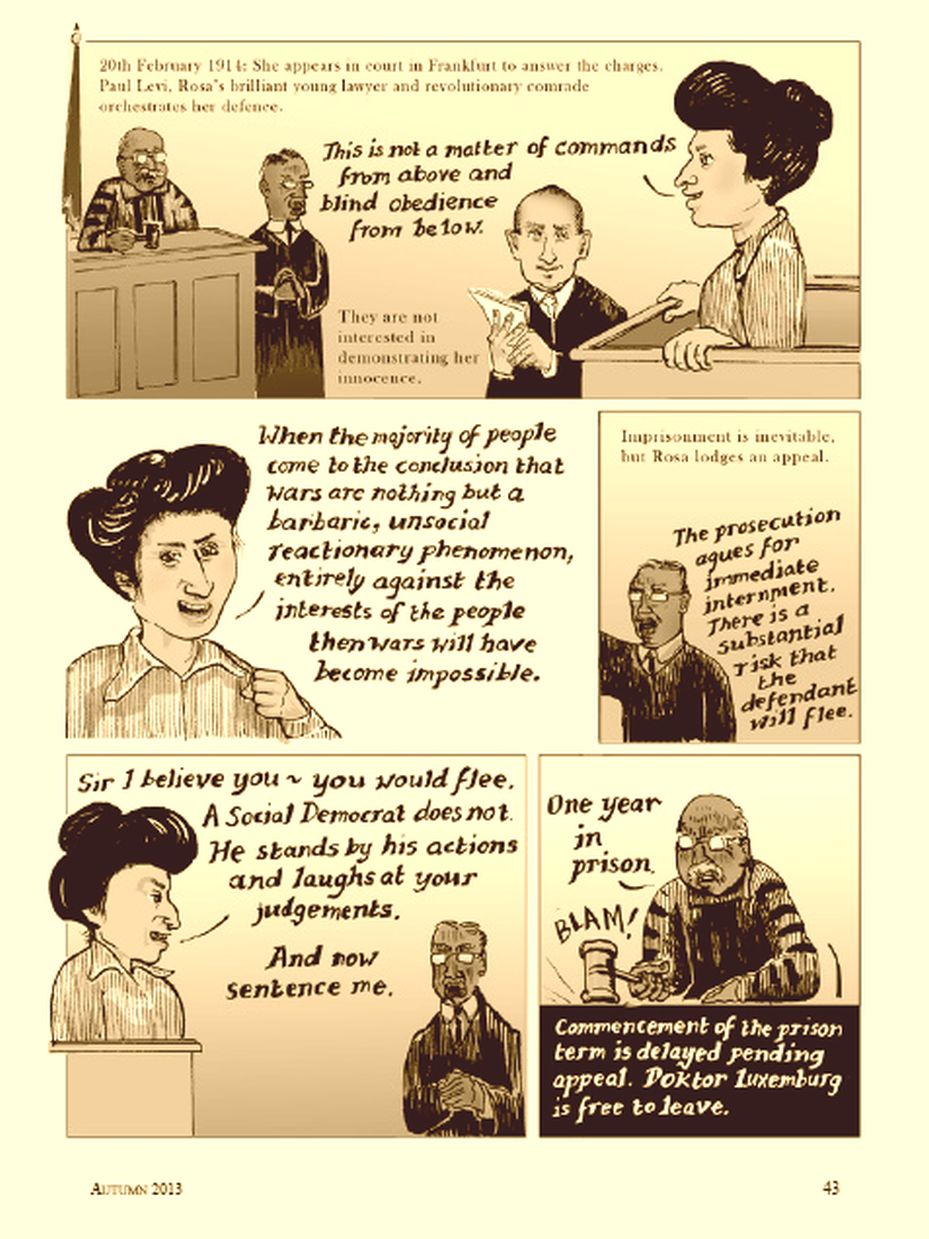
Comic Strip of Rosa Luxemburg

Comic Strip of Rosa Luxemburg

Comic Strip of Rosa Luxemburg

Comic Strip of Rosa Luxemburg from The Nation magazine

Comic Strip of Rosa Luxemburg from The Nation magazine

Comic Strip of Rosa Luxemburg

Cartoon of Rosa Luxemburg

Cartoon of Rosa Luxemburg

Cartoon of Rosa Luxemburg

Cartoon of Rosa Luxemburg
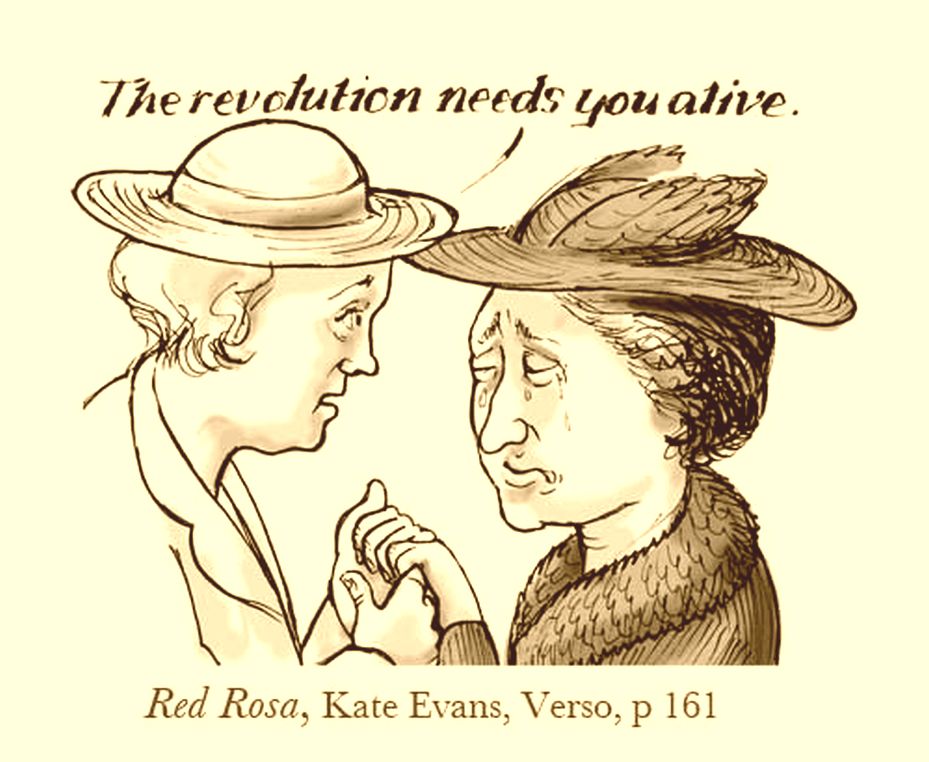
Cartoon of Rosa Luxemburg

Cartoon of Rosa Luxemburg

Cartoon of Rosa Luxemburg
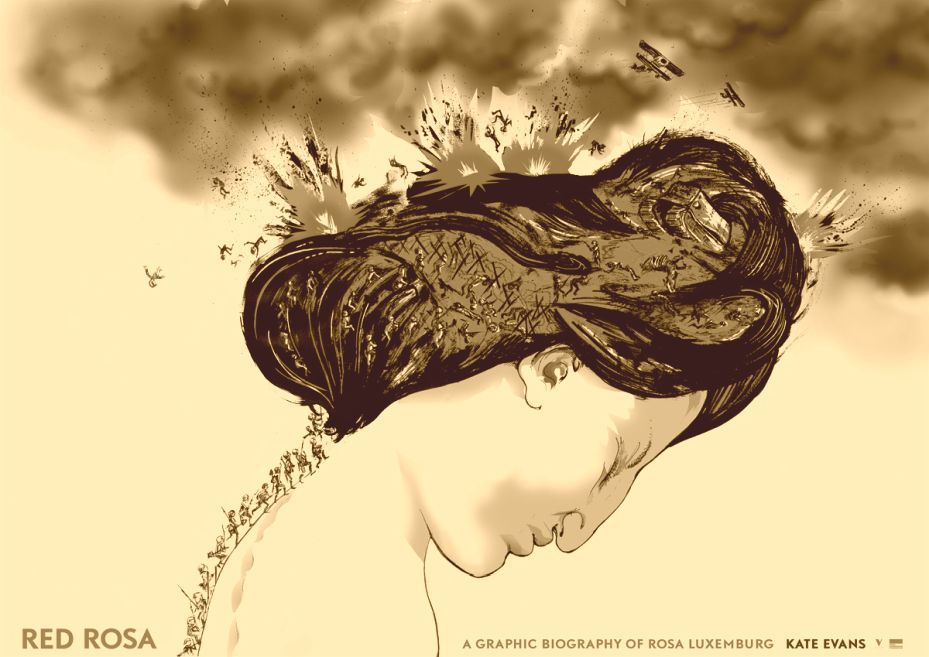
Cartoon of Rosa Luxemburg

Cartoon of Rosa Luxemburg

Cartoon of Rosa Luxemburg

Cartoon of Rosa Luxemburg

Caricature of Rosa Luxemburg

Caricature of Rosa Luxemburg

Caricature of Rosa Luxemburg

Caricature of Rosa Luxemburg
Caricature of Rosa Luxemburg (Click on the Image for the Original.)
Caricature of Rosa Luxemburg (Click on the Image for the Original.)
Caricature of Rosa Luxemburg (Click on the Image for the Original.)
Gruesome Caricature of Rosa Luxemburg with Bernie Sanders (Click on the Image for the Original.)
Return to the Page Menu.
 ז. Hẹʿrōṭ lə•Siyyūm
ז. Hẹʿrōṭ lə•Siyyūm
Creative Commons Portrait of of Rosa Luxemburg in Front of the former Hotel Eden, Berlin
We have now reached the end of this monograph. These concluding remarks (Hebrew, הֶערוֹת לְסִיּוּם [MP3], hẹʿrôṭ lə•siyyūm; or Arabic, مُلَاحَظَات الخِتَامِيَّة [MP3], mulāḥaẓāt ʾal•ẖitāmiyyaẗ), which are offered in lieu of a more formal conclusion, will round out my thoughts:
- My father’s Jewish name was Hẹʿrəšẹʿl hạ•Lēwiy bẹn Šəmūʾēl (Hebrew and Yiddish, הֶערְשֶׁעל הַלֵוִי בֶּן שְׁמוּאֵלָה [MP3]). Šəmūʾēl, Name of the Mighty One, is Samuel. Tentatively, my sister’s Jewish name is Šəmūʾēlāh hạ•Lēwiy bạṯ Hẹʿrəšẹʿl (Hebrew and Yiddish, שְׁמוּאֵלָה הַלֵוִי בַּת הֶערְשֶׁעל [MP3]). Bạṯ is daughter. Šəmūʾēlāh, as the feminized Šəmūʾēl, can be defined identically. Hẹʿrəšẹʿl is the only Yiddish word. The remaining words are in Hebrew.
- I can reject ethnocentrism (which I do), accept cultural relativism (which I do) and reject moral relativism (which I also do). In other words, by rejecting ethnocentrism, I reject that my own culture should provide some universal standard of the good. By accepting cultural relativism, I recognize that different cultures have their own moral codes, values, norms, and customs. However, by rejecting moral relativism, I accept that there is some universal standard of goodness (even if I do not fully understand it). That alternative to moral relativism is called moral realism. What the PoMos (postmodernists) of the 1970s and 1980s argued is that there is no universal standard of goodness (whether understood or not). PoMos commonly expressed that idea, following Jean–François Lyotard (MP3), 1924–1998, as a denial of metanarratives or universal truth statements. In other words, to, Lyotard, all truth, including moral truth, is relative. The problem with that view, which is why it has been increasingly rejected, is that moral relativism, and PoMo (postmodernism) in general, results in a kind of circular thinking. For instance, if truth is relative, then the statement, truth is relative, must be relative, too. You then end up with nihilism (nothingness). Therefore, many philosophers and theorists, over the few several decades, have been grappling with the subject and trying to come up with successful refutations of moral relativism. Numerous attempts have been made, and, sadly, some of them are mutually exclusive. That notwithstanding, most contemporary philosophers and social theorists are uncomfortable with the implications of moral relativism.
- Regarding anarchism, I question whether horizontalism is a workable social model. Whenever groups are formed, someone almost always becomes the leader and others the followers. Based on studies, leaders tend to be tall, light complexioned, good looking, eloquent, and charismatic. Obviously, none of those attributes is a good predictor of successful leadership. (Hitler immediately comes to mind.) However, if people try to prevent a leadership structure from being formed, they are also going against one of the core tenets of left anarchism: an absence of authoritarianism. In other words, left anarchists are inevitably trapped by the logical fallacy of petītiō prīncipiī (MP3), “an assumption made at the beginning,” also known as circular reasoning, circular logic, or begging the question. The problem is not vertical power. The problem is it abuse as authoritarianism or dictatorship. Therefore, my main issue with anarchism is its focus on horizontalism. I see domination, or oppressive power, to be problematic, including capitalism, imperialism, and Gramsci’s cultural hegemony. Power itself? Well, I have power over my students, but I am careful never to abuse it. When I was a student, in the ancient world, I had professors now and then who were oppressive. I vowed that I would never be like them, and I have stayed true to that vow. However, verticalism itself? I see no problem with it. Oppression can exist in both horizontal and vertical relationships. The problem is not verticalism versus horizontalism but the quality of one’s character. Personally, I am skeptical of any direct relationship between horizontalism and oppression. For instance, female bosses used to be routinely harassed by male subordinates. If she complained about it, her complaints were generally ignored. Certainly, there are times when making a social structure more horizontal could be beneficial. However, there are also cases in which horizontalism can lead to chaos and, as a result, oppression. For instance, there have been instances during my career in which I have dealt with students harassing other students (typically men harassing women or white folks harassing Black and Brown folks). If I did not have my vertical power, the oppression would have continued. However, because I have authority, I was able to deal with these situations. Sometimes the students were warned by the dean of students. In more serious situations, the students were expelled. In other words, verticalism can actually prevent oppression.
- NationStates founder Max Barry (born in 1973) rhetorically posed the question, “Is it [NationStates] a serious political thing, or just for fun?” He responded, “You can play it either way. NationStates does have [a] humorous bent, but that’s just because politics is naturally funny.”
- Marx and Engels vaguely talked about future communism, including statelessness, but they never elaborated. They were more concerned with the present. We should all, in my view, follow their example.
- IMO, Americans need to be prepared for the possibility, though not the inevitability, of the end of bourgeois democracy in 2024/2025.
- Unless strikes lead to the end of Empire, and of the intersectional capitalist world–system more generally, I see no point. Striking to receive more breadcrumbs from capitalists is a tragedy.
- There is no real separation between this world, the world of Guardian Angels (the Valley of Wonderment), and the Hereafter. Any imaginary separation is a sensory illusion. In my personal view, the Guardianship may have taken a different form; but that doesn’t mean that the Guardianship has ended. The beloved Guardian, Shoghi Effendi (Arabic, شَوْقِي أَفَنْدِيّ رَبَّانِيّ [MP3], Šaw°qī ⫯Afan°diyy Rabbāniyy; or Persian, شَوْقِی افَنْدِی رَبَّانِی [MP3], Šaw°qí ʾAfan°dí Rabbāní, “my desire/wish, master, lordlike”), is in the Kingdom guiding the Universal House of Justice. Given that he could not appoint a successor, he is still the Guardian. The Guardianship continues, and the Universal House of Justice is not divorced from its twin administrative Institution. He did not leave a will, since, especially given the unavailability of a second Guardian, Shoghi Effendi was not going anywhere. By neither having children nor writing a will, he was, in my view, providing a sign, inspired by God, of his continuing presence and the continuing Guardianship. Although the provision for additional Guardians was made by ‘Abdu’l–Bahá, there was, in my view, never any divine intention for future Guardians. The mechanism of primogeniture, incorporated into the Guardianship, was not intended to be used. Modalistically, both the Guardianship and the Universal House of Justice are, I believe, manifestations of their Essence, the Maiden—the Guardian Angel of the age and the Most Great Spirit (the Holy Spirit of Holy Spirits). The members of those overlapping Twin Institutions, husbands to the Maiden, are, therefore, men. If the Guardian were still in this world, he would be guiding the House of Justice on interpretive matters. So, how is it any different in the next world? The Guardian is the Head of the Universal House of Justice. Both are in the spiritual world. On the other hand, the members of the House of Justice are in this world. Any separation between this world and the realms of spirit is an illusion. From the next world, as I see it, the beloved Guardian guided the Hands of the Cause―the Chief Stewards―for six years to establish the Universal House of Justice and to exclude themselves from election to the body. He then became the Head of the Universal House of Justice, its unseated king, leading his Twin Institution from the next world. Officially, the Guardian is not one of the Central Figures of the Bahá’í Faith. I personally, however, regard him as such. Moreover, the beloved Universal House of Justice refers to Shoghi Effendi as the Guardian, not as the former Guardian. Retired members of the House of Justice, on the other hand, are “retired” or “deceased.”
- I would never speculate on the desires or intentions of evil people (or of anyone else for that matter), such as Joseph Stalin. All I can say is that state capitalism is neither socialism nor communism.
- Mercy isn’t the opposite of justice. Mercy is a part of justice.
- One does not need to refer to oneself as a sociologist (or a member of any other field) in order to be one. Ibn Khaldun (اِبْن خَلدُون [MP3], ʾIb°n H̱aldūn), 1332–1406, is a notable illustration. Rather, the only criterion for being a member of a field is that members of that field accept a person as a member (whether through informal acceptance or through licensure). In the case of Marx, he is widely accepted by sociologists as being a sociologist.
- The seed of the end of the Soviet Union was planted in Stalin’s “socialism in one country.”
- Like the majority of communists, I am not interested in elections. When many communist parties put forward a candidate, it is usually a part of a tactic called entryism. In other words, they are using the candidate, even though s/he generally has no ballot access in any U.S. state, as a method to attract people to the party. I am not opposed to entryism, in principle, but I think it needs to be recognized for what it is. Almost no communist realistically expects to win most elections. Those who have won a few local elections belong to social democratic parties—usually Trotskyist, such as Socialist Alternative (United States)—which are, to be blunt, communist in name only.
- The so–called “unbroken chain of transmission” from Moses to the Jewish oral law is referred to as səmiyḵāh (Hebrew, סְמִיכָה [MP3], “ordination”). It is a misunderstanding of the Eternal Covenant of God.
- The German–language question at the top center of Spartakusland’s flag, „Was will Spartakus?“ (MP3), translates as “What does Spartacus want?” Spartacus (Latin, Spārtacus [MP3]; or Ancient Greek/A̓rchaía Hellēniká, Σπᾰ́ρτᾰκος [MP3], Spắrtăkos, “Spartan”), a Roman gladiator who lived circa 110–71 B.C.E., was highly esteemed by Karl Marx.
- I figure out the Ḥuqūq in my heart, not in my head.
- The national currency is mišəqāl alternately transliterated mişĕqál (Hebrew, מִשְׁקָל [MP3]) or miṯ°qāl (Arabic, مِثْقَال [MP3]), weight.
- Based upon somewhat different rationales, both Max Stirner (German MP3; 1806–1856), né Johann Kaspar Schmidt (German MP3), and Ayn Rand (MP3; 1905–1982) or ʿẠyin Rāʾnəd (my Hebrew version, עַיִן רָאנְדּ [MP3]), née Alisa Zinovyevna Rosenbaum (Russian, Али́са Зиновьевна Розенбаум [MP3], Alísa Zinovʹevna Rozenbaum), denied the existence of human nature which, as a Bhaskarian critical realist, I consider to be a universal (Roy Bhaskar’s metaReality and the cosmic envelope), not a particular. ʿẠyin (Hebrew, עַיִן [MP3]) is the Hebrew letter, ע, Romanized as ʿ. It corresponds to ʿay°n (Arabic, عَيْن [MP3]), the Arabic letter, ع , which is likewise Romanized as ʿ. Stirner, for his part, focused principally upon the human ego. Sorrowfully, Rand, to the detriment of her own character, both glorified and exemplified the alleged virtue of selfishness.
- Identity politics, as an awareness of intersectionality, can be a beginning of conscientization, but it can never be the conclusion. That is to say, identity politics needs to be quickly abandoned for class consciousness. Before the revolution, communists should devote their energies to preparing for revolution. Reforms should occur in the context of struggling for revolution and, ultimately, engaging in a revolution. Without a revolutionary struggle, reforms are counter–revolutionary. However, in the context of revolution and preparing for revolution, reforms can draw people to communism.
- three types of excommunication: violation (Covenant–breaking), deprivation of membership, and deprivation of membership rights.
- And now, in October of 2019, the battle of Armageddon has begun. With the permission of Satan and the First Beast of the Book of Revelation (Donald J. Trump), Russia (Gog and Magog) has invaded Syria—along with Turkey—to massacre the beloved Kurds. God bless and protect them. This is the beginning of the final end. Why did Trump do so badly in the first presidential debate on September 20ᵗʰ, 2020? He is not planning for an election. He is planning a coup. It is something he has been telegraphing for months. Hopefully, he will fail.
- When the present–day order, the capitalist world–system, ends, the meek will inherit the Earth. The meek, it seems to me, are those in the far–flung corners of the world—the subaltern or Fourth–World poor, who will survive the coming catastrophes. With contemporary “civilization” thoroughly demolished, they will, with the force of a revolutionary struggle, build the new global order. The mission of the U.S., as the cradle of the administrative order, is over. Everything now is localism. The rest of us, living in the developed world, will be gone—sent to various levels of the great world beyond. Perhaps in the distant future, archaeologists will excavate the relics of that so–called civilization.
- There are prophecies of world peace, but nothing is guaranteed. G–d can change His Mind.
- Roy Bhaskar calls the confusion between ontology and epistemology the epistemic fallacy. According to Bhaskar, one of the major problems with modern philosophy is a failure to make a distinction between ontology and epistemology. Now, that said, I think that Immanuel Kant did understand the difference. However, it has often been glossed over by later philosophers. No philosophy is really a unity. Philosophers, as humans, generally make many intellectual turns throughout their lives. That was true with Kant. It was also true with Bhaskar. The early Marx was somewhat close to Hegel. yes. The later Marx, not so much. For instance, Capital and the Grundrisse show how far Marx had moved away from Hegel. Later on, Friedrich Engels was even moving toward an institutional approach to scientific socialism (wißenschaftlicher Sozialismus). The problem with Louis Althusser’s claim that materialism began with nominalism is that, among the scholastic theologians, Ockham was not a materialist. The goal of class politics is emancipation from capitalism and the capitalist world-system (Wallerstein). What is the goal of identity politics if not class politics?
- The proposed Green New Deal in the U.S. is a wonderful idea. However, climate change is one of the rotted fruits of capitalism. As Rosa Luxemburg argued, reform, including fighting climate change, cannot be disentangled from the revolutionary struggle against capitalism or, I would argue, the entire intersectional capitalist world–system.
- Everyone should become emancipated from capitalism, including capitalists, and become proletarians. The revolution, if we are fortunate enough to have one, would be against capitalism, not against capitalists as individuals.
- Many people on the right are attempting to commit suicide. The extent to which they are aware the not getting vaccinated is a type of suicide—or, at least, self–destructive behavior—is, I think, variable.
- Marx was a brilliant theorist but not a great “prophet.” (For instance, he predicted the end of capitalism in several European countries back in the 19ᵗʰ century.) Capitalism has survived largely do to the displacement of the Proletariat by the lumpenproletariat. In the U.S., for instance, most workers are lumpens. Until that changes, I doubt there will be a revolution. Who will fight it? At the same time that capitalism is collapsing, most workers have continued to support it.
- Israel is the modern–day internalized ghetto.
- Our greatest tests often come from our fellow believers. Severe mental or intellectual tests. That is persecution or martyrdom in the West. We will not likely be slaughtered or discriminated on the job en masse. Our martyrdom or persecution will come from other Bahá’ís. For me, as an Autistic, my martyrdom was, I believe, culminated in the Rio Grande Valley from two individuals () in McAllen, Texas. Previously, I was martyred by another Bahá’ís online (from Vermont), named Doug . Previously, I was martyred by another Bahá’ís from Starkville, Mississippi, named Gary . I prayed and prayed, shortly before leaving for Texas, that I would become a martyr. Although I did not realize it for months, my prayer was, in my opinion, fulfilled. Thank God. Thank the holy Maiden, the Most Great Spirit. I now want to enter the world beyond more than ever. To serve in the Supreme Concourse and in the Leaven would be such a blessing.
- Passing for me is a difficult exercise. I was diagnosed as an autistic when I was 6 years old. These days, as (arguably) an old man of 67, I present mostly as neurotypical (nonautistic). Almost no one would guess I am autistic. I have found that there are both positive and negative aspects of passing. On the more positive side, people relate to me as a normal guy. That was not my experience as a kid. On the more negative side, because I appear to be neurotypical, people expect me to behave neurotypically (nonautistically). Frequently, I do not. When I behave unusually, it is not a choice, in the usual sense. It is a neurological trait. Although, before my retirement, I generally passed in my classes as a “normal” professor, my autistic essence (or whatever you want to call it) was always there and would sometimes reveal itself. That situation has often made my life challenging. I am not an anticure person. I really want to be cured — especially when I remember the inner trauma of my childhood — and have difficulty relating to the neurodiversity or anticure position (although I respect it).
- A conspiracy theory is a notion which people accept in spite of the evidence. If people reject a notion, after evidence has been presented, it is not (at least for them) a conspiracy theory.
- In my opinion, adults should be permitted to marry as many other adults, of any gender, as they like. It should not be the business of a government to dictate the marital preferences of adults.
- Here is a proposed conlang, ʿĀlam•iš (universalish), in which an expanded Arabo–Perso is the script. All Arabic and Persian words are pronounced according to Modern Standard Arabic. The exceptions, Persian letters which do not have Arabic equivalents, are Č/č, Ž/ž, and P/p. English is also written using Arabo–Perso with the addition of Ǎ/ǎ (open a), E/e (short e), Ə/ə (the schwa), V/v, O/o (short o), Ō/ō (long o), Ǔ/ǔ (the English–language short “u,” as in “under”) Ȯ/ȯ (the au sound as in “auto”) and Ŋ/ŋ (ng). Thus, “the” would be written, ḏə. The grammar and syntax are taken from the English language. The plural uses the suffix •əz or, after a vowel, •z. Adjectives use the suffix •ik. The suffix Arabic –iyyaẗ is replaced by •iš; while the Arabic suffix –aẗ becomes •əs (as in “waitress,” “lioness,” “millionairess,” or “seamstress”). The ʿay°n is found in the English–language “uh oh!” (uʿ ō). The vocabulary includes all of the words in English as well as all of the basic Arabic and Persian nouns, adjectives, adverbs, and interjections (excluding Arabic and Persian word forms which are, instead, made through English). Arabic and Persian verbs, pronouns, conjunctions, and prepositions are not used. The emphasis is always on the final syllable.
- Our waking lives are a preparation for dreaming—the reality of this world. Dreaming is a preparation for, and the gateway to, the world to come.
- As to revolutionary terror: What’s wrong with revolutions provoking fear or terror? It happened in the American Revolution, the French Revolution, and so forth. Revolution is not evolution. Sudden or revolutionary change can be frightening.
- Concerning “real” communism: No one knows what real communism is. There is only the type of communism one desires. For me, it is communism from below. However, I would never say that communism from above was not real communism, only that it is different from the world I would like to see.
- Putin is evil. The Nazis are/were evil. Stalinists are also evil. However, I despise ranking evil. It can allow one to avoid pointing fingers at specific atrocities while placing all evil people and systems into some genocidal goo.
- We dealt with our family problems in different ways. You (an anonymous individual), by reconciliation. Me, by estrangement (becoming a stranger or an outsider). There is no way for me to know which was better. I also had a serious problem with my father. My desire was to run as far away as I could. I even considered leaving the country altogether, but I had no idea of where to go. Canada was too cold; and I had not yet visited the UK at the time. (Much later, I went there twice.) So, I moved south. I actually escaped to the South four times (Georgia, Mississippi, Appalachian Virginia, and the Rio Grande Valley of Texas)— running away from home in order to find it. I knew the South — several trips to South Carolina in high school. So, it seemed a logical place to go — and a warmer place to go. Now I am back home in the South (well, the South Central part of Texas) — the region of the country I originally ran away to — presumably for good. Given the happenstances of my life, I am beginning to feel at home once again.
- Yugoslavia might be the best example in the twentieth century of the first stage of communism, sometimes called socialism or the dictatorship of the Proletariat. Not only were businesses collectivized, but citizens were free to come and go as they pleased.
- A crisis was triggered by how one man treated me. Yes, he did treat me badly. OCD is not schizophrenia. Many people may now see why I took those “occultations,” borrowing the theological term, from reality. This old me with autism, OCD (especially), and generalized anxiety disorder is not a whole lot of fun. Better to hide, to minimize my activities to the bare minimum (my job), than to lose everything. I needed an occultation when I moved to south Texas. Unfortunately, given my retirement preparations, that was not possible. I thought Bahá’í activities would be helpful. That backfired badly. So, I just continued and stepped all over myself. Oh, well. Now, I am feeling pretty good, but the damage to some relationships is done.
- Invaders are people who try to turn indigenous lands into a commodity. Therefore, whether a pilgrim is an invader would depend on the behavior of the pilgrim. I do not believe in borders.
- Autism is one among many important identities to me. However, identities do not need to devolve into identity politics, like the autistic anti–cure movement.
- I think that we may reach a stage in the future where Covenant–breaking will no longer be an issue. In other words, Bahá’ís will have reached a sufficient level of maturity where they will be invulnerable to Covenant–breakers. If that happens, it will obviously only be the Universal House of Justice which could make the pronouncement. That would solve the problem of living in a Bahá’í society without an underclass of Covenant–breakers.
- In my view, Iran is the first beast of the Book of Revelation. The Empire is the second. It is led by the U.S. and Donald J. Trump. That Empire is symbolized by Jared Kushner’ number of the beast, as the owner of the office building at Manhattan’s 666 5ᵗʰ Avenue. Satan is the old world order. The false prophet is the Christian right, which supports two of the major actors within the second beast, Trump and Benjamin Netanyahu.
- The following are my edited replies to someone who tentatively defended aspects of Maoist Third Worldism: First, as a Bhaskarian critical realist, I am not what would be ordinary called an orthodox Marxist, as you mentioned. Critical realism, as a metatheory and a methodology, has, in my work, been useful as a reflexive approach to Marxism. However, I don’t see how Third Worldism contributes much to a critique of mainstream Marxism, including its philosophical idealism. One of the reasons Marxist communism has not taken root is because of its idealist turn (contradicting The German Ideology). Second, world–systems analysis (Immanuel Wallerstein) and dependency theory (especially, Paul A. Baran, Paul Marlor Sweezy, and John Bellamy Foster) both provide useful treatments of the relationships between the developed world and the developing world. There is a considerable academic literature in those areas. Although I have problems with dependency theory, but it, unlike Third Worldism, dependency theorists are rigorous. Maoist Third Worldism has been largely dismissed because it lacks coherence and, in my view, an isomorphism with reality. It is more of a rigid dogma than a theory. Third, Mao himself was not a Third Worldist. There isn’s a hint of Third Worldism his Little Red Book. Although I am not a Maoist, I honestly fail to see any connection between Third Worldism and Maoism. Finally, contrary to what you wrote, I said nothing about an undifferentiated Proletariat. I am, in part, an intersectional theorist, and I reject populist fads which dismiss it. The capitalist world–system should, in my view, be view through the lens of intersectionality. The differentiation of the Proletariat is one of my major interests. On the other hand, Third Worldists commonly reject the international Proletariat (advocated by Marx in the Communist Manifesto). They argue, without evidence, that only the Third World has revolutionary or dialectical potential. Where was the last successful revolution for a genuinely Marxist socialism from below in the Third World? Factually, no such revolution has ever occurred anywhere. Instead of finding the intersections which unite the Proletariat, Third Worldists look for imaginary mechanisms to divide it. As to Antonio Gramsci, he presented a cogent explanation, cultural hegemony, for why revolutions have failed to occur. From his prison cell, he laid the foundation for an approach which would challenge both autocrats and plutocrats from Mussolini to Trump. As U.S. President Trump feels increasingly cornered and threatened, he may become a threat to human survival. Obviously, as the source of severe mental tests and the upsetting of the world’s equilibrium, he has no problem caging people along the Mexico–U.S. border. I had engaged with the work of other Third Worldists before Unruhe. However, I suppose that Jason Unruhe’s knee–jerk right-wing authoritarianism (tacit support for Iran, Russia, and Turkey) put a bad taste in my mouth. Even so, I disliked the emphasis on the Third World even before watching Unruhe’s commentaries. I think it makes more sense to use the work of, for instance, Kimberlé Crenshaw or Patricia Hill Collins, two of the seminal figures in intersectional theory. As I see it, intersectionality develops a sophisticated, nuanced, multidimensional approach to the capitalist world-system (borrowing from Wallerstein) without falling into the dualism of developing vis–à–vis developed countries. Certainly, relative degrees of development can be considered as one axis (or, as I call it, a single intersectional thoroughfare) of the matrix of domination (Collins’ term), but there are many other axes as well. To me, Third Worldism gets caught up in a simplistic economism, which both Marx and, especially, Engels, were moving away from toward the ends of their careers. There is more to capitalism than development. I also think that the contrast between the core and the periphery, in the dependency theories, allows for greater sophistication than Third Worldism. To me, however, much of academic Marxism (of which I have been a part since 1978) has been so captivated by the Freudianism of the Frankfurt School and, more recently, the quasi-Lacanianism (poststructural Freudianism) of scholars such as Slavoj Žižek that I wonder if academic Marxism, to which I have been committed, is, at this point, even redeemable.
- For reasons unknown, people will often ask me about the odd subject of masturbation. I will agree to respond, but with the provision that I will only answer with a question and end the discussion: Does the Guardian make a big deal about it?
- My family of orientation (or origin) was extremely dysfunctional. Having two autistics in the same home (my father and myself) is never, to my knowledge, a success. (My mother was torn apart by the situation.) Both of us were later diagnosed with the condition. Hard feelings remained on my part. In late July of 2019, through the Guardian Angels, my parents visited me in the Valley of Wonderment (in a dream). They invited me to come with them. I accepted. I woke up, and all was forgiven. The Valley of Wonderment or world of dreams―the immediate reality within shell of the Earth―is our true home until we depart for the eternal habitation of light upon light. The Guardian Angels are our companions, and mediators, as we dream.
- American progressivism is a failed project for two major reasons: First, the base of the Democratic Party consists of African Americans. However, African American Democrats are, by and large, moderates, not progressives. Second, capitalism cannot be reformed. It must be demolished.
- An edited response to another message: Ontology and epistemology have various definitions. Ontologically, Immanuel Kant was an idealist. Epistemologically, he was a realist. Kant was the founder of modern philosophy which has, since his lifetime, been dominated by idealism. Marx’s major criticism of Hegel was that he turned the dialectic upside down. Marx claimed to correct Hegel’s error. It depends on whether one is referring to ontology or epistemology. Roy Bhaskar was an ontological realist and an epistemic relativist. As to nominalism, Roman Catholic Thomists or neo–Thomists have generally argued that Ockham’s razor, or nominalism as some define it, was the beginning of materialism. Of course, William of Ockham himself was not a materialist at all. I see identity politics as a means to an end: conscientization. An identity politics which is separated from conscientization can become counter–revolutionary.
- I have sometimes read other Marxists, on NationStates, argue against gun control. My question is: Where, in the writings of Marx or Engels (not later writers), is there any statement which would support this viewpoint? I have never seen one. Certainly, in a future hypothetical revolution, revolutionaries will presumably have weapons. However, there is no Marxist revolution in my country (the U.S.). Most people who own guns support the gun culture and are, generally, conservatives and, in some cases, on the far right. My own view is that no one should have guns now, including the police. Now, I realize that my proposal is unrealistic. However, I think that, as a dialectic or contradiction, it makes sense to express this perspective. Why? To counter the position of the National Rifle Association. That organization argued that everyone, including those with psychoses (such as paranoid schizophrenia), should be permitted to own guns. When the time arrives, as Marx and Engels argued in an address, revolutionary proletarians will be armed. In that same address, they contrast these revolutionary proletarians with the petty bourgeoisie (petite bourgeoisie): “The democratic petty bourgeois, far from wanting to transform the whole society in the interests of the revolutionary proletarians, only aspire to a change in social conditions which will make the existing society as tolerable and comfortable for themselves as possible.” In 1850, the year of that address, Marx and Engels were hopeful that all proletarians would become revolutionaries. They also expected, while union organizing in England, that revolution would begin in Europe in the 19ᵗʰ century. Their disappointment increased over time.
- Forgive my disagreement, but, IMO, you are ideologizing the sufferings of real human beings in Ukraine. Scientific socialism begins with empirical observation, not ideology. Is NATO a hegemonic organization? Obviously. Is Empire (the U.S.) just as evil, if not worse, than Russia? Yes. Is the reaction against Russian atrocities solely a reaction by NATO? No. The reaction is almost universal. This situation appears to be moving in the direction of genocide. We need to focus on the facts on the ground, not on ideology (my YouTube posting).
- Defund the police is to eliminate the police. At the same time, local communities can establish locally accountable, democratically elected members of boards of servitude who could be fired at any point in time. Once the community fires a “servant,” s/he could not appeal it and would be unable to become a “servant” anywhere.
- The liberty of thieves means the robbing of their victims. The liberty of capitalists means the robbing of the proletariat. I support the liberty of the subaltern.
- Communism is not dualistic. Class struggle is a way of eliminating the dualism of capitalism: capitalists versus workers. The point of class struggle is to eliminate social classes, not to perpetuate them. In other words, the objective of a communist revolution isn’t to reach an accommodation with capitalism. The idea is to destroy the capitalist world–system and to replace it with a superior system. One of the major threats of today, at least in the U.S., comes from nativists who are attempting to curb immigration. The fuel of revolution might come from the Black and Brown people who immigrate to the U.S.
- To Roy Bhaskar, morality is real. He was, like myself, a moral realist, not a moral relativist. Communism and anything which promotes freedom from oppression are moral. Capitalism and the various oppressions are immoral and demireal (real illusions). He carefully established an ethical basis for libertarian Marxist communism. Under that libertarian communism, the true freedom of eudaimonia (Ancient Greek, εὐδαιμονία [MP3], eu̓daimonía, “good fortune” or, rather loosely, flourishing), in its perfection, can be realized.
- As a critical realist, I want to see as many people emancipated as possible, including capitalists. The major way for them to become emancipated is by renouncing capitalism, just like Ebenezer Scrooge in A Christmas Carol. From his own personal experiences, Dickens explained in his own words that he hated capitalists.
- Truth is not determined by numbers; and revolution is not a struggle for ideas.
- I am an abortion rights absolutist. Saying that no one should have an abortion simply because she wants one and abortion should be decided between the women and her physician are the same thing. The woman consults with her physician. She doesn’t do it on her own. That latter would be equivalent to a public toilet abortion.
- As to abortion, the Universal House of Justice said that no one should be able to have an abortion simply because she wants to have one. Further, that life (not necessarily personhood) begins at conception. Personhood may begin at birth. As further eludicated by the Universal House of Justice, abortion is a matter between the mother and her physician. Thus, a third party is brought in: not just the mother but a physician. Abortion is not murder per se, nothwithstanding the reactionary views of many evangelicals and fundamentalists. Rather, the procedure may take place for any number of reasons (rape, incest, a threat to the life of the mother, emotional trauma, and so forth). Of course, such elucations can be changed or expanded.
- We have the Divine Plan, established by the Master, and we have the applications of that Divine Plan in individual plans. Does a new plan mean that we need to abandon whar worked for someone in the past and entirely switch gears? I don’s think so. We might, however, want to find a way to relate our previous activity to the new plan. The plans are not hard–and–fast rules but guidelines. There is no rigidity in the Divine Plan or its implementation.
- Let the dead bury their dead = Let the spiritually dead associate with the spiritually dead = Fellowship with the ungodly increaseth sorrow
- One of the biggest fallacies concerns the Ukrainian military. For instance: How could Ukraine have done so well in relation to Russia? It seems impossible. Yes, it seems impossible because it is impossible. NATO (including U.S.) troops have been in Ukraine almost since the war started. Russia is primarily fighting the U.S., not Ukraine. Russia would have won a war against Ukraine in days or even hours. Winning a war against the U.S. is a different matter. It is an open secret to everyone except the general public. However, NATO troops are in Ukraine to deter Russian expansionism; not, as erroneously claimed by Vladimir Putin, to attack Russia. I wish that the Western media would get a spine and begin discussing the subject.
- As a tenured full professor of sociology, I focus, first, on religious studies, especially Ṭarīqaẗ ʾal•Qād°riyyaẗ ʾal•Sar°wariyyaẗ (Perso–Arabic, طَرِيقَة القَادْرِيَّة السَرْوَرِيَّة [MP3], “Path of the Competence of Mastery”) of Ḥaḍ°rat Sul°ṭān Bāhū (Perso–Arabic, حَضْرَت سُلْطَان بَاهُو [MP3]), and, second, on critical social theory, critical metatheory, and Marxist methodology, including the critical metatheory, critical social theory, and Marxist methodology of critical realism; the critical social theory of intersectionality; and, to some extent, the theoretically grounded Marxist methodology of world–systems analysis.
- Perhaps now is the time.… ¡Viva la revolución! (Spanish [MP3]), Vive la révolution! (French [MP3]), Viva la rivoluzione! (Italian [MP3]), Viva a revolução! (Portugese [MP3]), Visca la revolució! (Catalan/Català [MP3]), Viu in rivuluzione! (Corsican/Corsu [MP3]), Long live the revolution! (English), Lang leve de revolutie! (Dutch [MP3]), Lang lebe die Revolution! (German [MP3]), Lank leef die rewolusie! (Afrikaans [MP3]), Lang libje de revolúsje! (Frisian [MP3]), Længe leve revolutionen! (Danish [MP3]), Långt leva revolutionen! (Swedish [MP3]), Lang lev revolusjonen! (Norwegian [MP3]), Taḥ°yā ʾal•ṯaw°raẗ! (Arabic, تَحْيَا الثَوْرَة! [MP3]), Yəḥiy hạ•mạhəpēḵāh! (Hebrew, יְחִי הַמַהְפֵּכָה! [MP3]), Zin°dih•i bād•i ʾin°qalāb! (Persian, زِنْدِهِ بَادِ اِنْقَلَاب! [MP3]), ʾUv°ẓ̌°d ʾin°qalāb ž°vin°daý daý! (Pashto, اُوْږْد اِنْقَلَاب ژْوِنْدَی دَی! [MP3]), Ḱ°rān°tí lam°bē samaýah taḱa rahū! (Urdu, کْرَانْتِی لَمْبَے سَمَیَہ تَکَ رَہُو! [MP3]), Krāṃti laṃbe samaya taka raho! (Hindi, क्रांति लंबे समय तक रहो! [MP3]), Lame cira kranti vica jiꞌo! (Guramukhi Punjabi ਲੰਮੇ ਚਿਰ ਕ੍ਰਾਂਤੀ ਵਿਚ ਜੀਓ! [MP3]), Lamē čira ḱ°ran°tí vičča ǧiýū! (Shahmukhi Punjabi, لَمَے چِرَ کْرَنْتِی وِچَّ جِیُو! [MP3]), Eläköön vallankumous! (Finnish [MP3]), Revolūtiō vīvat! (Latin, [MP3]), Zḗtō ē epanástasē! (Modern Greek, Ζήτω η επανάσταση! [MP3]), 🙵 Waɗā ʾin°qalāb rahan°dā! (Sindhi, وڏا اِنْقَلَاب رَهَنْدَا! [MP3])
Return to the Page Menu.
Ššālôm ʿălēyəḵẹm (Hebrew, שָּׁלוֹם עֲלֵיְכֶם), ssalāmu ʿalay°kum (Arabic, سَّلَامُ عَلَيْكُم), sälamə läʾə•nanətä (Geꞌez/Gəʾəzə 𑁣 Amharic, ሰላም ለእናንተ), salām bah šumā (Persian, سَلَام بَه شُمَا), ʾâpa kū salāma (Urdu, آپَ کُو سَلَامَ) ﬩ āpa ko salāma (Hindi, आप को सलाम),
tuhāḍē la⫯yí salāma (Shahmukhi Punjabi, تُہَاڈے لَئِی سَلَامَ), tuhāḍē laꞌī salāma (Guramukhi Punjabi, ਤੁਹਾਡੇ ਲਈ ਸਲਾਮ), salāmūnā (Pashto ⨁ Sindhi, سَلَامُونَا ⨁ Urdu, سَلَامُونَا), taw°hān tay salām (Sindhi, تَوْهَان تَي سَلَام), šlamaʾ ʿlūk (Syriac, ܫܠܲܡܲܐ ʿܠܼܘܟ), sàlāmǔgěinǐ (Mandarin Chinese, 萨拉姆给你), anata•ni•sarāmu (Japanese, あなたにサラーム), sliem għalikom (Maltese), salam a yu (Lingwa de Planeta/Lidepla/LdP), selamun aleyküm (Turkish), tōmāra sālāma (Bengali, তোমার সালাম), salam sejahtera (Malay/Melayu), salom bar šumo (Tajik, Салом бар шумо), salam bagimu (Indonesian), sizə salam olsun (Azerbaijani), asalaamu calaykum (Somali), salam kwako (Swahili), salutations to the comrades, 

 ,
,


 ,
,




|

|

|

This site has been published through The MarkFoster.NETwork™.
Copyright © 2017– Mark A. Foster, Ph.D. All rights reserved.
Mōšẹh ʾẠhărōn hạ•Lēwiy bẹn Hẹʿrəšẹʿl is Foster’s communist name.
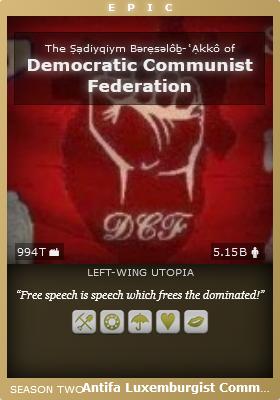
|

|

|

|
|



























